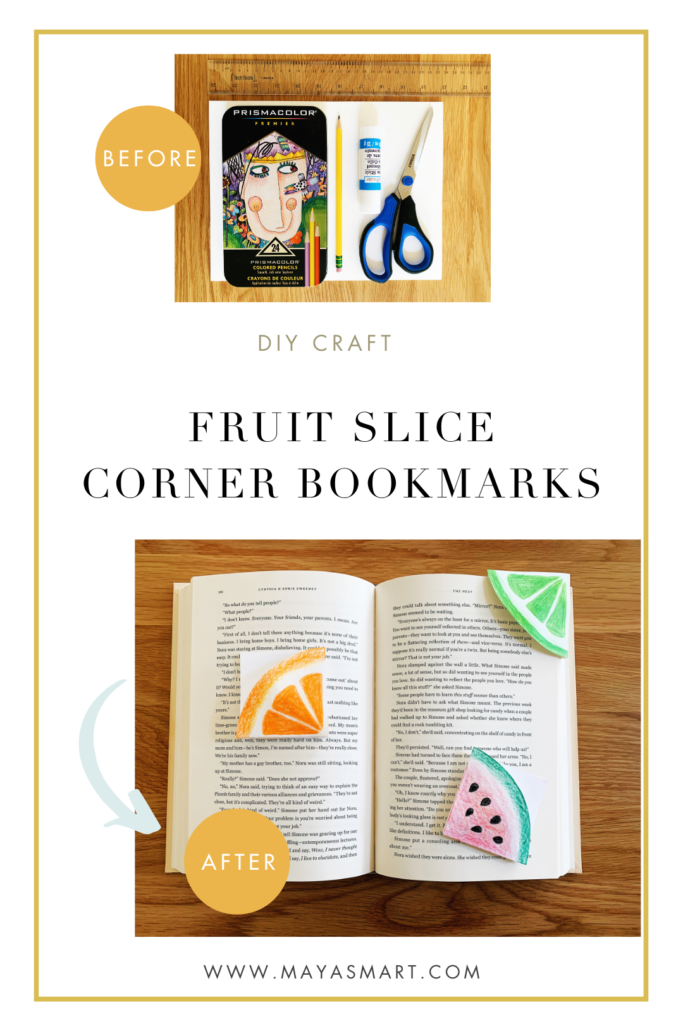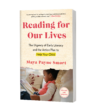As lovers of literature, tossing books into the recycling bin can feel almost sacrilegious (even that dog-eared paperback that’s lost half its pages). And the nature-lovers in us rebel at the idea of crafting and decorating with brand-new paper when stacks of books and magazines are tossed every day. That’s why we celebrate the idea of giving unsalvageable and obsolete books a second life by upcycling them into book-page crafts.
Creating decorative and useful objects out of old book pages is a beautiful way to share our love of the written word and create a literacy-rich environment for kids—all while saving some trees. It’s also a fun, affordable, and eco-friendly way to deck the halls for special events. So we decided to share seven of our favorite DIY book-page crafts. These are fun activities for all ages that you can do for or with children. Just click the links for tutorials with easy, step-by-step instructions, illustrated with photos of each step.
Tip: Cutting up a book can feel wrong, we know. Choose outdated law, science, or medical texts and irreparably damaged books of all kinds for guilt-free upcycling. Used or outdated workbooks are also great candidates for book-page crafts (for example, check out the last project in this post).
Making your own streamers and decorations out of recycled paper is a beautiful way to keep birthday parties and other happenings eco-friendly. This DIY pinwheel banner upcycles book pages to create some lit-themed decor for your next event or photo shoot. Create an elegant black-and-white look with plain-text pages and white ribbon, or add some festive color with bright ribbon or illustrated pages (obsolete encyclopedias and nature guides can be great sources).
Cooling down on a hot day has never been cuter! Kids will love this craft to create their own personal fans. These sweet book-page fans are easy to make and fun to use. You can keep them simple or get as detailed as you want in coloring and decorating them. Get creative with stickers, glitter, or whatever else you have on hand. You could even glue feathers along the top of your fan! Store finished fans in a vase as a crafty centerpiece, ready for hot weather, or take them along to keep kids (or yourself!) comfortable on outings. A literary way to keep your cool!
You can string these pretty origami butterflies along a garland, sprinkle them over a table or shelf-top, or perch them in a houseplant or festive tree. What a fun way to celebrate nature and reading! This DIY book-page craft is easy once you get the hang of the folding, and a fun project to do with kids. Our post breaks down the folding into easy-to-follow steps, with pictures of each step. So go ahead and get crafting!
When kids aren’t together, sending hand-written notes is a great way to stay connected, not to mention lots of fun for both sender and receiver. Writing good, old-fashioned letters is also the perfect literacy activity for children—the kind they don’t even notice is educational. And this DIY book craft to make miniature origami envelopes will motivate little and not-so-little penpals alike. They also make adorable holders for invitations, thank you cards, or cards to mark a special occasion.
Looking for a creative way to decorate? From book club to birthday celebrations, you can customize this book-page banner for any holiday or theme. It’s easy to make and kids can dive right into this craft. Have them spell out their name on the banner and hang it in their room, or make one to celebrate a relative, friend, or favorite teacher. Great for a special event or to give your daily spaces a fun facelift.
This cute twist on the classic apple-for-the-teacher theme creates a decorative apple from upcycled book pages. Help kids make them as teacher appreciation gifts, or to decorate their desk at home. You could even scale down the size and turn them into ornaments that can hang along a garland or off a tree. This DIY book craft is inexpensive and fun!
Got a pile of filled-in workbooks headed for the bin? With this kid-friendly DIY book craft, you can upcycle them into a beautiful woven basket instead. Use it for decoration, or as a new place to gather office clutter. What better way to organize a student’s home workstation? Kids will be proud to see their hard work put to use to create an eco-friendly study space—ready for their next learning endeavors!
By Chrysta Naron
Sandpaper letters are a popular Montessori material and a wonderful tool for helping young children master their ABCs. These letters cut from sandpaper and mounted on solid backgrounds allow children to experience the alphabet in multiple ways—before they have the fine motor skills to write the letters themselves. They can see how the letters are formed, and feel them as they trace their shapes. This sensory element can help them retain the names, shapes, and sounds of letters.
Pre-made sandpaper letters can run a little expensive, though. So why not make an activity of helping kids make their own sandpaper letters? Learning their ABCs is more fun and more memorable when they’re involved in the process from start to finish. Inviting your child to help create the letters reinforces their alphabet recognition, allows them to feel a sense of agency in their learning, and gives you quality time with your child. What a fun way to introduce this great pre-literacy activity while indulging in a little controlled mess!
Note: This activity can be adapted for kids with sensory processing sensitivity. See ideas at the end of the post.
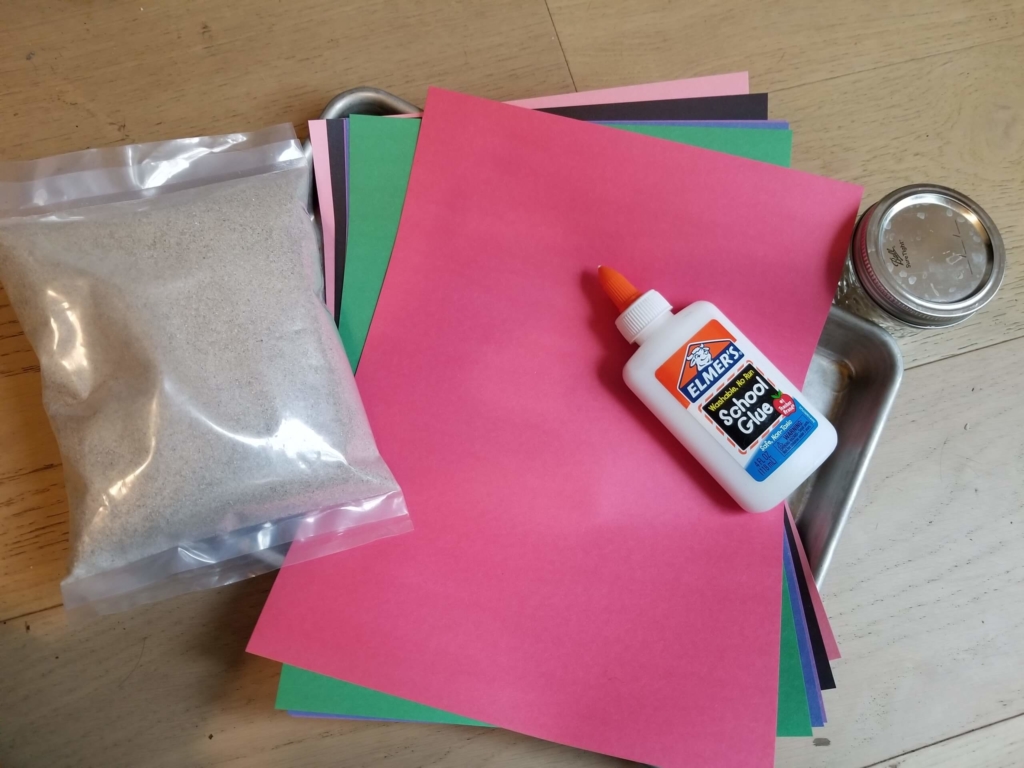
Materials Needed:
- Construction paper/Cardstock
- Liquid glue
- Small bowl
- Paintbrush
- Sand (or other material; see suggestions at end of post)
- Cookie sheet
Cost: This activity mostly uses things you probably already have around the house. A five-pound bag of sand costs around $16, but feel free to improvise with some of the alternatives I mention below if you don’t want to buy the sand.
Step 1: Pour the liquid glue into the bowl. Dip your paintbrush into the glue and paint a letter of your choice onto a sheet of paper, taking up as much of the paper as possible. I recommend starting with the first letter of your child’s name. It’s recognizable and children are so excited to participate in activities that are specific to them.
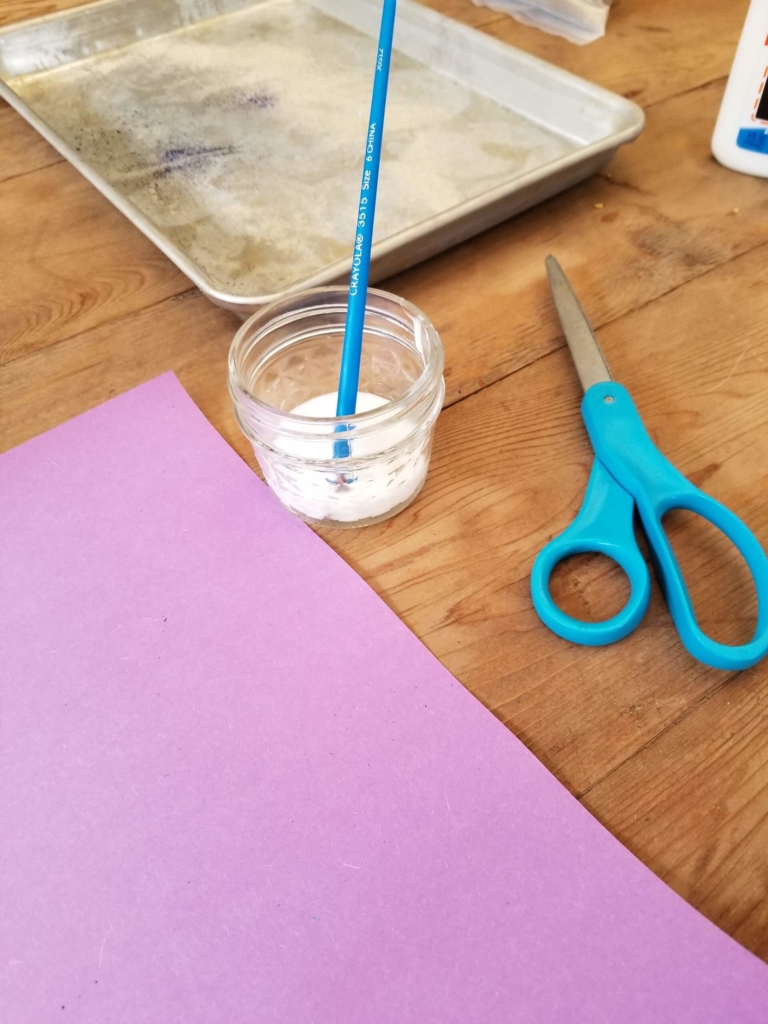
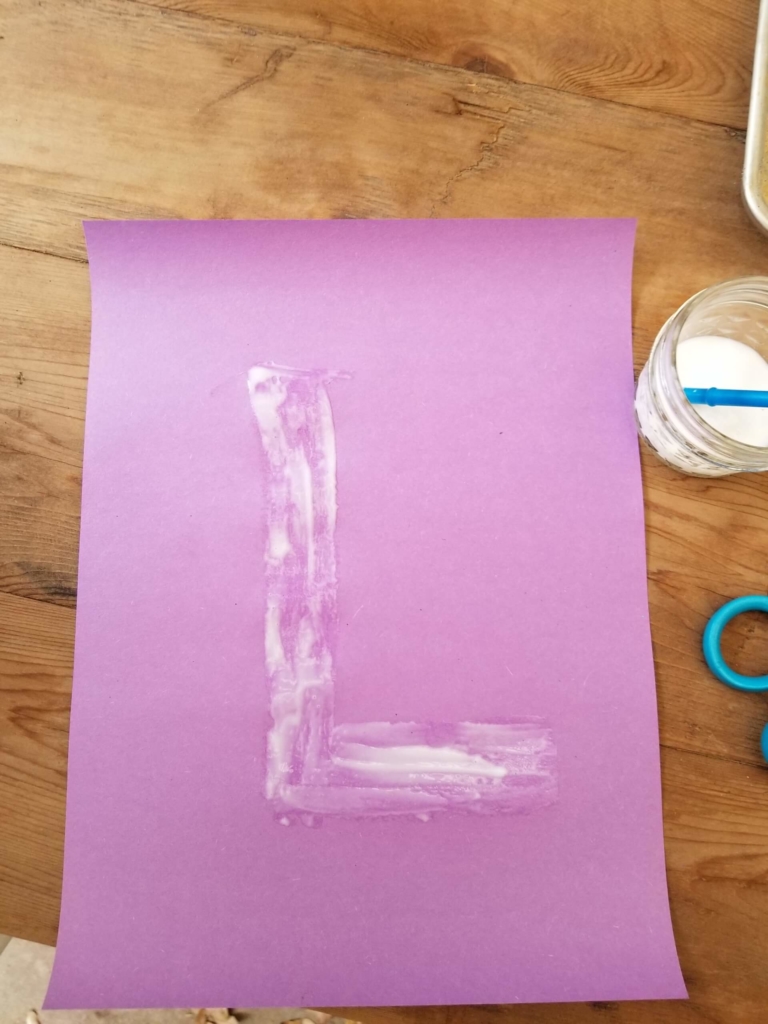
Step 2: Place the paper on a cookie sheet. Have your child pour or sprinkle sand over the glue. Let them dump as much sand onto the paper as they want—the letter should have plenty of texture and be very visible.
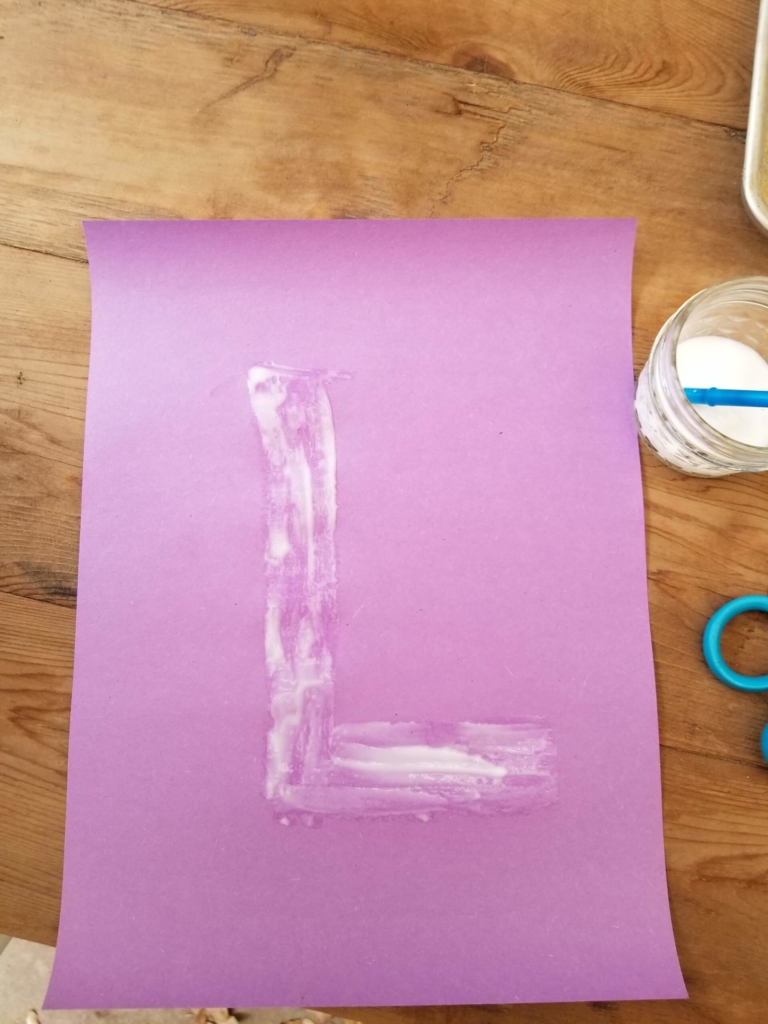

Step 3: Let your child pick up the paper and gently shake the excess sand onto the cookie sheet. Wow! Look at that letter!
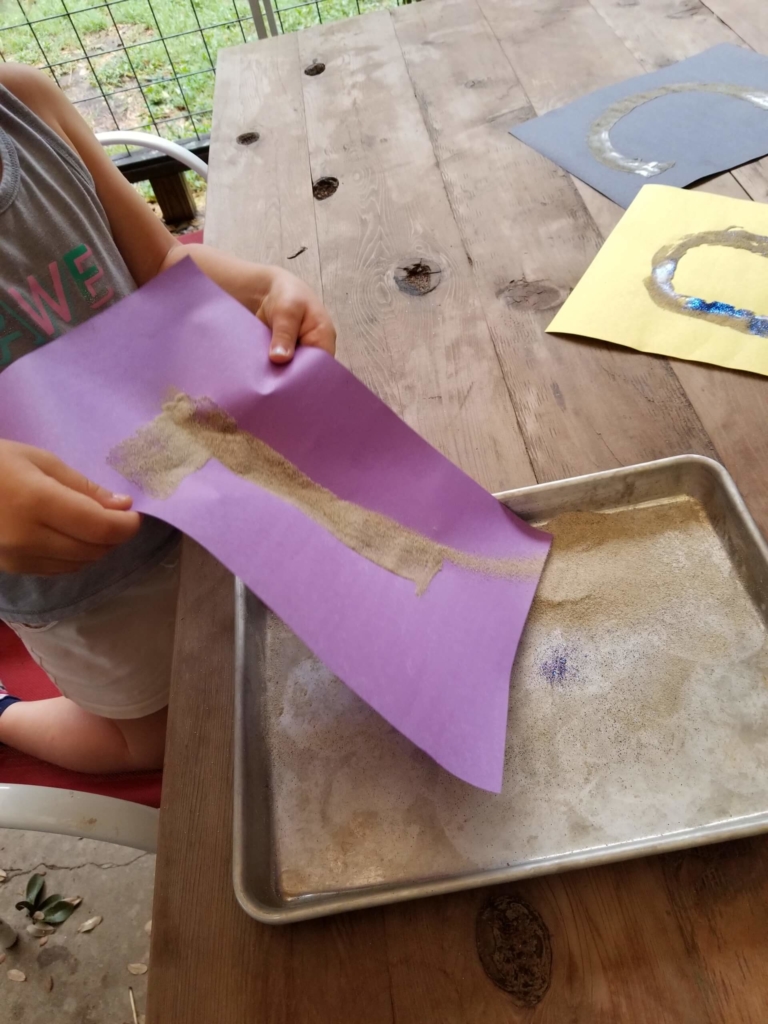
Step 4: Set the letter aside to dry. Repeat the activity with as many letters as you want. Spell out the rest of your child’s name or the name of a pet. High-frequency letters, such as A, B, and C, and distinctive-looking letters like O and X are also great choices.
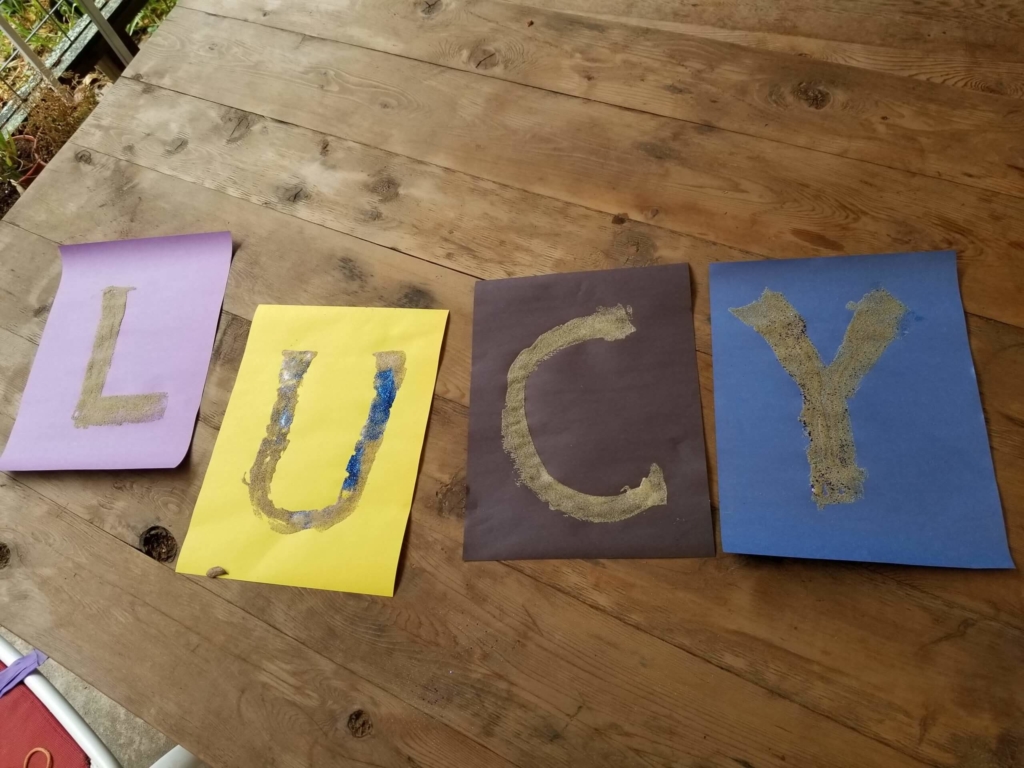
Step 5: Once the letters are dry, sit with your child and help them trace the letters with their finger or palm. If you made the necessary letters, rearrange them to spell words or names.
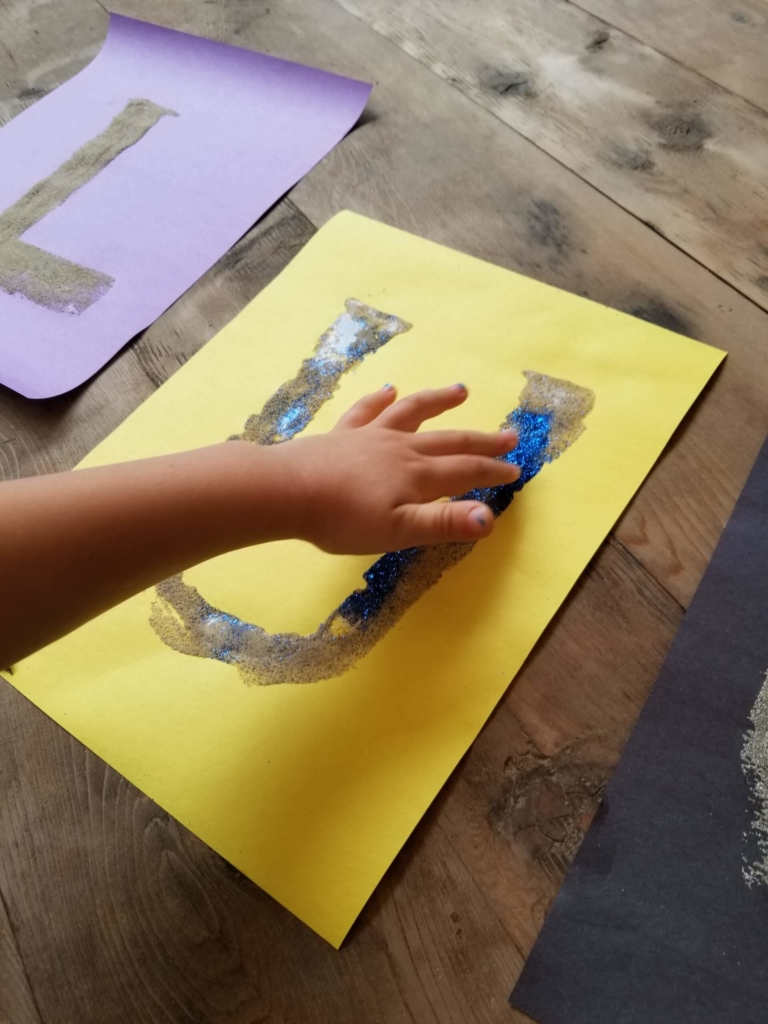
Alternatives to sand: If you don’t have sand, or your child doesn’t like the feel of sand, you can substitute the sand with other dry items, such as rice, cornmeal, or even dirt. Just make sure it has some texture to it. These letters can reflect your family and the interests of your child. Full confession: I love glitter, so I typically mix glitter in with the sand. It’s just so sparkly!
By Karen Williams
Looking for a resource to help your child to get more out of reading at home?
Give FlipGrid a try. It’s an educational platform that allows educators to post a written or recorded prompt and learners to create short, shared videos in response. FlipGrid is used in PreK to PhD classrooms around the world as a popular tool for social learning.
FlipGrid isn’t just for teachers, though. As a parent, you are your child’s first and most important educator. You can use FlipGrid at home to help your child take a deeper dive into books. Just register for a free account, download the app, and create your “grid,” or learning community. Then you can post topics and prompts or use the app’s suggestions available in its Disco Library. FlipGrid integrates well with other parent reading resources with plug and play features, such as Wonderopolis, Epic!, MSN Kids, and more.
The combination of self-recording and sharing gives FlipGrid unique power to engage quiet introverts and social butterflies alike. Some children like the flexibility to record on their own time in their own way. Others enjoy addressing an imagined audience and bring a different persona or depth of response to their recordings than they do in everyday conversation.
Five Ways to use FlipGrid to Help Kids Get More Out of Books
Get creative with FlipGrid to spark a relationship with reading and to build up vocabulary, fluency, and comprehension skills.
Here are a few suggestions:
- Help your child create a book club or challenge with FlipGrid. Have them invite their friends or family members to join their book group “grid,” read a selected book, post a video review, and pose open-ended questions about the text. Watching and responding to each other’s videos makes reading a social experience for participants near and far. This activity uses FlipGrid’s video interaction capabilities to build lifelong habits of strong readers—reflecting on and discussing a book’s meaning with others.
- Encourage your child to log new vocabulary words by performing a skit depicting the word’s meaning and contrasting it with words with similar and/or opposite meanings. For example, to illustrate the word tranquil they might act out a quiet night at home watching the stars. Your child can compile a video “dictionary” to share with others or build a shared dictionary with friends on FlipGrid. This activity prompts deeper engagement and better retention than simply reciting definitions or using the word in a sentence.
- For a quiet-time activity, ask your child to record themselves reading aloud on FlipGrid. They can practice reading with expression and feeling and then get immediate feedback by listening to the recording, or re-record the same story multiple times to document improvement in fluency or expression. Children will love using props or other materials to introduce new characters, settings, and plot points; they can even make different “scenes” through use of multiple recordings in the same grid.
- Challenge your child to use their skills to make the book come alive! Maybe they can create a cooking demonstration video (in a real or play kitchen, depending on your child’s age) featuring a recipe inspired by the book. What about a tutorial explaining how to do something featured in the book? Can they record themselves making a DIY craft related to the story? (Check out this post for how to make DIY bookmarks with supplies you have at home.)
- Your child can explore a new topic inspired by the reading material—and invite further exploration from others. If the main character plays the guitar, your child could research the instrument, record a short video about what they’ve learned, and invite family to contribute videos of what they know about guitars. They could explore a hobby that piques interest or talk about an animal they’ve learned more about. The possibilities are endless!
Better yet, ask your child for ideas on how they can creatively use FlipGrid based on the story. You might be surprised with what they come up with!
The Bottom Line for Learners
FlipGrid is designed specifically to empower and amplify student voices. In education, student voice means students are able to express their perspectives, thoughts, and concerns about their educational experiences inside and outside of school. Student voice also means a learner’s cultural background and life experiences are acknowledged. These concepts are important, both at school and at home, because they help students feel heard and engaged with respect to the subject at hand, and therefore invested in their own learning. With FlipGrid, students can respond to reading not just by answering comprehension questions but by sharing their voice, refining their thoughts, and respecting the diverse voices of others.
Do you think you’ll give FlipGrid a try? Why or why not?
Doing workbooks at home with kids is a great way to bolster their literacy or math skills, bridge the gap between grades, or keep them engaged during school breaks. But it doesn’t take much diligent work (or coloring fun!) before you’re left with a stack of filled-in workbooks headed for the recycling bin. So why not go a step better than recycling and upcycle them instead?
In this kid-friendly DIY book craft, you’ll take a workbook or coloring book (or even a newspaper) and transform the pages into a beautiful woven basket. Use it for decoration, or as a new place to gather office clutter. What better way to organize a student’s home workstation? Kids will be proud to see their hard work put to use to create an eco-friendly study space—ready for their next learning endeavors!

Materials:
- Old workbooks, or you can use a newspaper
- Scissors
- Glue stick
- 1 paper clip
Cost: Because it requires very minimal materials, this craft should not need to cost you anything. It is the perfect opportunity to upcycle old workbook pages and create your own basket instead of going out and buying one.
Step one: The first step is to cut the strips that you’ll be weaving together to make your basket. (The larger your workbook, the easier it will be to weave.) Cut a full page in half lengthwise, so you get two strips from each page. Repeat until you have 12 strips, cut from six pages of the workbook.

Step two: Taking one strip at a time, fold one side of the paper one-third of the way widthwise and crease it firmly. Run the glue stick down the full length of the paper and fold it over again, pressing this piece down well. Your strip should now be one-third its original width and glued together.

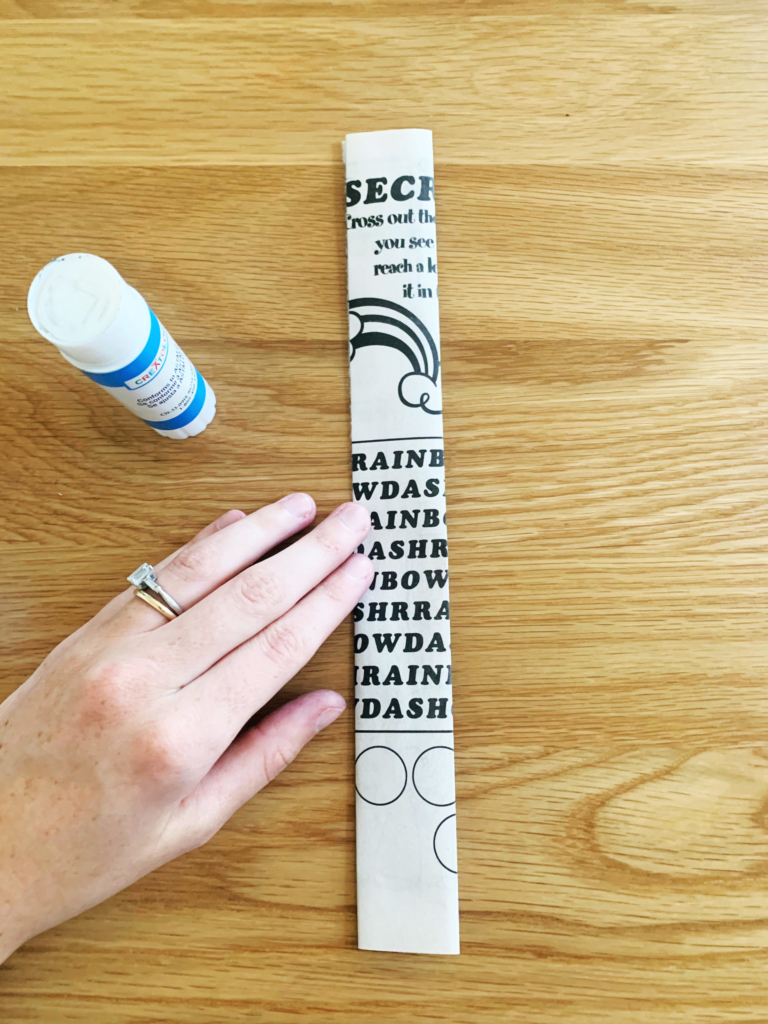
Step three: Now, run the glue stick along the side of the strip and fold it in half again, pressing down and creasing well. The strip should now be one-sixth the width of its original size. Repeat the whole process until you have 16 long, thin strips.
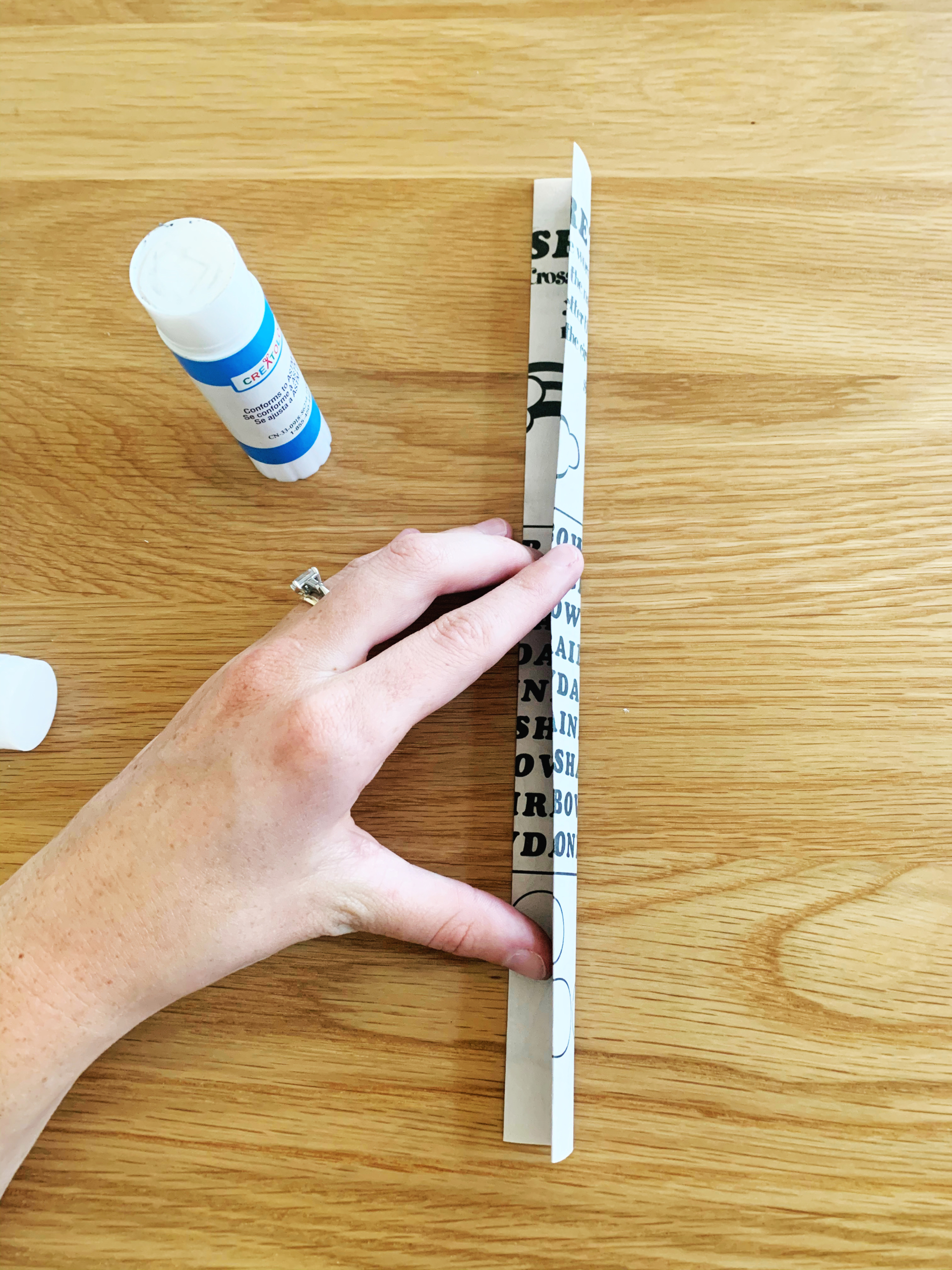

Step four: Now it’s time to construct your basket with the strips you just made. To start, place four strips vertically on the table next to each other. Taking four more strips, weave each horizontally through the strips on the table, one by one, going over and under the vertical strips. Important: Each new strip should follow the opposite path of the one above it.

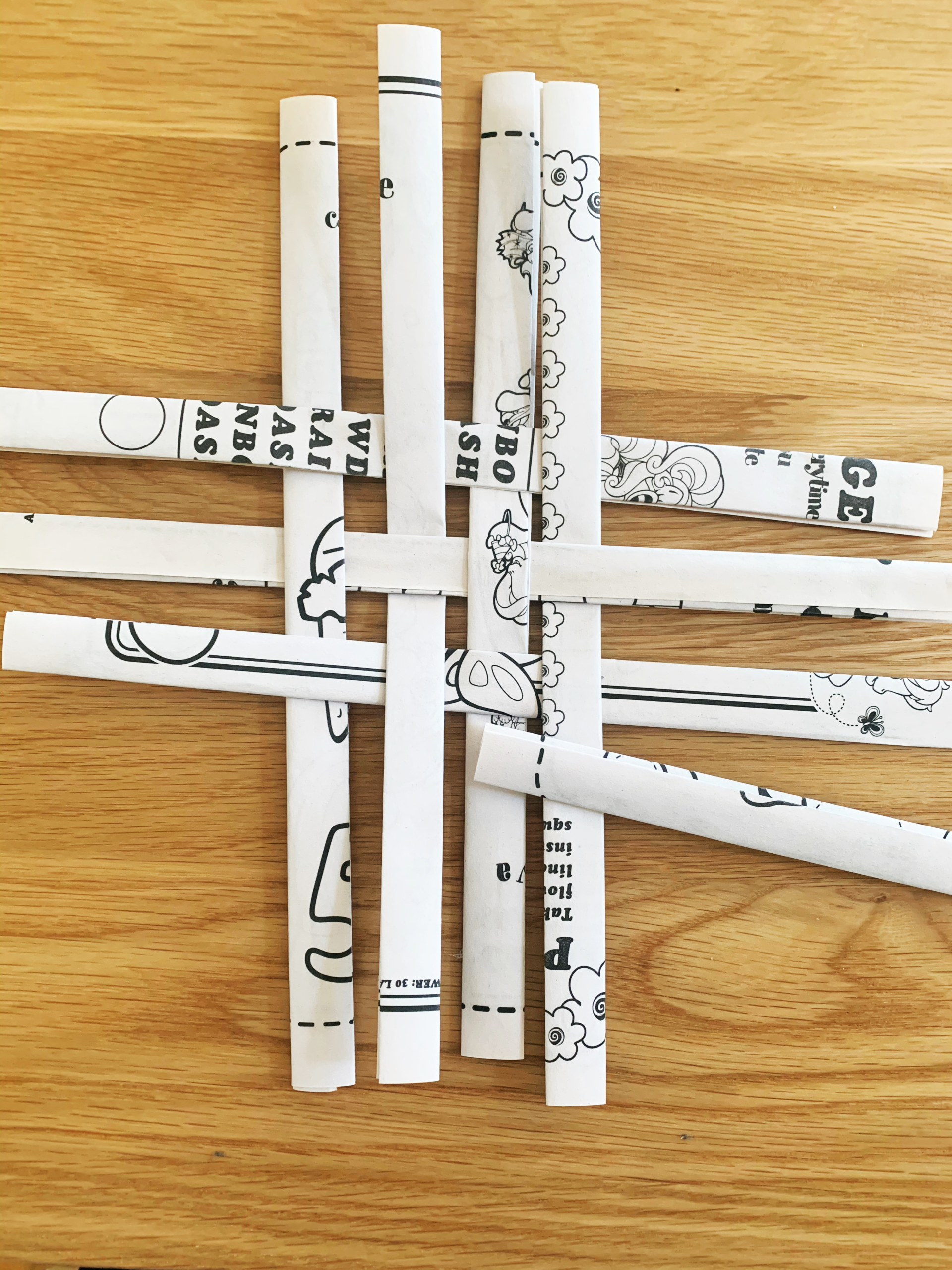
Step five: After you have woven those eight strips together, gently push the edges together, creating a small, tightly woven square. Make sure the edges are all neatly aligned.

Step six: Once you’re happy with the placement of the strips, glue the pieces of paper on the strips together in the four corners of the square, to secure what will be the base of your basket.
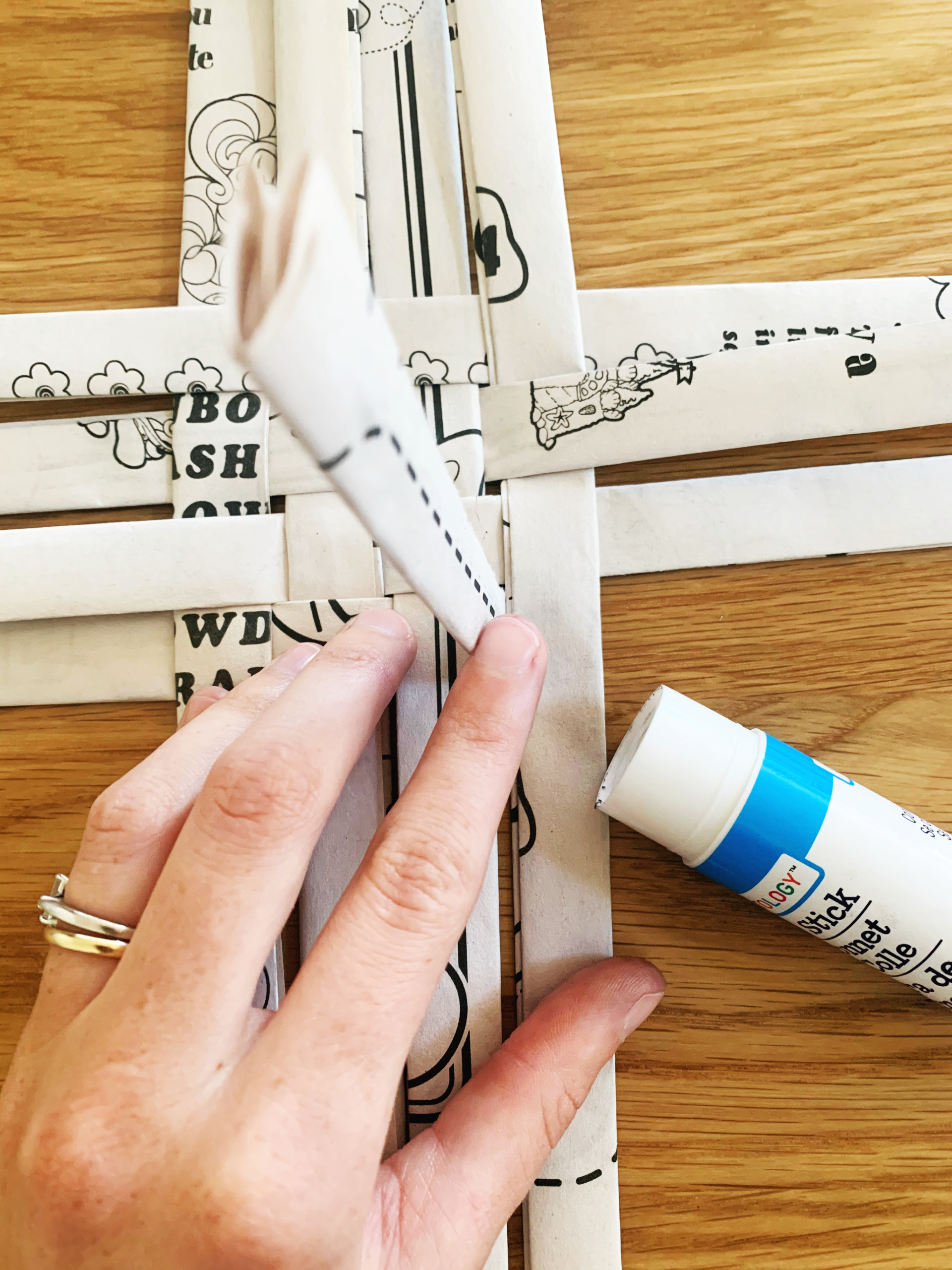
Step seven: Now that you have made your base, it’s time to start building up the edges of your basket. Add a new horizontal strip on top of the base, with about a half inch of the strip sticking out beyond the base, to the left, and secure the new strip to the first vertical strip with your paper clip. Then weave the new strip over and under each of the four vertical strips, bending every other strip upward as you go. Pro tip: This first round is the hardest! I promise it only gets easier once your box has a shape. And don’t worry about the extra portion of the strip hanging off the side–you will get rid of this part later on!
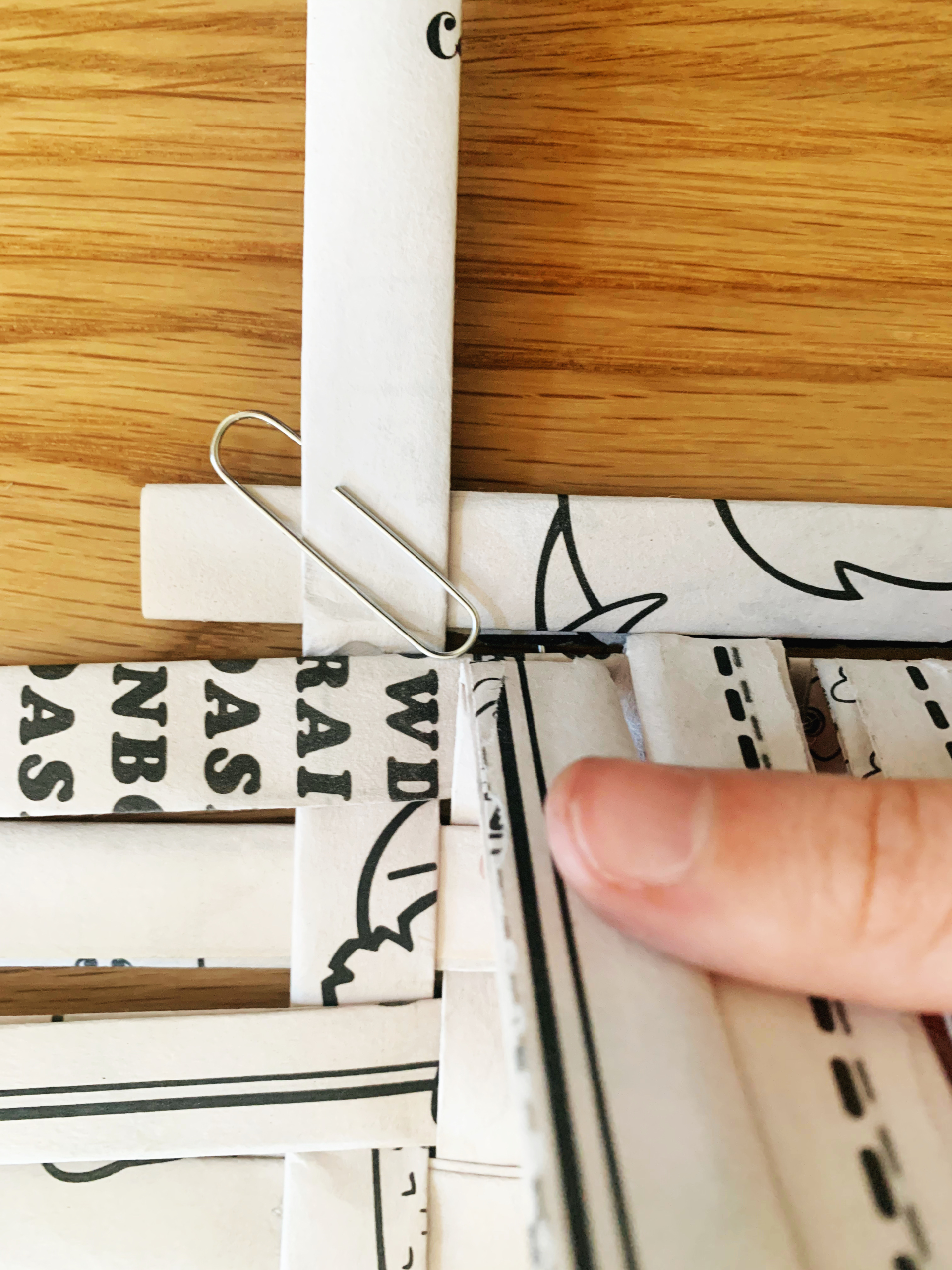
Step eight: Continue weaving until you’ve gone all the way around, turning and creasing at the corners to help make the box’s shape. To secure the strip in place and make your box even sturdier, remove the paper clip, put a small amount of glue on the tab that you left sticking out at the start, and then press it against the corner to finish the square. Tip: Depending on the size of your workbook page, you might need two strips to make it all the way around the box. If so, don’t worry! When you are getting close to the end of a strip, take another strip, overlap and glue the pieces together, and then just keep weaving around the edge.
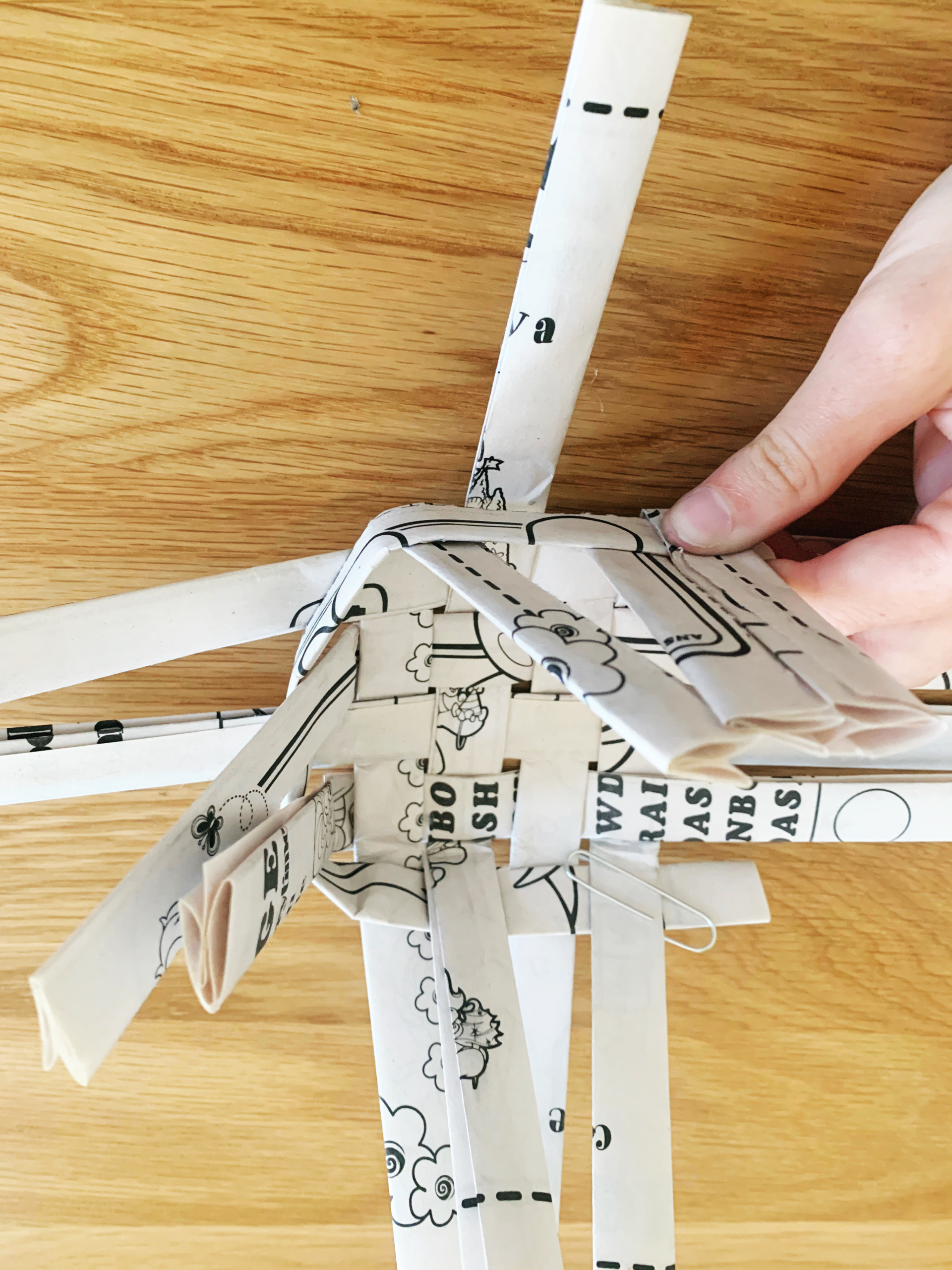
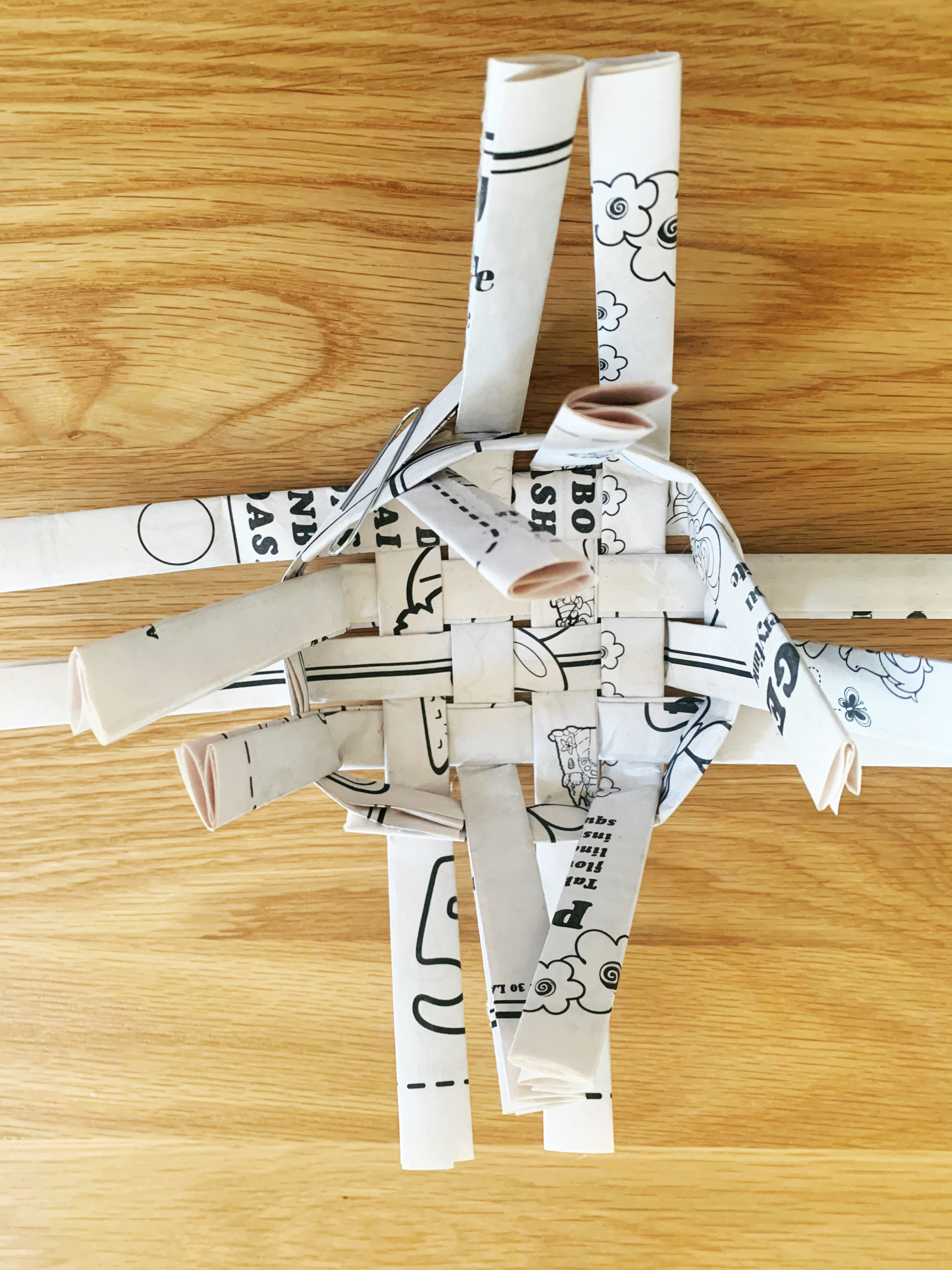
Step nine: Now take another strip and, this time, paper clip it to the inside of the basket in order to hold it in place. Weave this new strip around the square using the same over-under technique, but doing the opposite of the previous row (going over strips that the last strip went under, and vice versa). With this strip, you will be pulling up the remaining strips on the table as you go around. When you have gone all the way around, you can remove the paper clip—if you weave the paper tight enough, you shouldn’t need to reinforce it with glue, but if you want to make sure the pieces of your basket don’t move, just add a touch of glue to the ends when you remove the clip.

Step ten: Continue this process until you’ve used the rest of your pre-made strips!
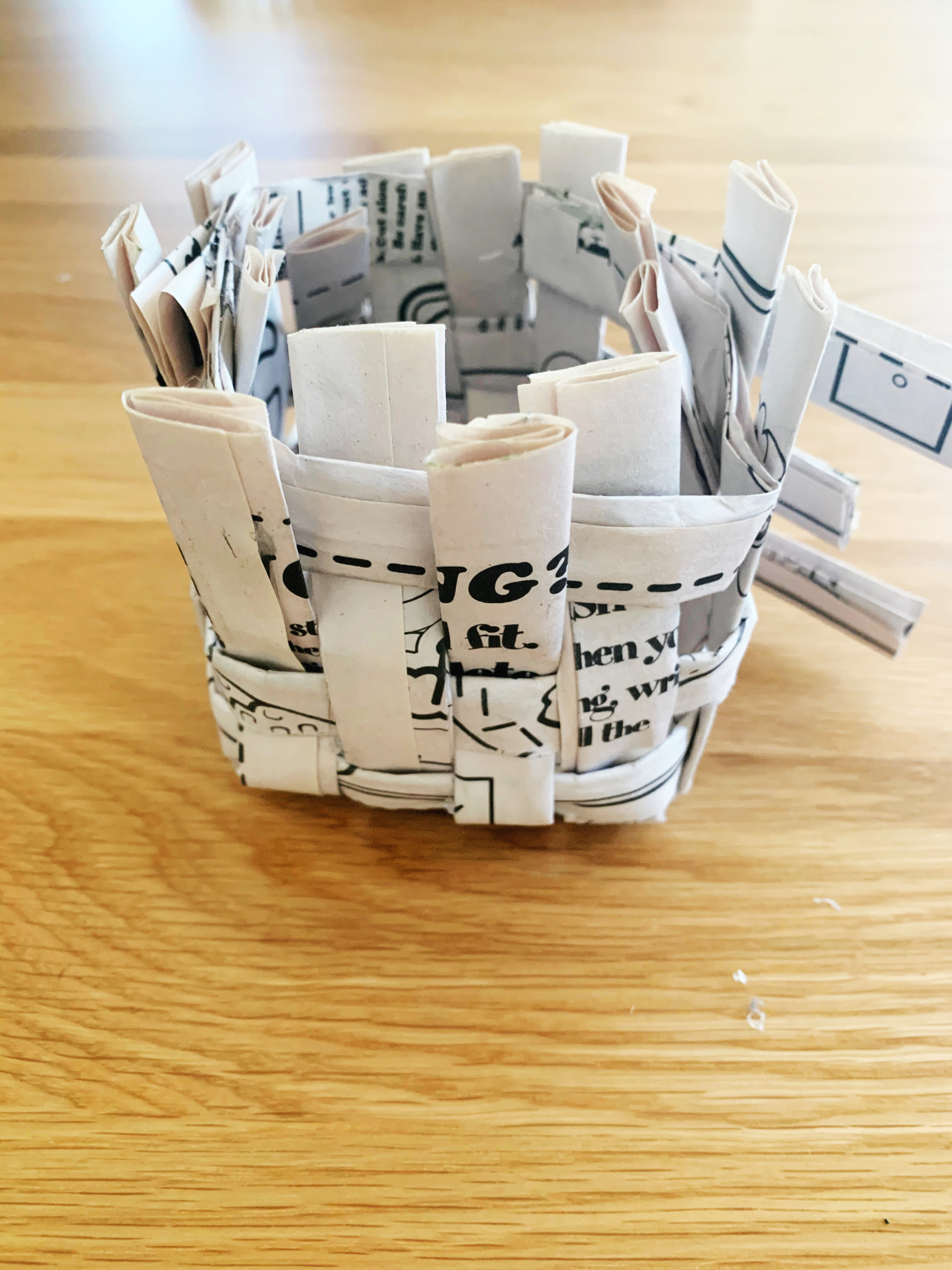
Step eleven: You’re just about done! Now it’s time to cut off any excess length that’s left over from weaving the sides of the basket and make your basket look polished. They should stay in place, depending on how tightly you wove your basket, but you can put a little dab of glue under the edge before you trim them to be safe.

Step twelve: The final step and finishing touch to the perfect basket is to clean up the top. To do so, simply fold the strips at the very top of the basket towards the inside and tuck the pieces into a lower layer, or just trim them off so the tops are even with the top rim of the basket.
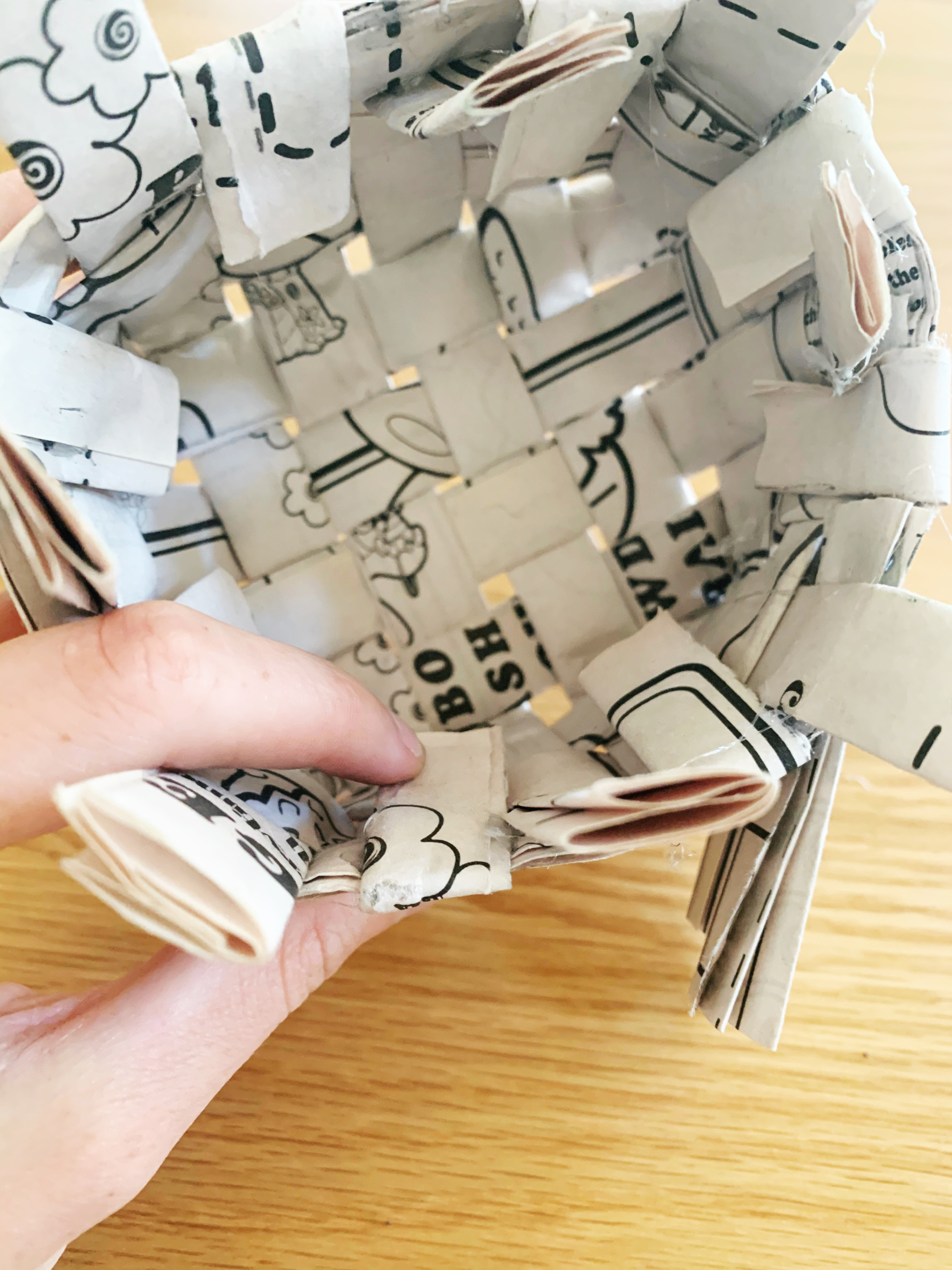
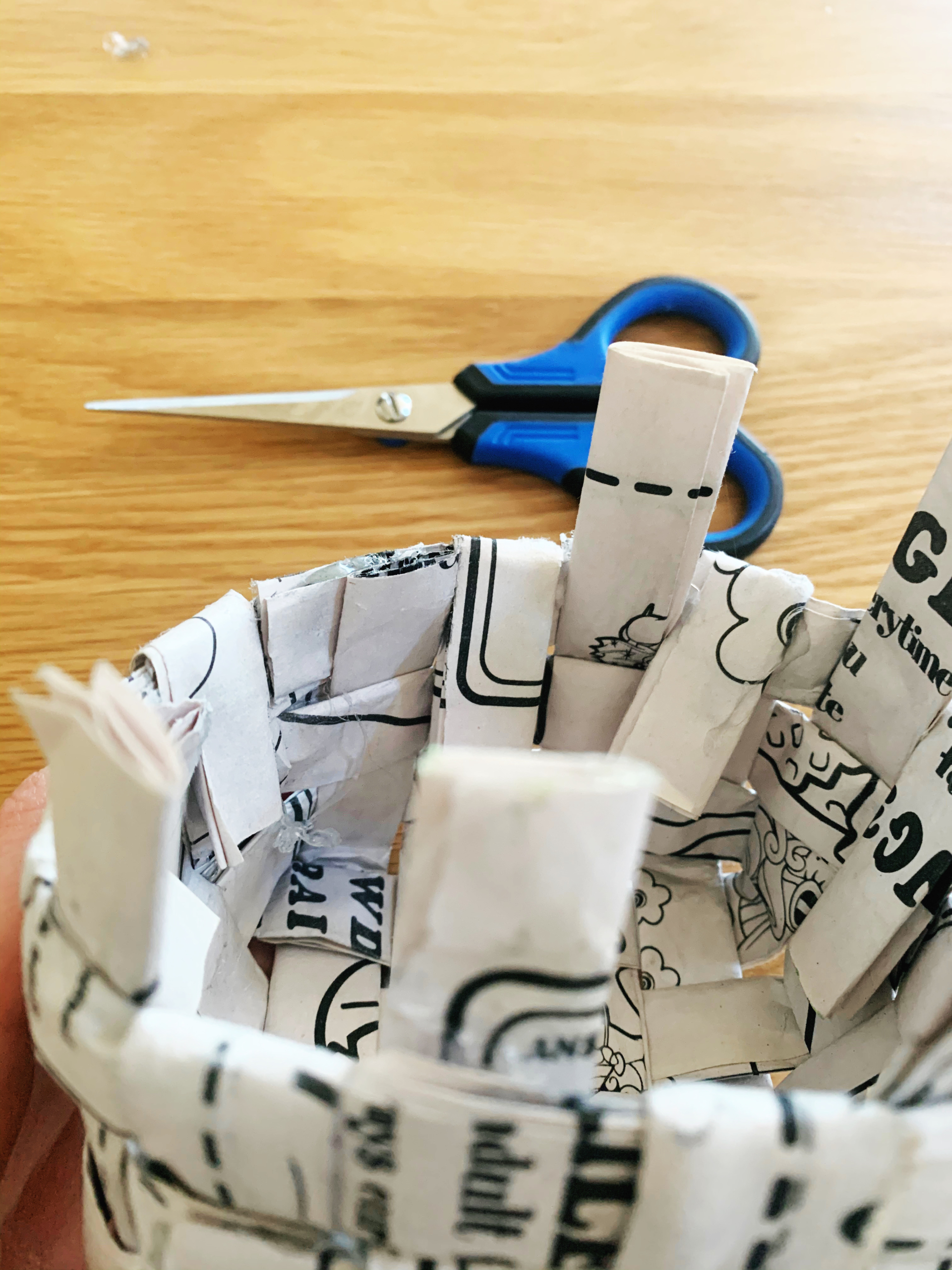
And you have your new basket! This piece is so fun and unique. Let us know what you fill your new basket with!
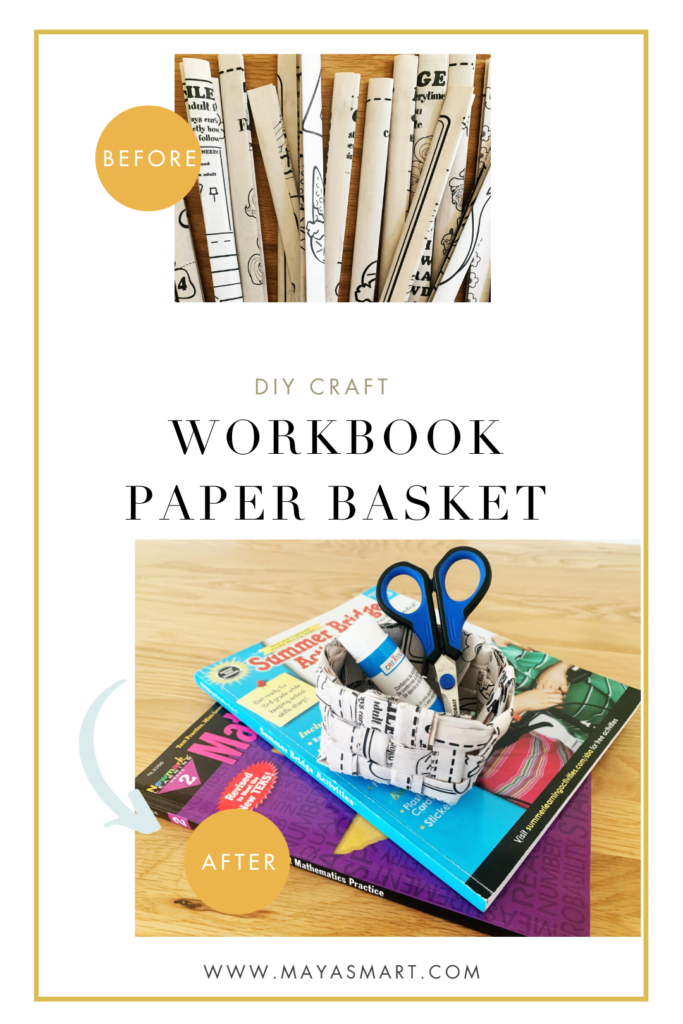
When kids aren’t together, sending hand-written notes is a great way to stay connected, not to mention lots of fun for both sender and receiver. Writing good, old-fashioned letters is also the perfect literacy activity for children—the kind they don’t even notice is educational. And this DIY book craft to make cute origami envelopes will motivate little and not-so-little penpals alike.
With just a few cuts and folds, this book page craft is relatively easy to make. When you’re done, you can decorate your envelope anyway you like, add a note inside, and deliver to a loved one for a fun surprise. These can also make cute holders with a personal touch for invitations, thank you cards, or cards to mark a special occasion.
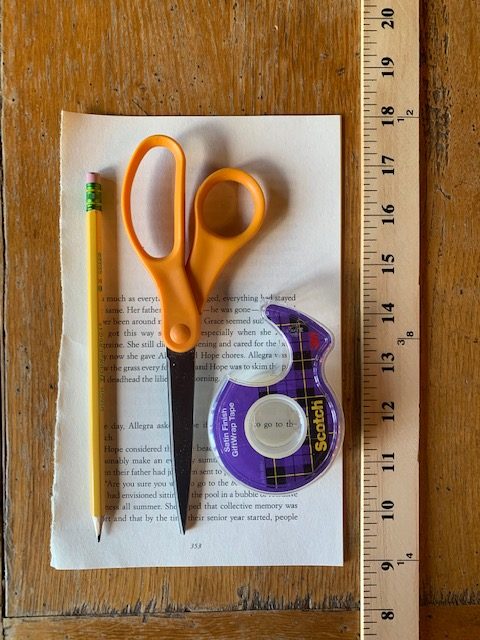
Materials Needed:
- Old book pages
- Ruler
- Scissors
- Clear tape (or fun washi tape!)
- Optional: Decorating materials (sickers, colored pencils, glitter, etc.)
Cost: You can purchase decorative washi tape for about $10, or just use regular tape. If you have an old book, this is the perfect way to upcycle some pages. Other than these basic supplies, you will just need your creativity!
Step 1: Measure and draw a square onto the book page you’re planning to use. Tip: Check what’s written on the page ahead of time. You don’t want to accidentally send something inappropriate!
I made my square 5” x 5”. I wouldn’t go any smaller than that for an ordinary note. But kids tend to love anything itty-bitty, so letting them experiment with going super tiny could spark their creativity. A doll or stuffed-animal postal service, perhaps?
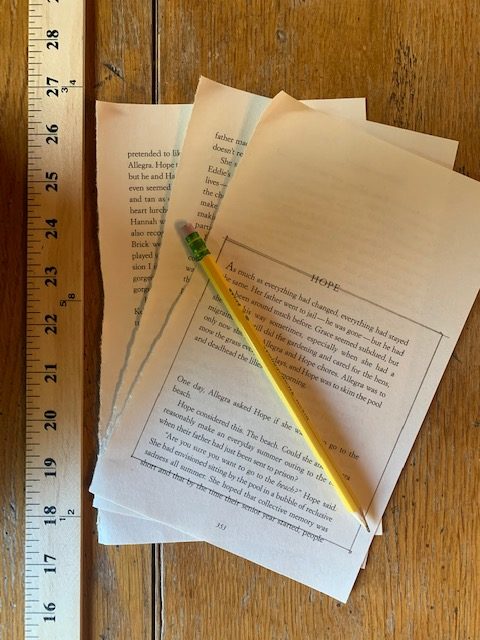
Step 2: With your scissors, cut out the square you drew.
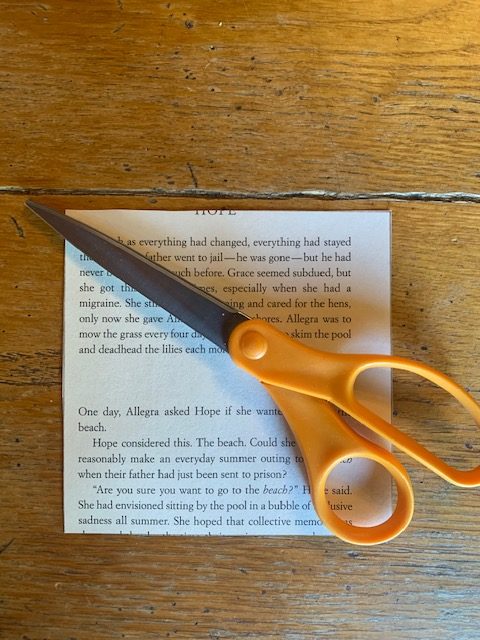
Step 3: Fold the two opposite side corners in until the points touch.

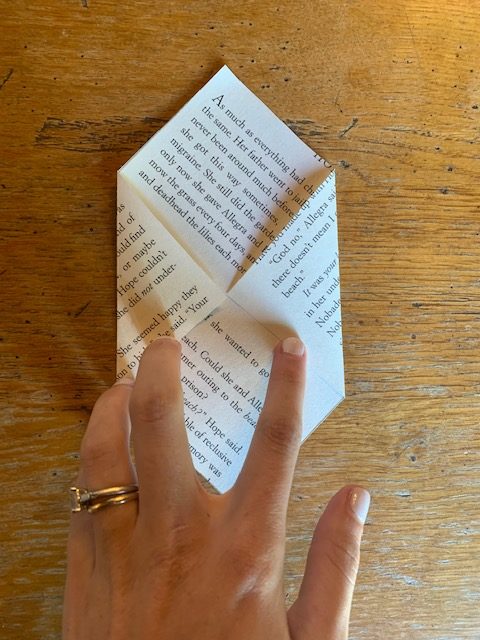
Step 4: Now fold up the bottom point, so that it reaches a bit past the place where the two side points meet.
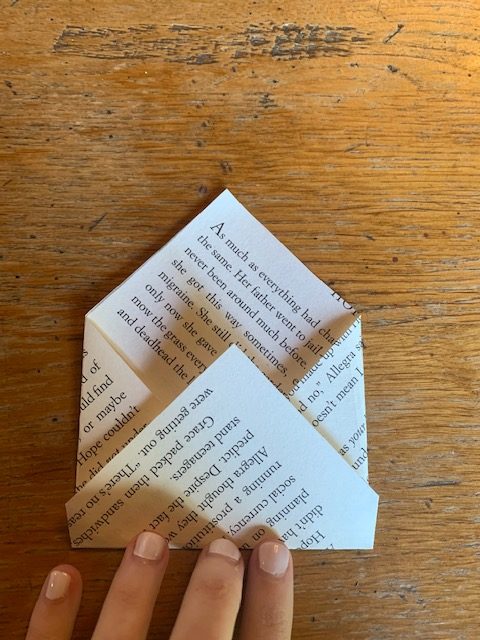
Step 5: Next, fold over the bottom point towards the back of the envelope and tuck it under the two side points.
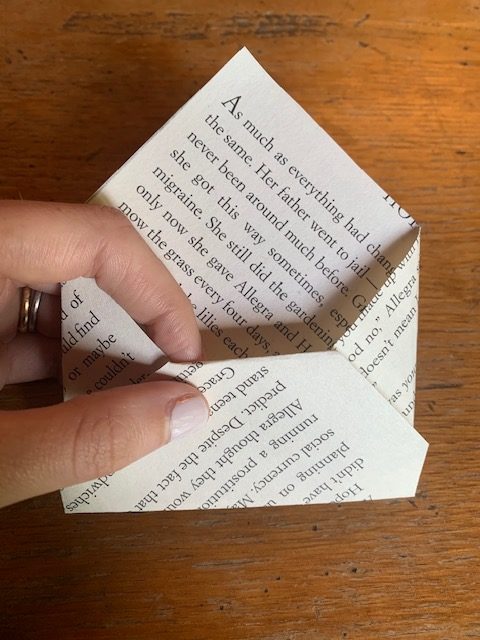
Step 6: Tape the edges so the bottom flap stays closed. I used clear tape, but decorated washi tape would also be super cute on this craft.

Step 7: Fold the top point down to fully cover the envelope’s opening.
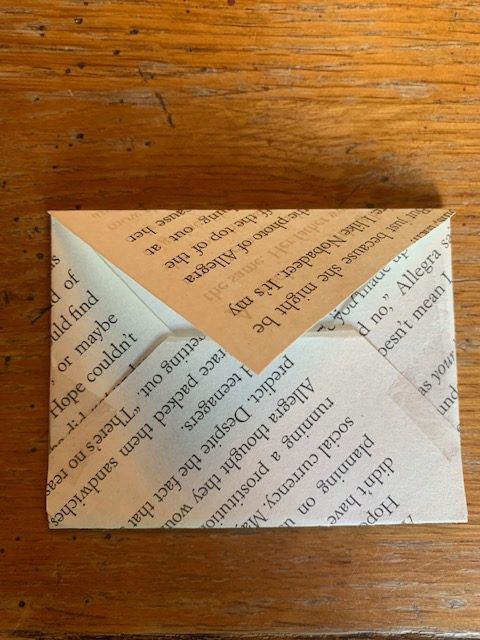
And your basic tiny envelope is complete, but you can still decorate it, if you like! You might add color with pencils, crayons or pastels; glitz it up with glitter glue; or pop on some stickers or other simple decorations.
When you (or your kids) are happy with your envelope, you’re ready to get writing. Prepare your card or note, stick it in the envelope, and secure the top flap with another piece of tape or a sticker. Note: This could also be a chance to use one of those fun sealing wax kits available in stationery stores and online, or make your own by melting candle wax over the edge of the flap and pressing a coin into the slightly cooled wax. (Of course, please be careful if using a flame, and never let children do this alone!)
Now you’re ready to drop your creation into your recipient’s mailbox! You can also mail your card—just put it inside another envelope to make sure the postal service can process it without problems. Have fun!
Book page flowers make such pretty decor. We have done a few different DIY book page flowers in this craft series. Why not make them all and combine them into a beautiful arrangement?
I have to say, I was staying away from roses because of how intricate and delicate they look. I thought making a DIY paper rose was going to be so much harder than it turned out to be. So don’t shy away from this beautiful flower! If anything, it’s actually simpler than some of the other flowers we’ve created.
Modify this craft for kids by using glue dots instead of a glue gun and letting them color or decorate the flowers. Let their creativity soar—not all roses are red!
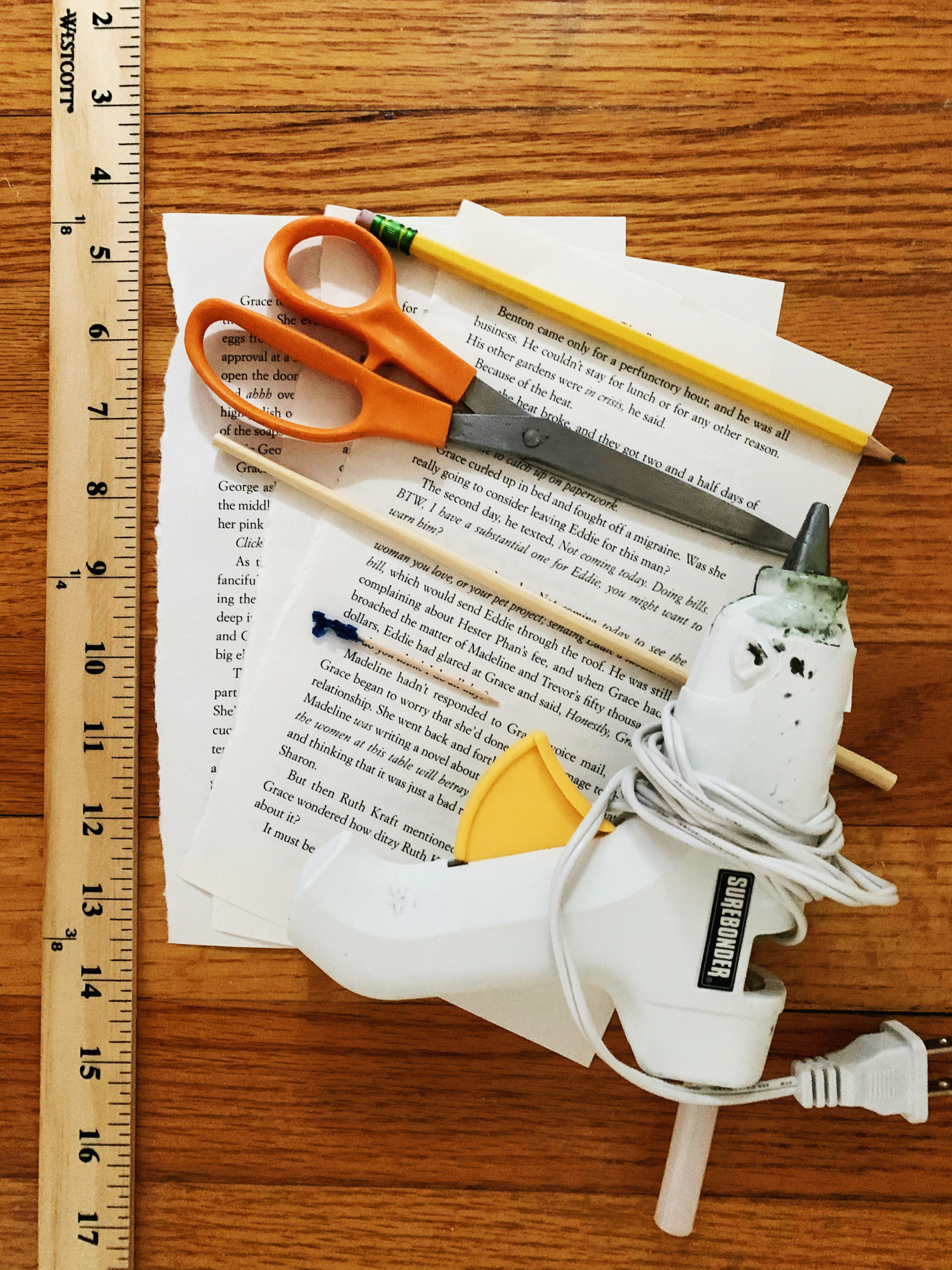
Materials Needed:
- Old book pages
- Ruler
- Scissors
- A toothpick
- Glue gun (or glue dots for a safe alternative)
- Chopstick, pipecleaner, popsicle stick, twig, wire, or anything you can use for a stem
- Optional: Decorating materials (stickers, colored pencils, glitter, etc.)
Cost: This craft uses pretty basic supplies, most of which you may have around the house. I decided to use a chopstick for my stem, but you can get creative with a different material for that if you don’t have an old takeout chopstick in your junk drawer. I listed a few alternatives above!
Step 1: You will need to cut 3 squares of equal size from the pages of an old book. Note: each rose needs 3 squares, so if you are making more than one rose, you’ll need to cut out more squares. I used 5 inch by 5 inch squares. You can go bigger than this, depending on the size of your old book pages, but I wouldn’t recommend going much smaller than 5 inches or it will be difficult to fold and glue the petals together!
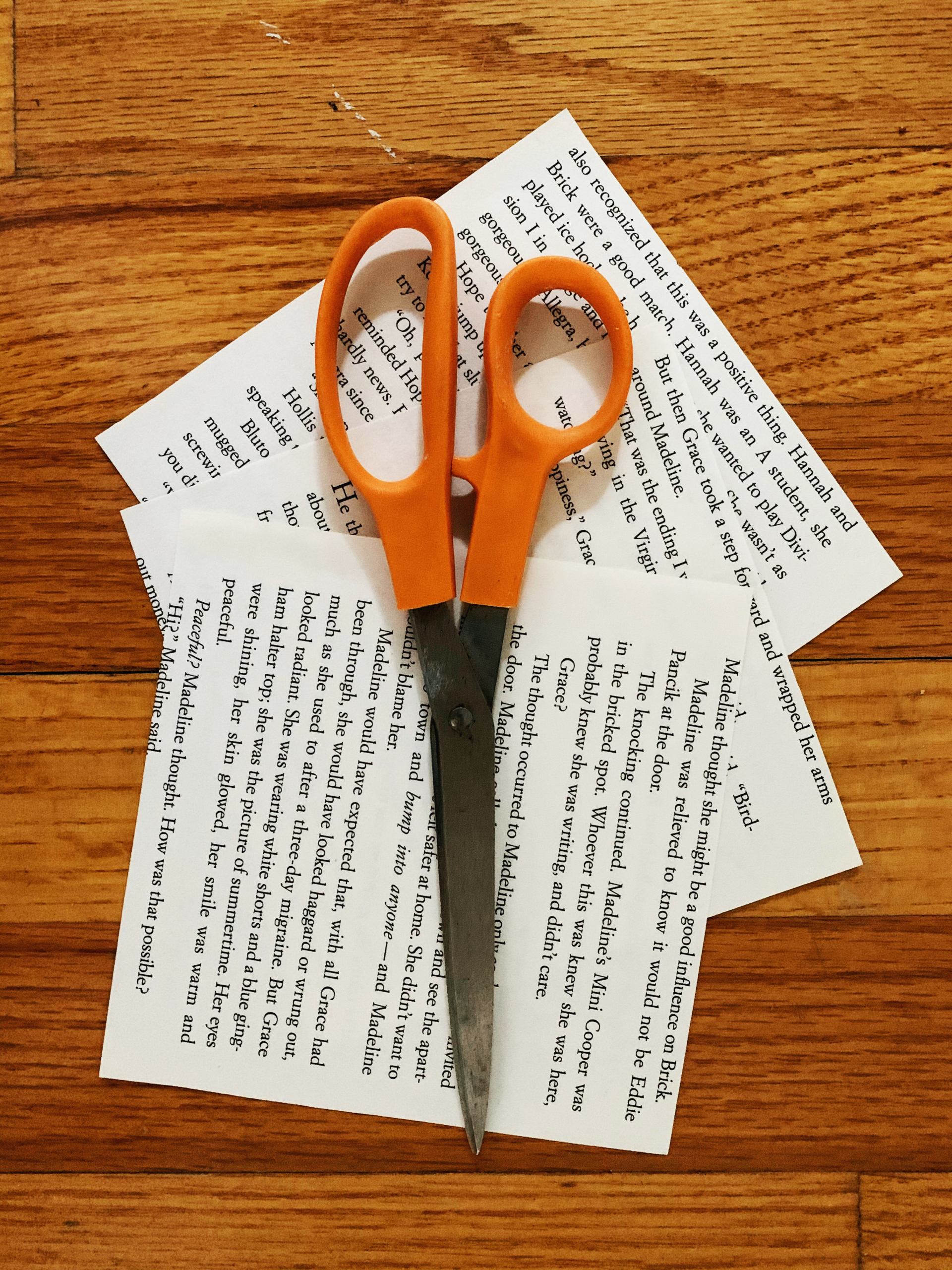
Step 2: Next, fold each of your 3 squares into a triangle, then fold that into a smaller triangle and finally fold that into a still-smaller triangle. The end result should be 1/3 the size of the first triangle.
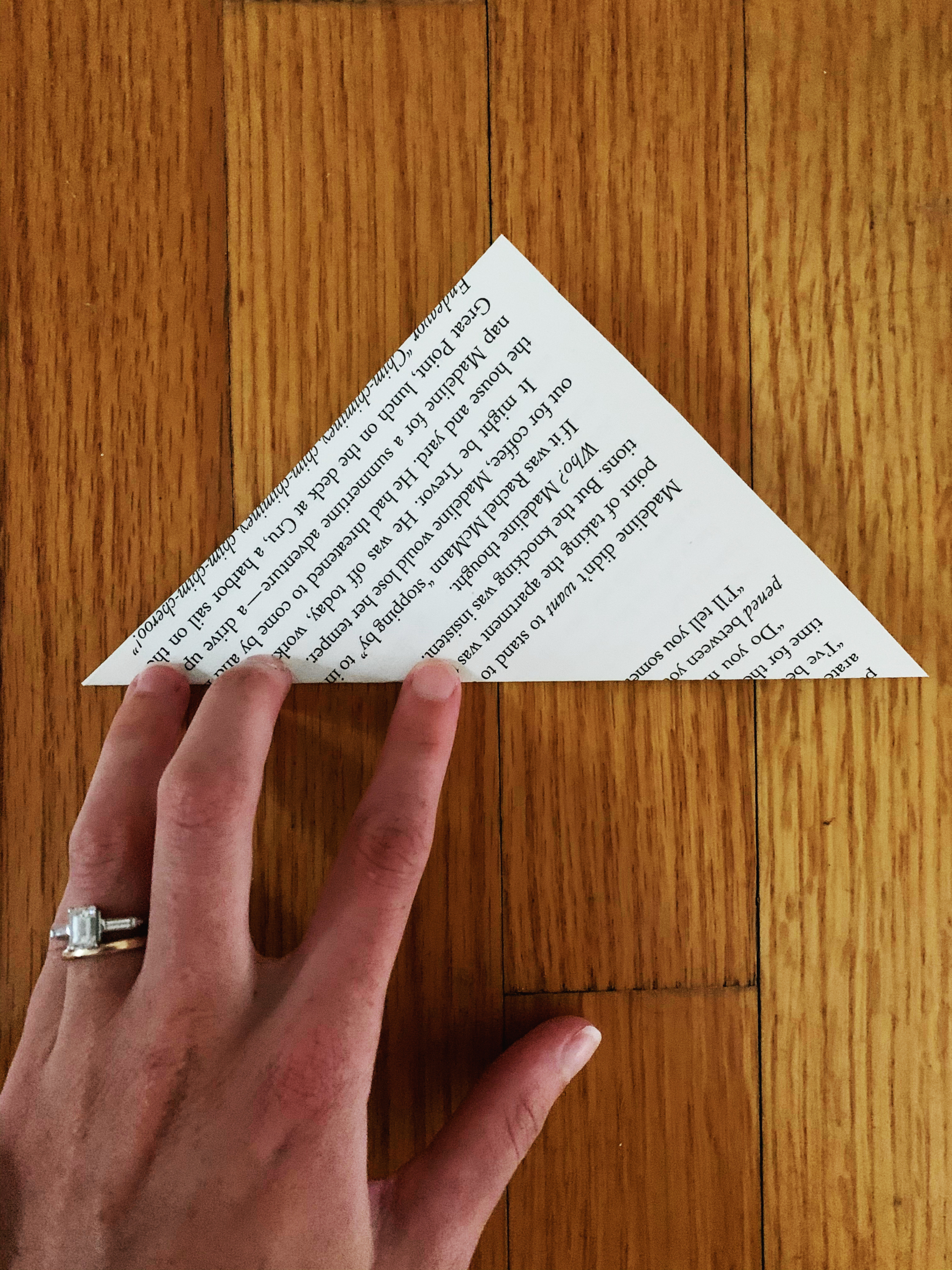
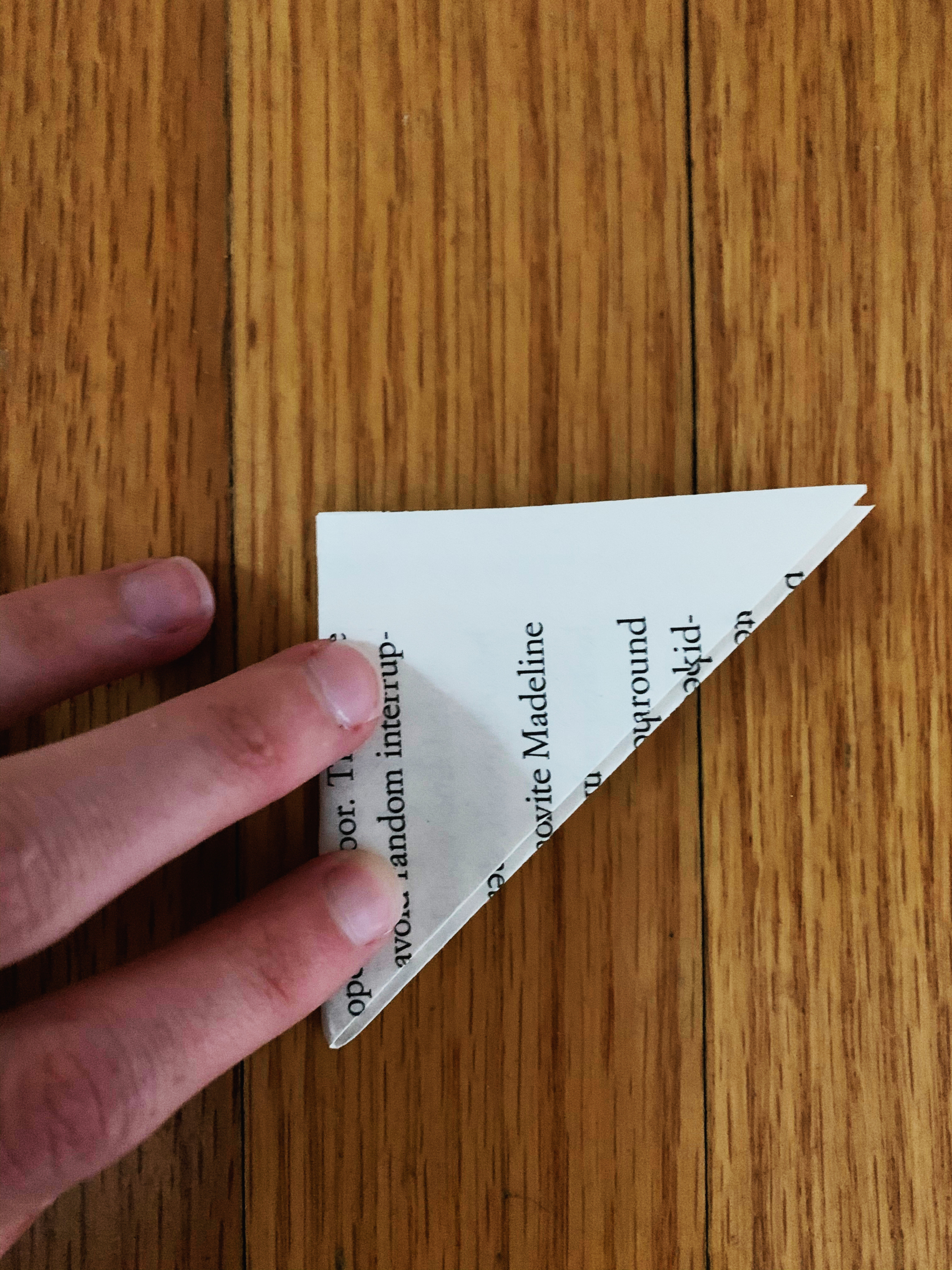
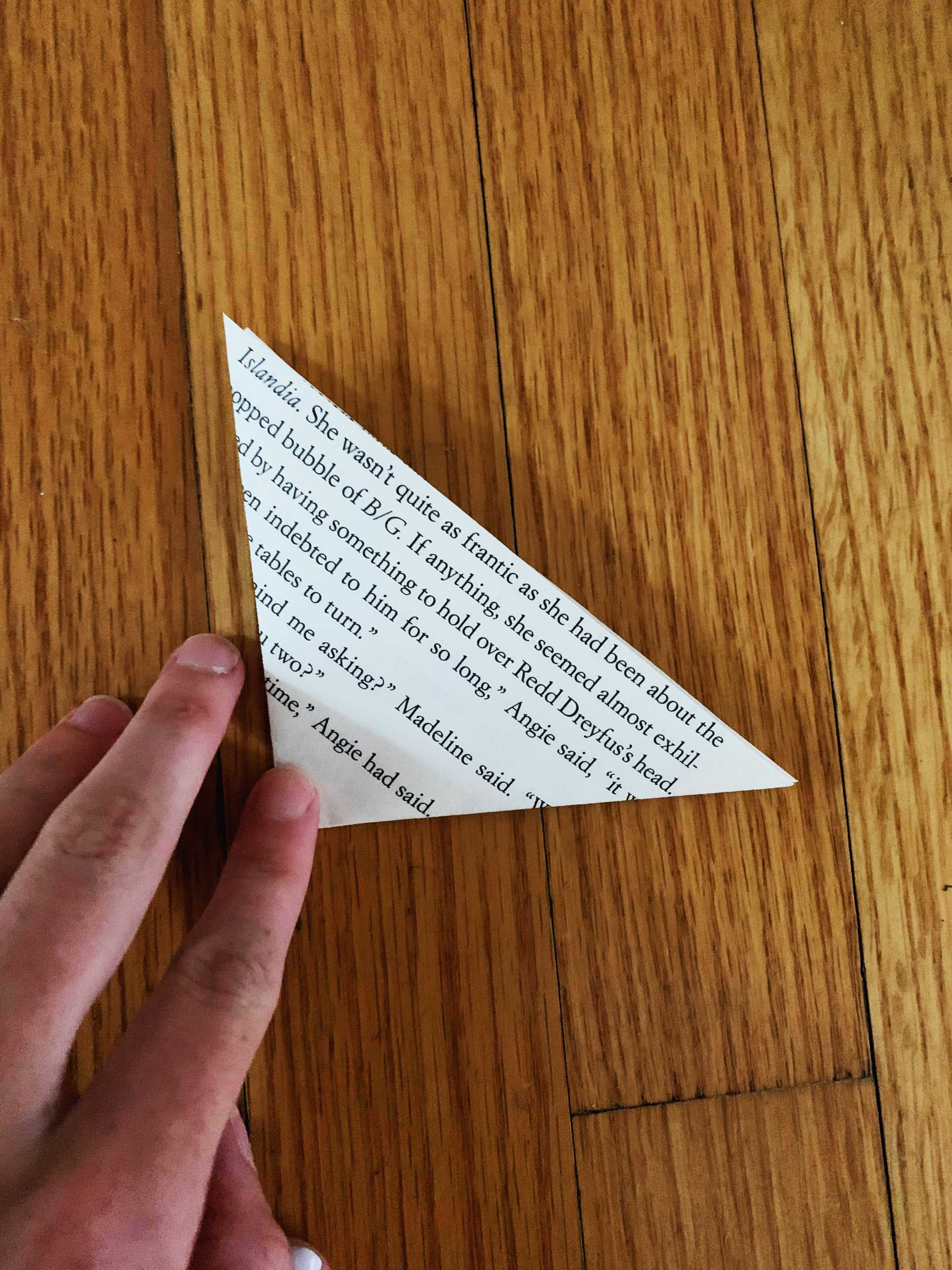
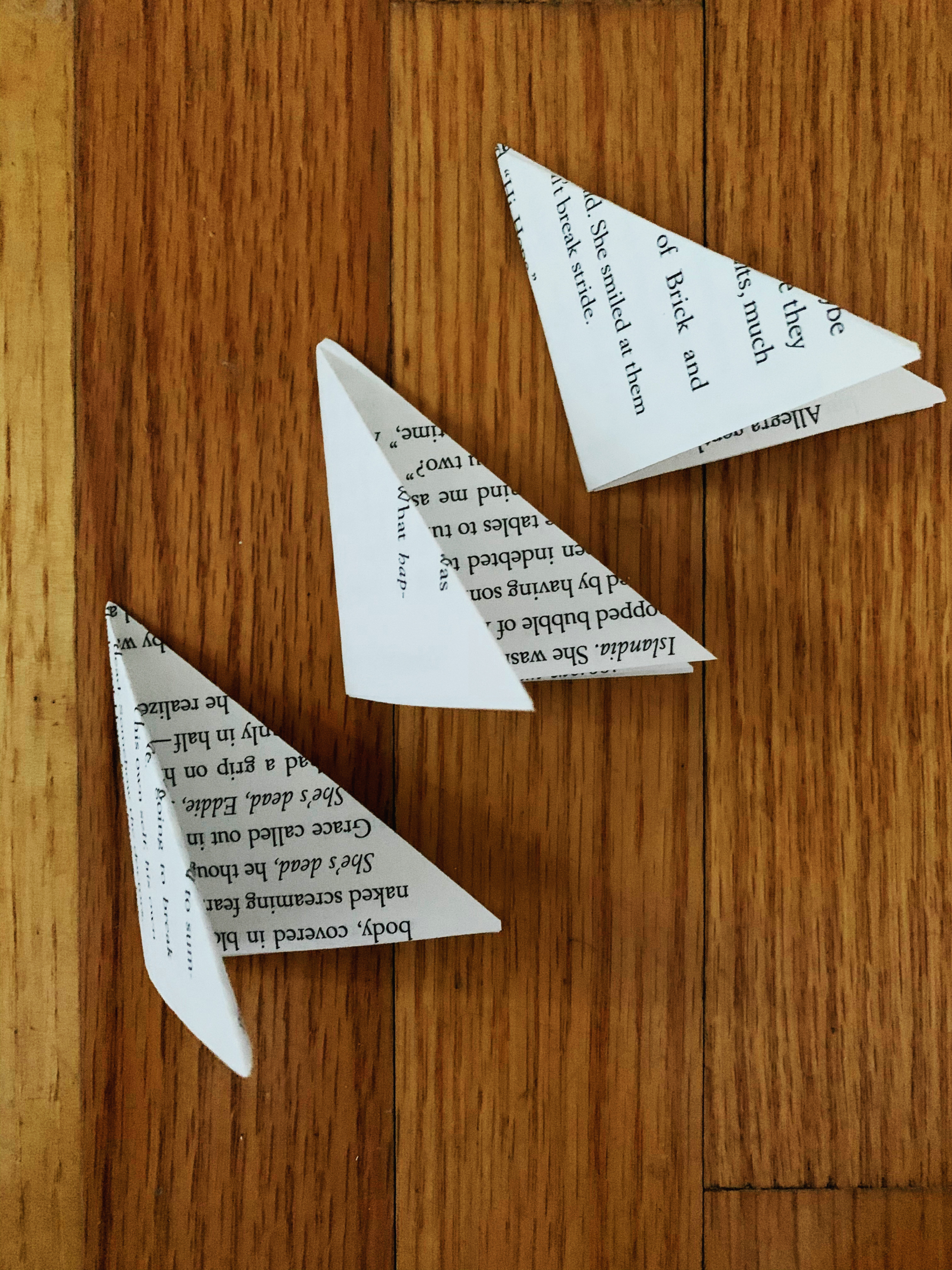
Step 3: Take one of the small triangles and keep it folded, with the pointed end facing down. Now you will cut the open top to make a dome shape (it should look like an ice cream cone). Repeat this cut with the other 2 folded triangles. Pro tip: Make sure the folded edge is facing the same way each time!
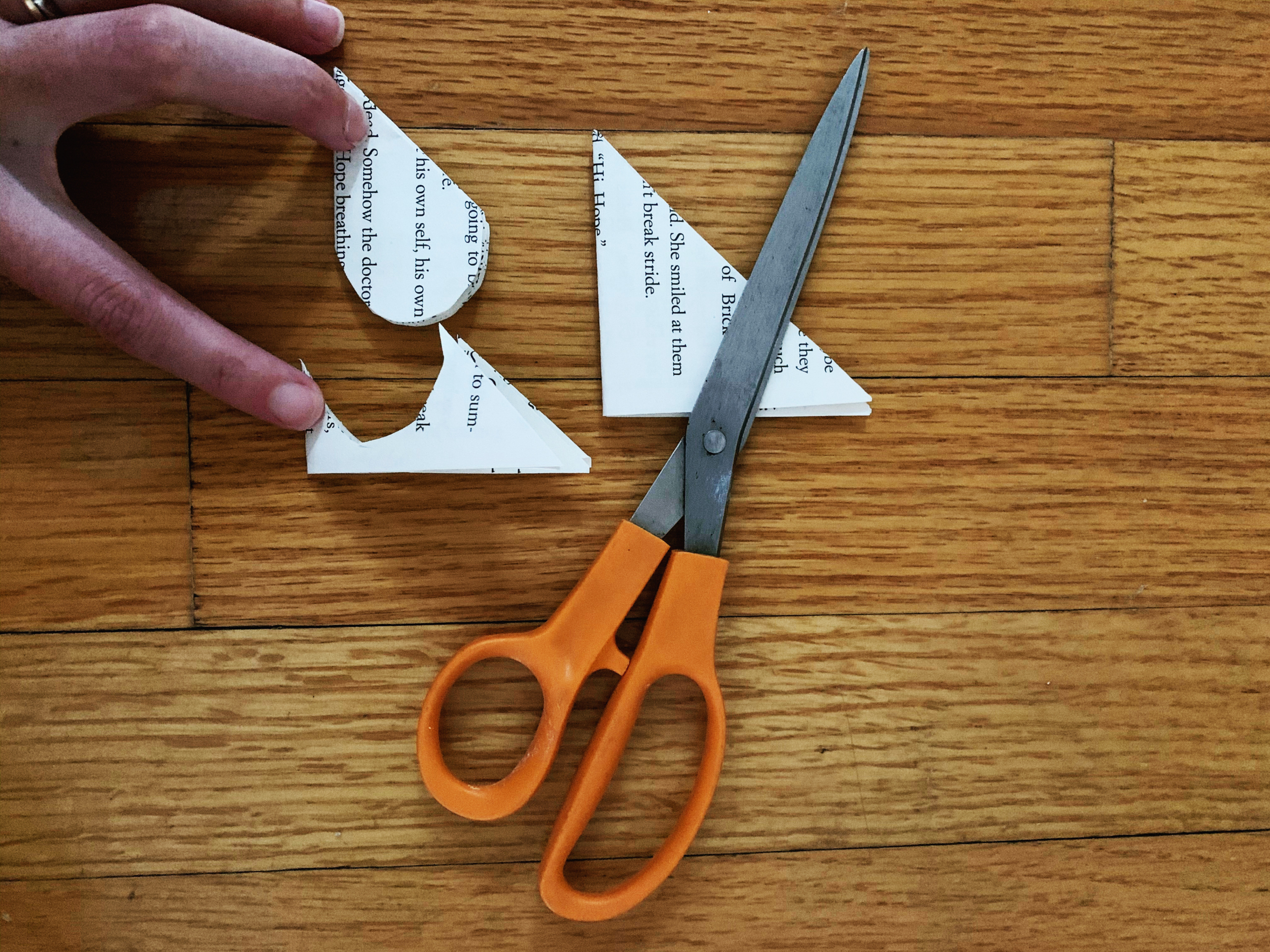
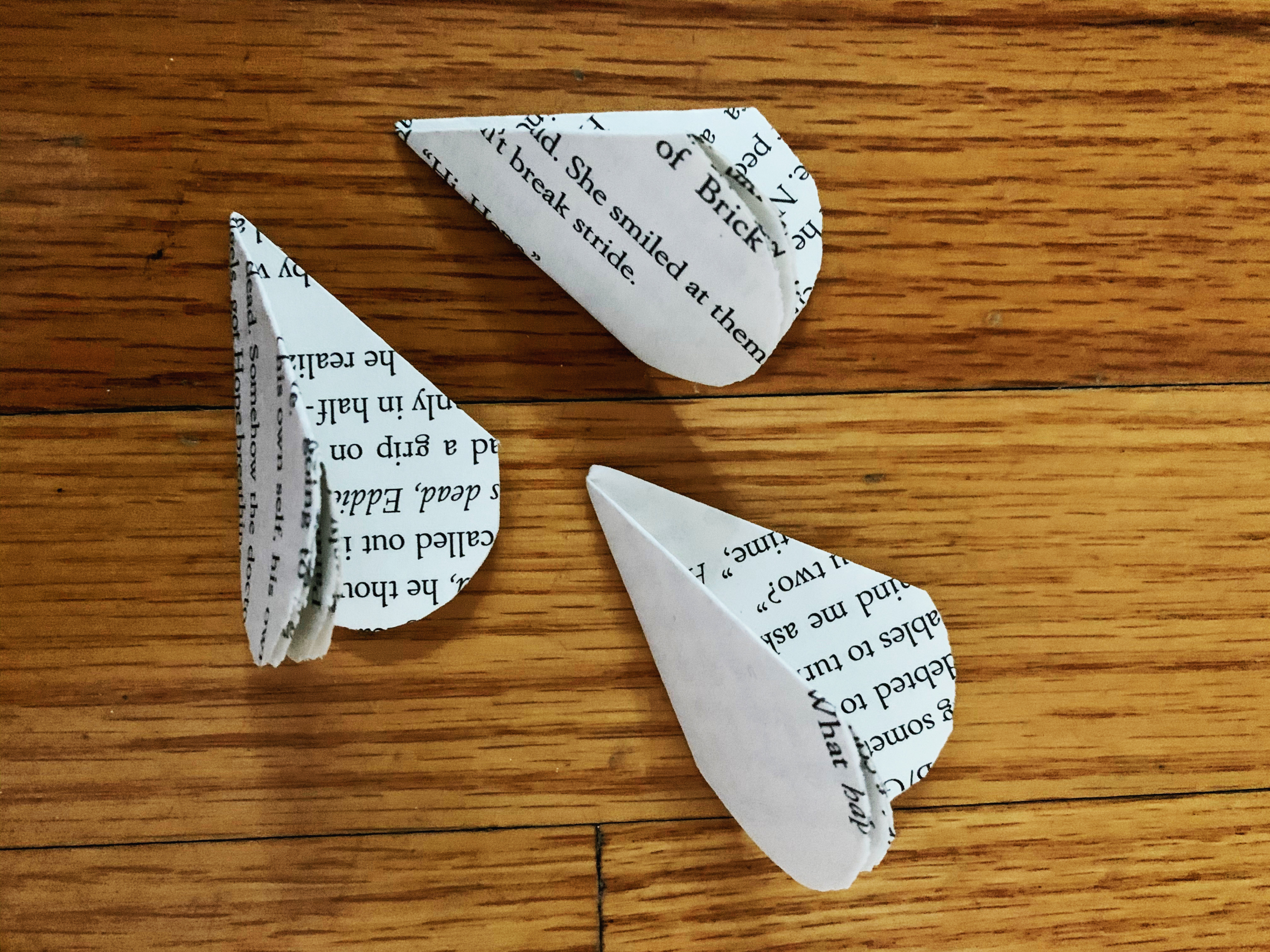
Step 4: Holding all 3 in your hand, cut off the bottom point of the triangle, leaving a small hole at the base of each triangle.
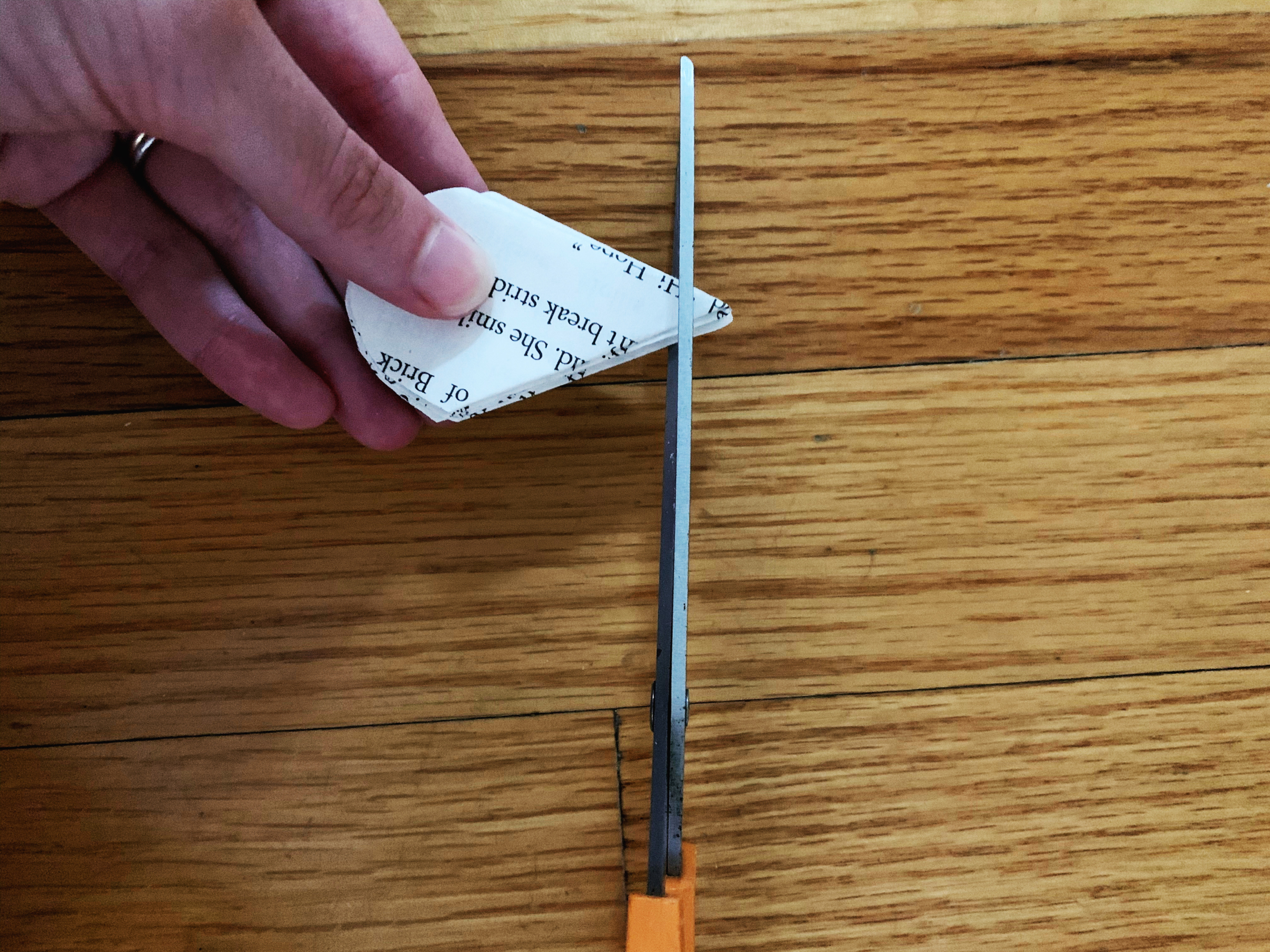
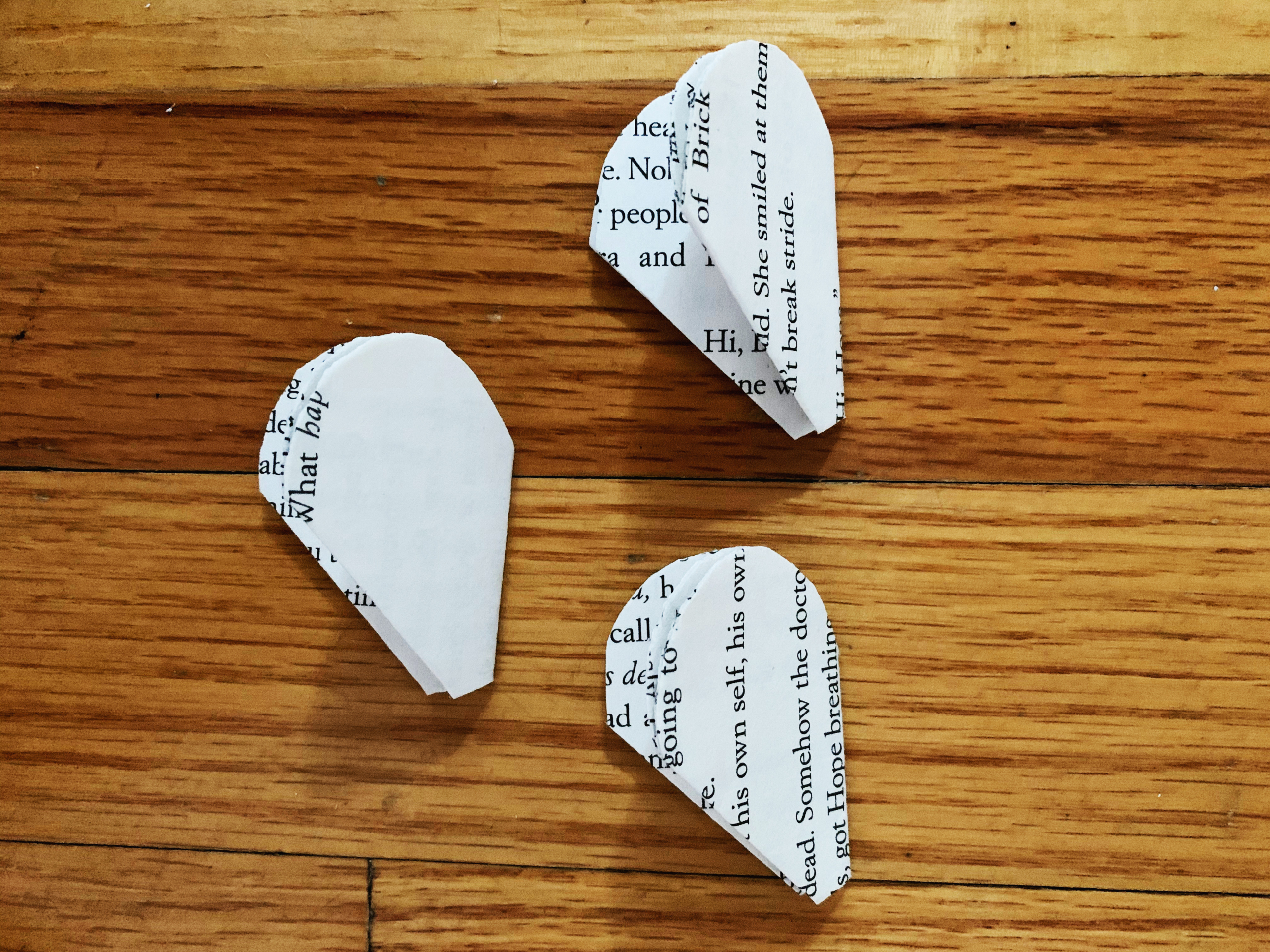
Step 5: This next step might seem complicated, but it’s not! Just go slow and count your petals. To start, unfold all your triangles. They will all start with 8 petals. From the first flower, cut out 1 petal. From the second, cut out 2 petals. And from the third, cut out 3 petals. You will now have 6 flower pieces: one with 1 petal, one with 2 petals, one with 3 petals, one with 5 petals, one with 6 petals and one with 7 petals.
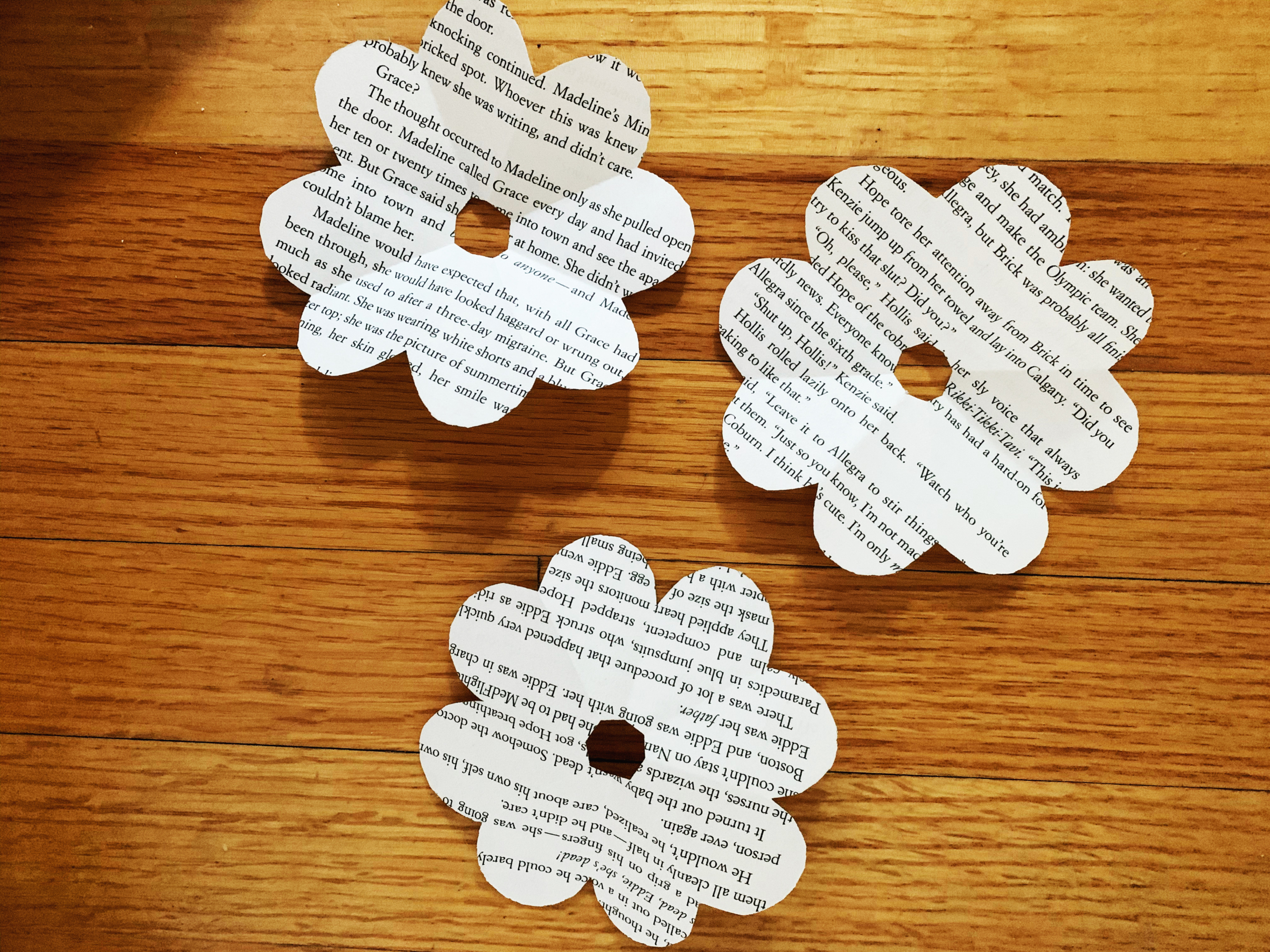
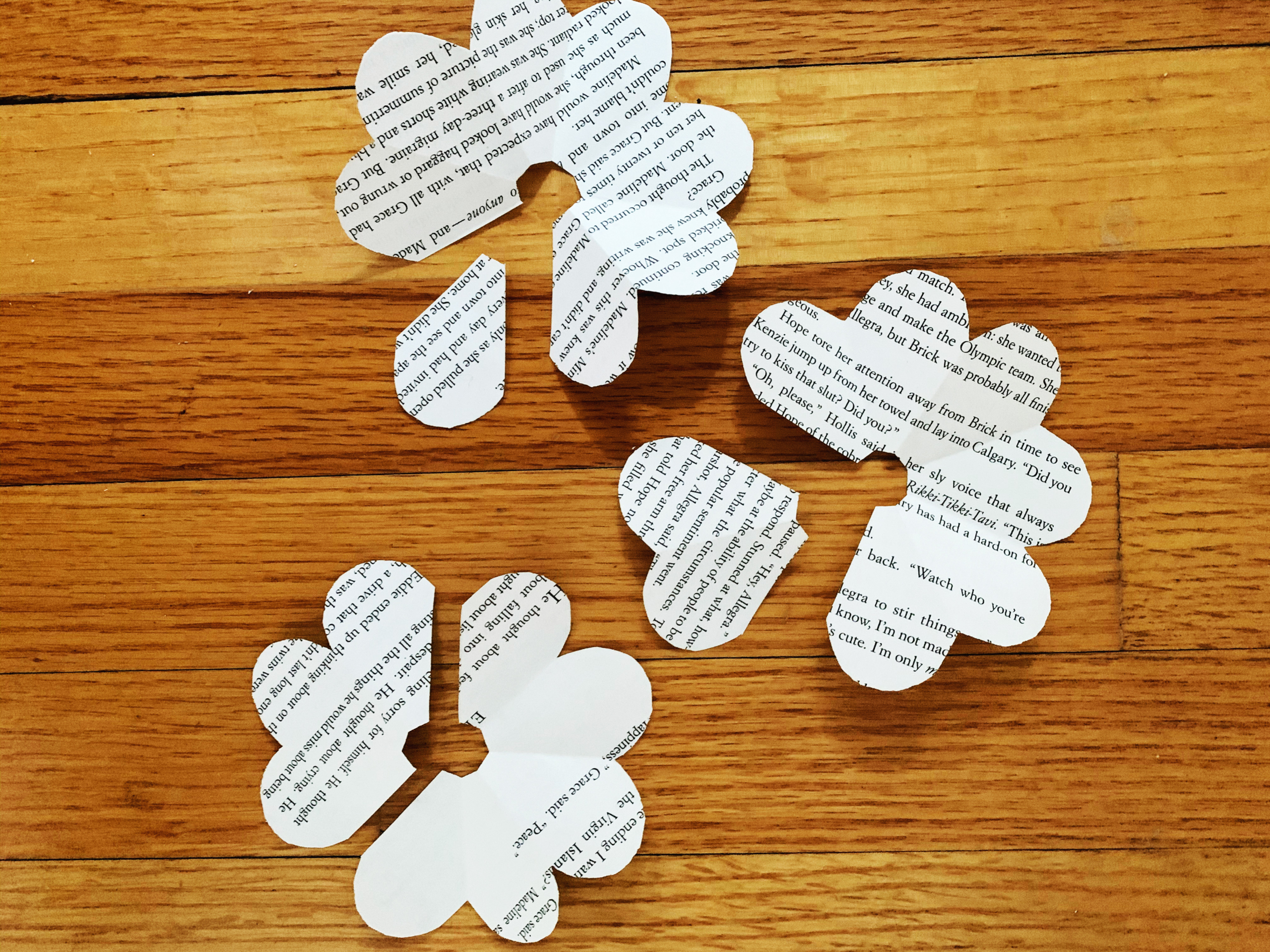
Step 6: Using a hot glue gun or glue dots, stick the edges together on the 3-, 5-, 6- and 7-petal pieces, as shown below. Just overlap the edges a bit when you glue them together.
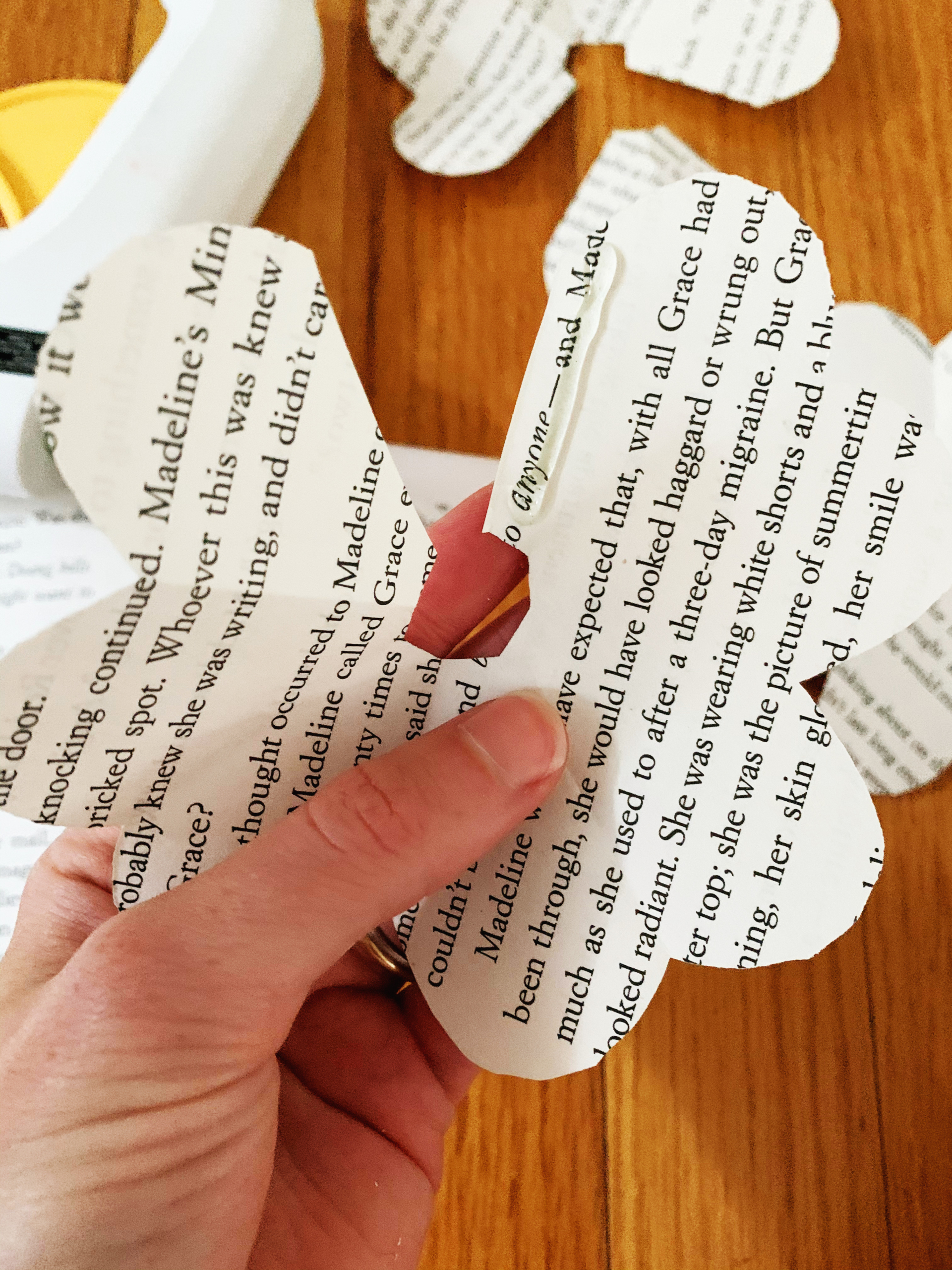
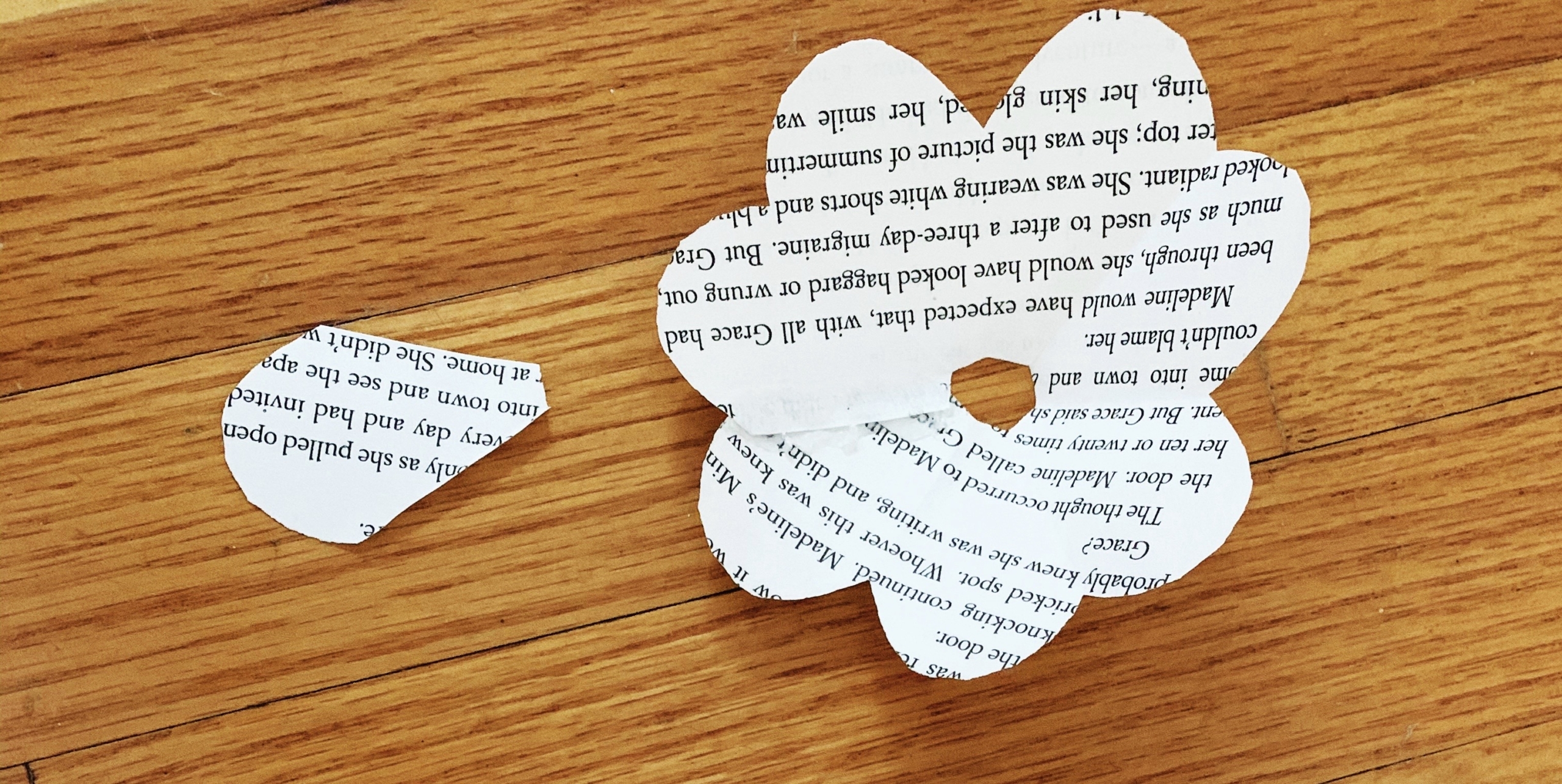
Step 7: Once the glue has dried, take your tooth pick and carefully roll the very top edge of the petals outwards. Then take the two last flower pieces that you haven’t touched yet, the single petal and the 2-petal piece, and completely roll these two pieces around the toothpick.
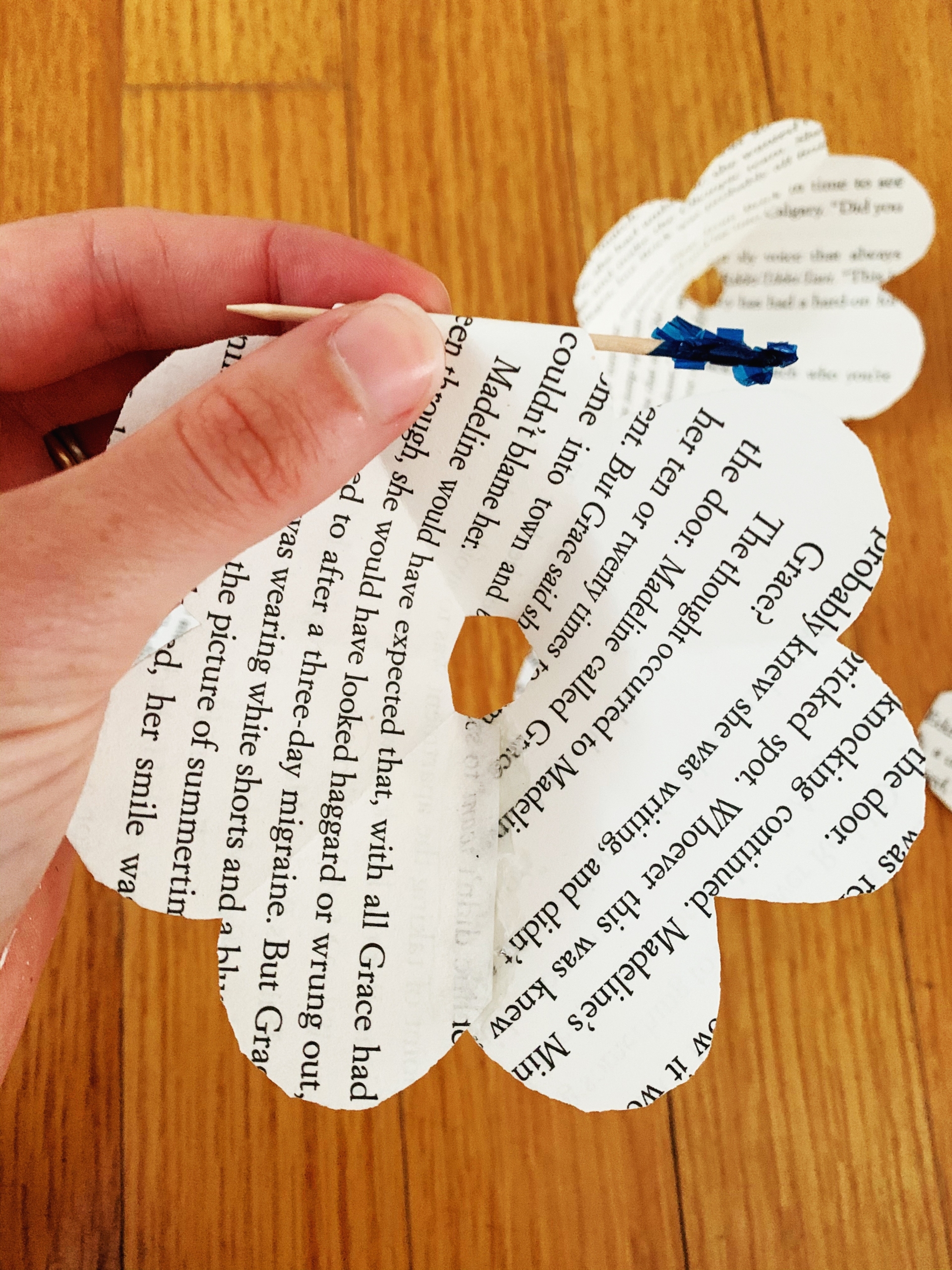
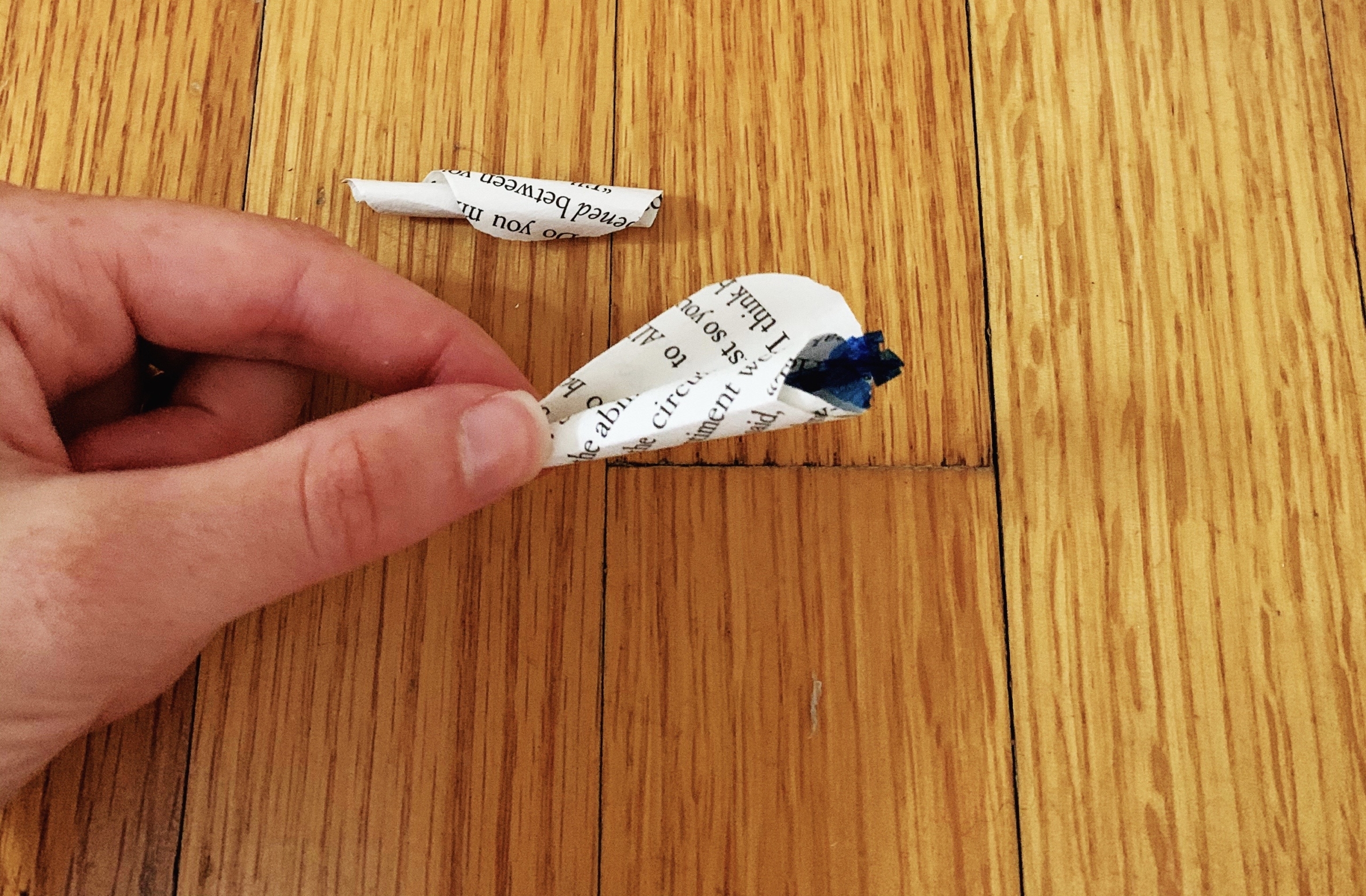
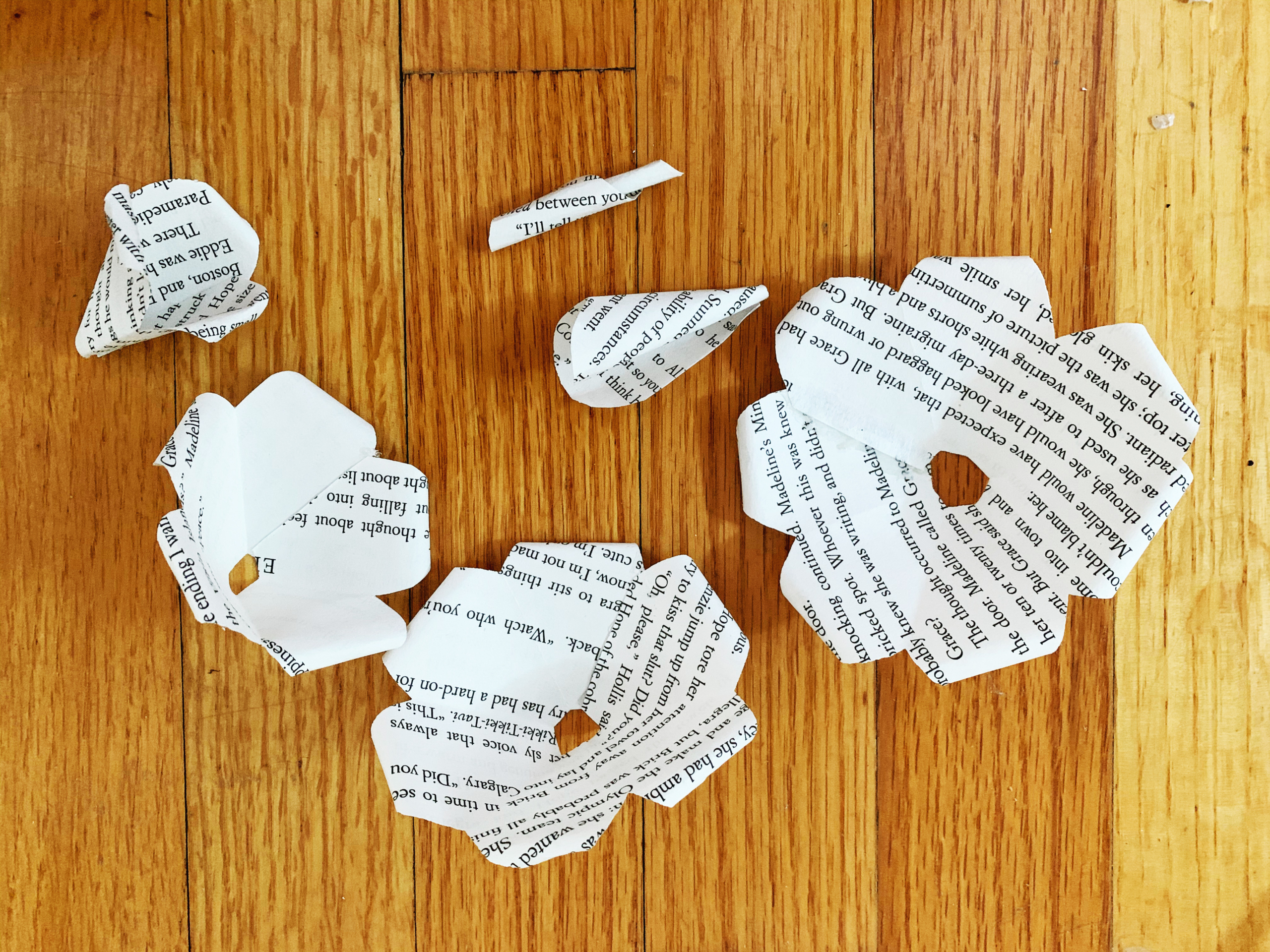
Step 8: Now it’s time to assemble your flower. Starting with the largest piece (7 petals) add a little bit of glue on the inside of the base and place the next smaller piece (6 petals) on top. Then glue the 5 petal piece to that and so on. Eventually the base of the 3-, 2- and 1-petal pieces will poke through the hole in the middle of the flower.

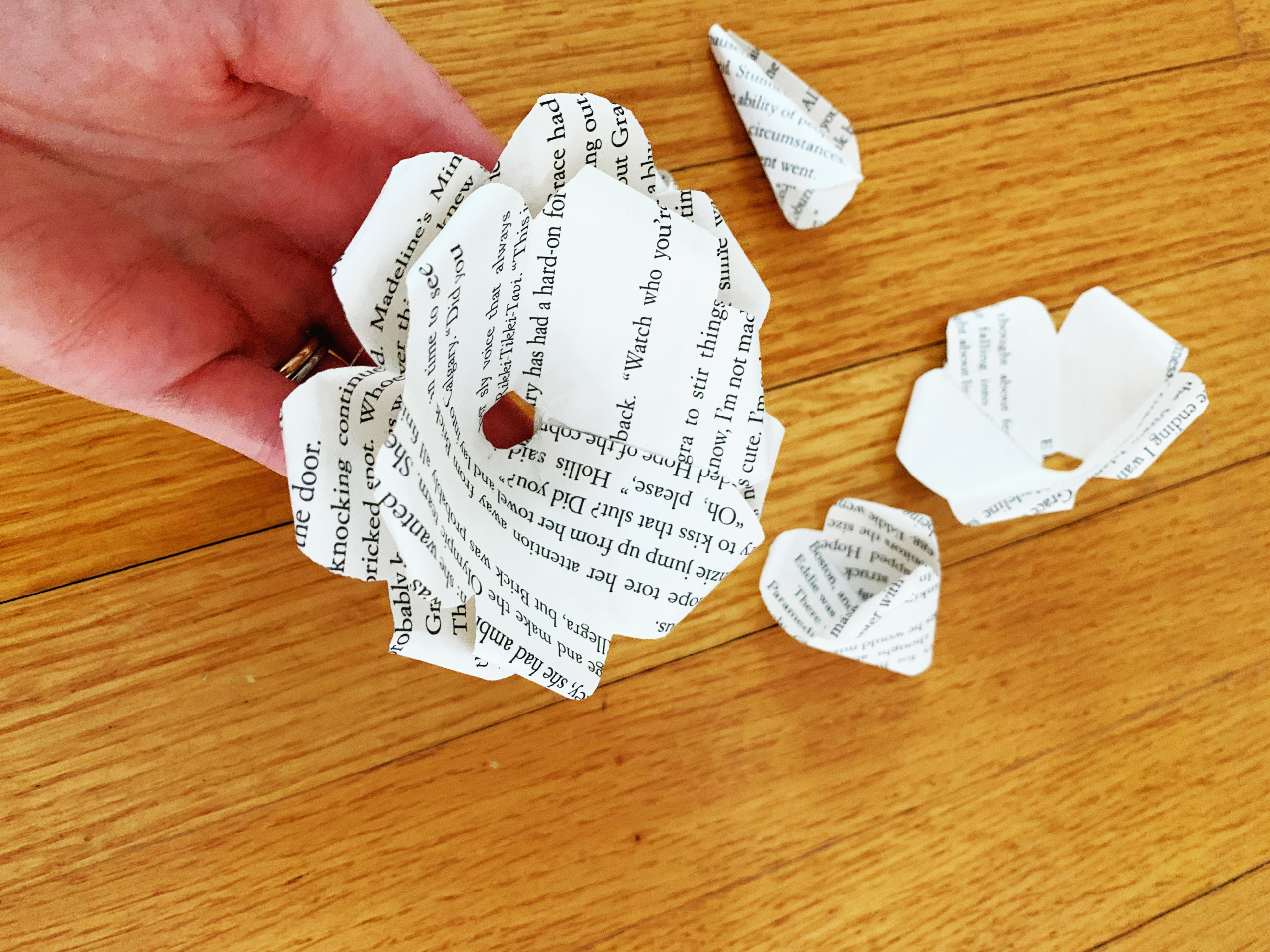
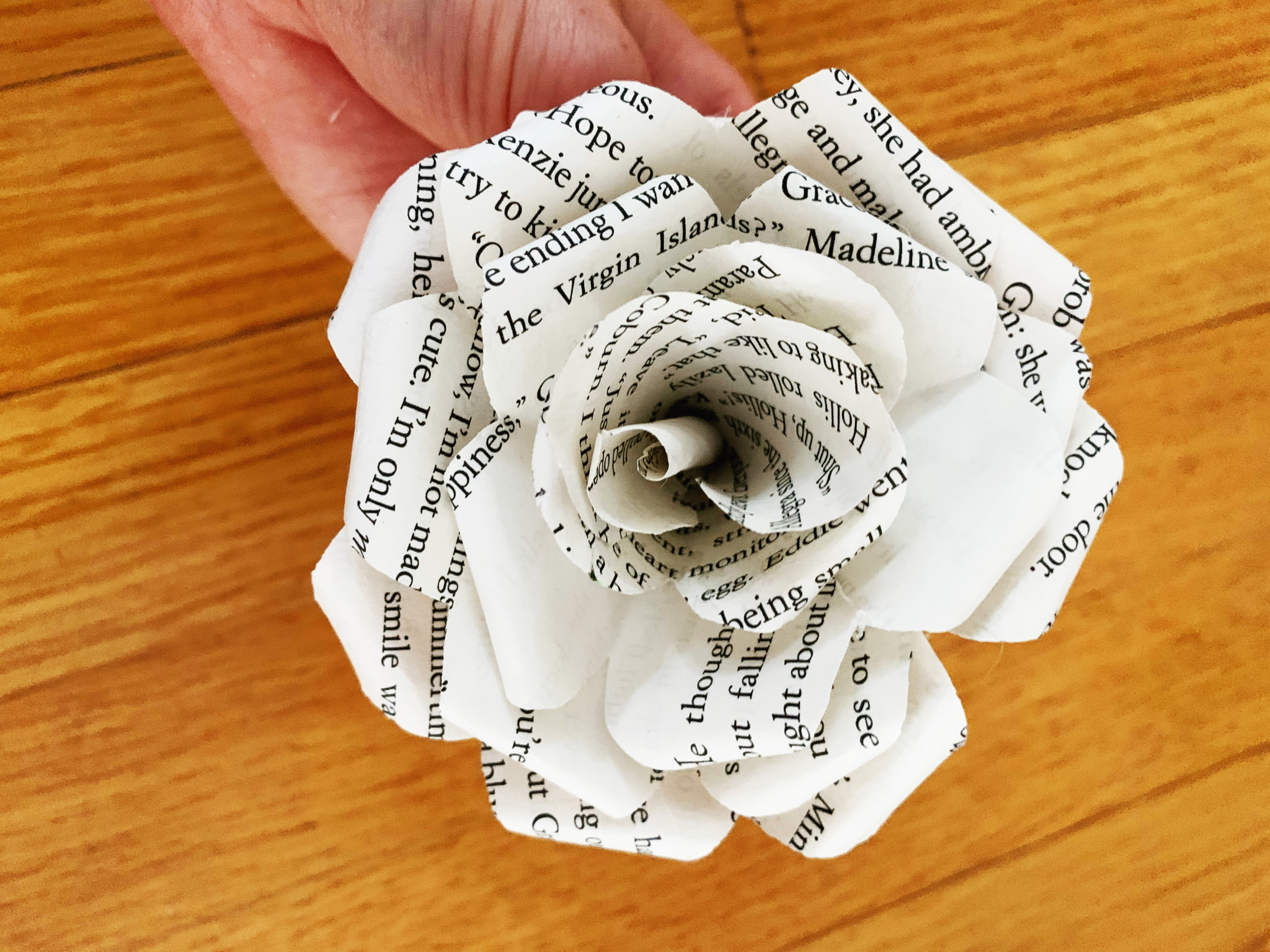
Step 9: You’re almost there! Last but not least is to add your stem. Put a decent bit of glue on the end of your chosen stem. Starting with the unglued side, stick that down through the center of your finished flower and pull it through so the glued end sits inside the flower.
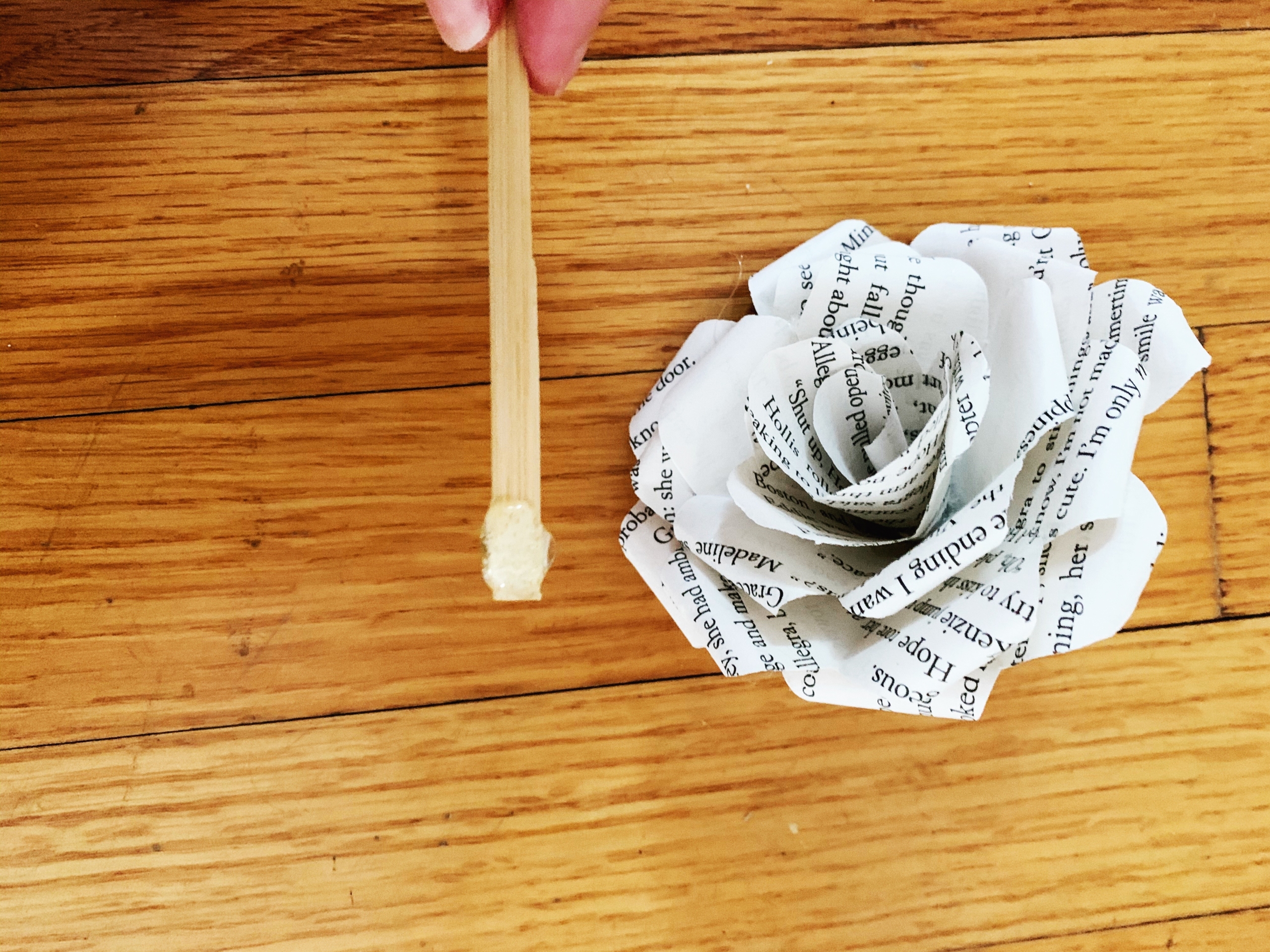
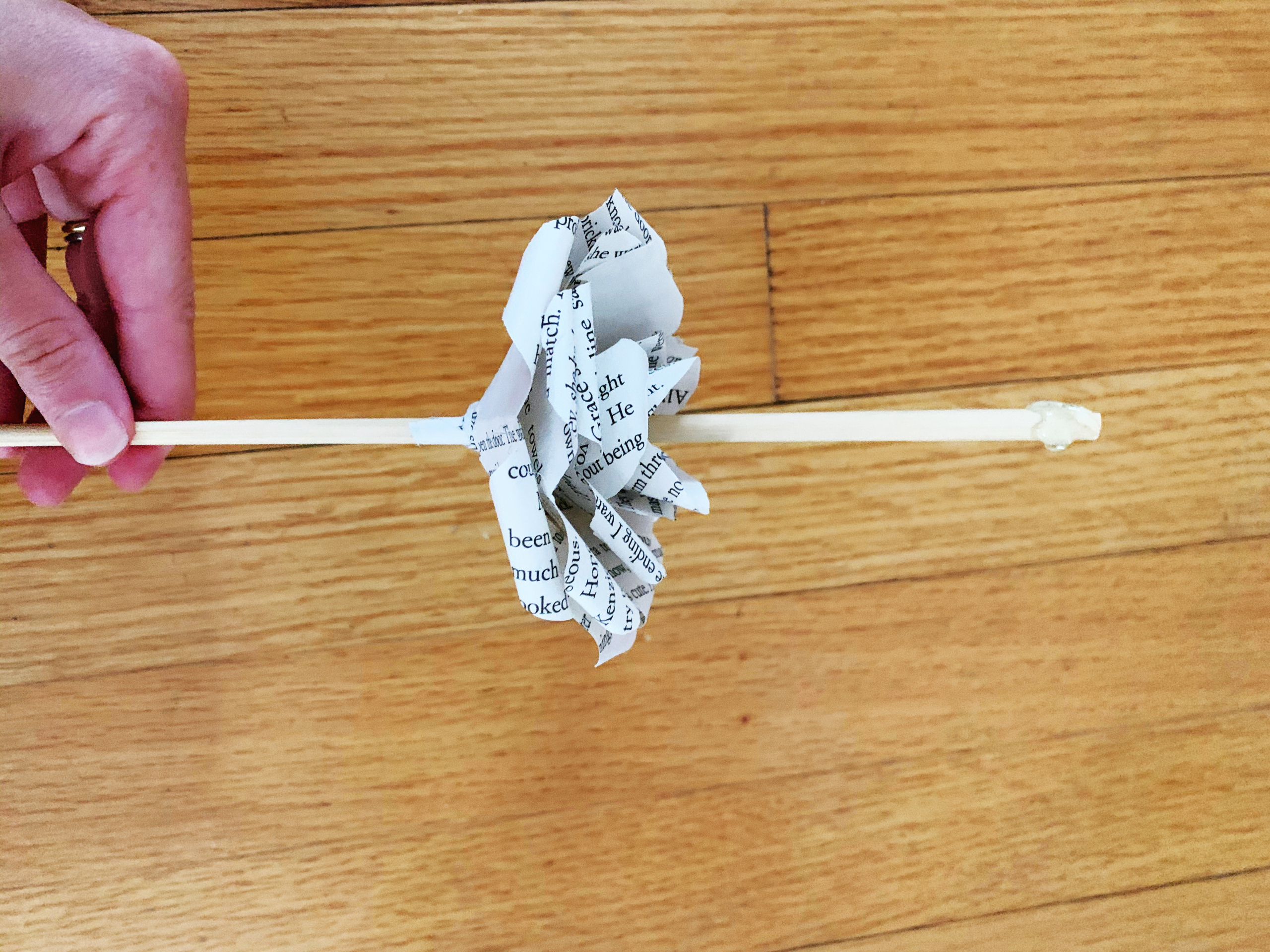
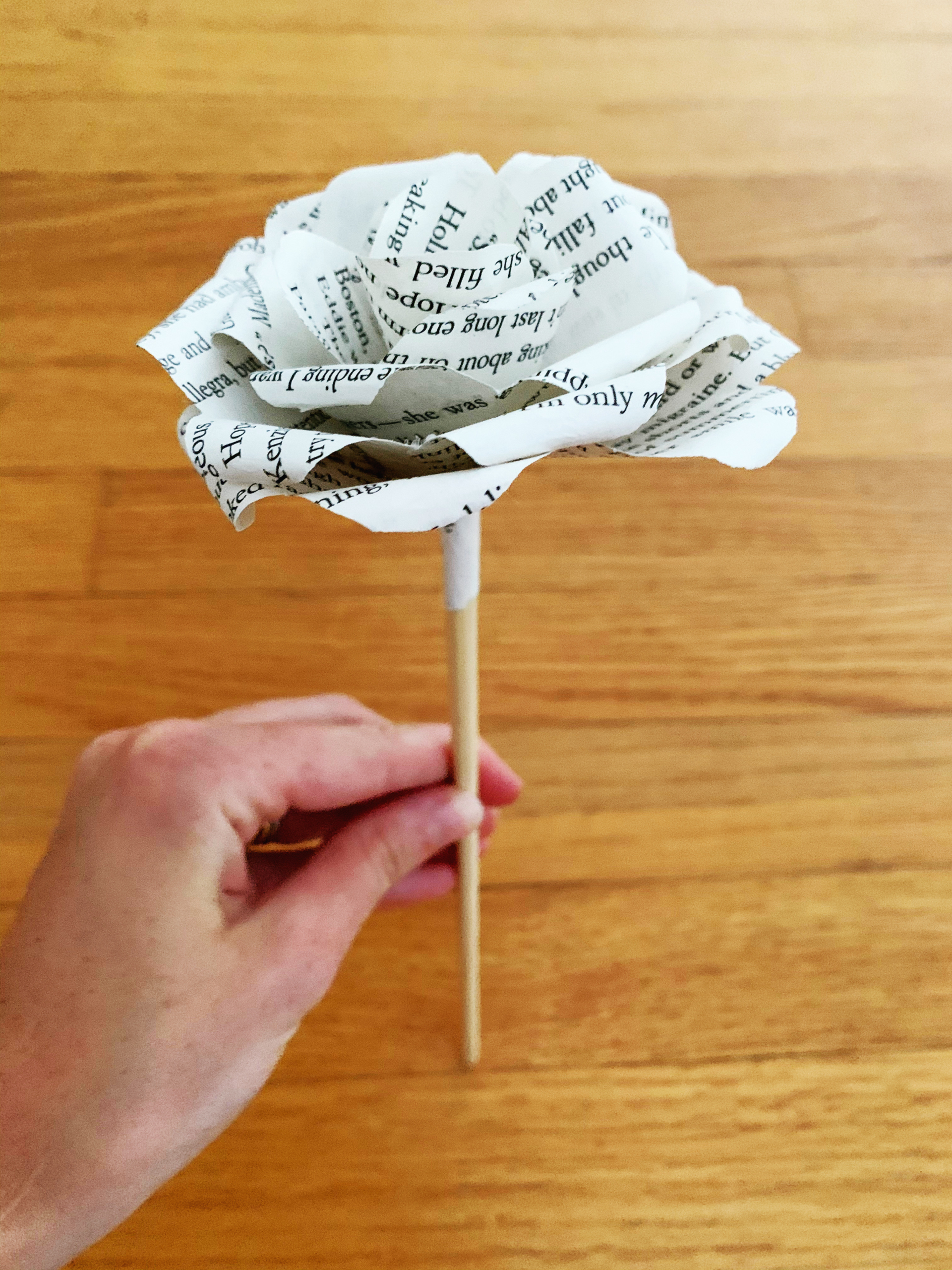
Once the glue is set, your beautiful book page rose is complete! Are there other DIY paper flowers you’d like to learn how to make? Let us know what your favorite florals are and we can add them to our list of DIY book crafts to share!
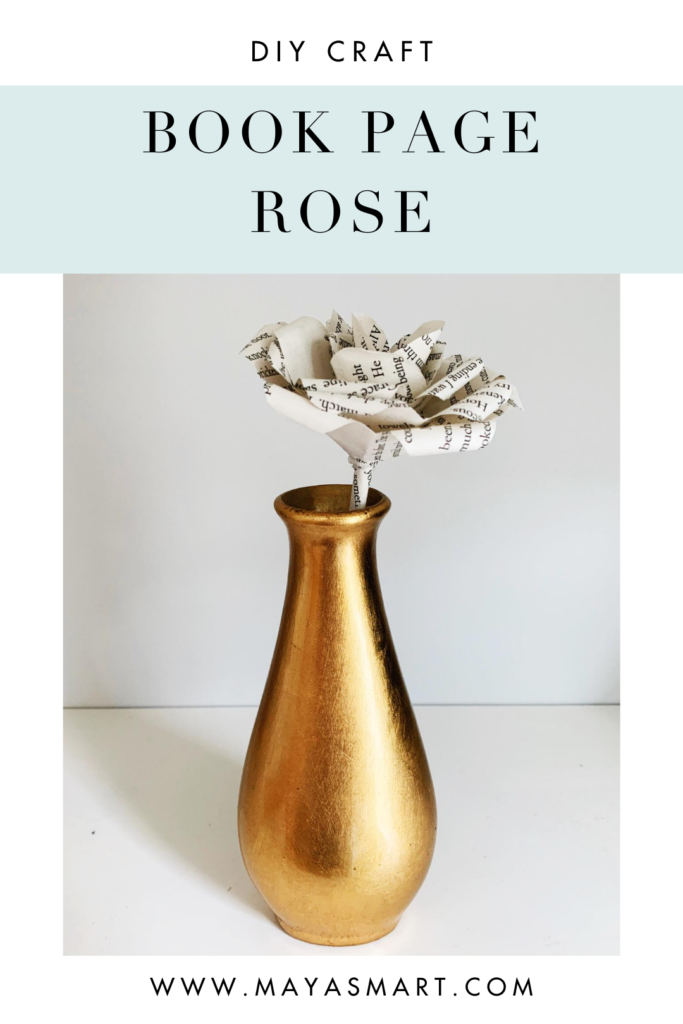
With just a little help, kids can craft these handmade book page pinwheels. This is a fun activity in its own right, plus they’ll get a new toy to boot! You can make them to keep or to gift—this is a great present for older children to make for younger siblings or friends.
Like many of our DIY book crafts, you can really make this project your own. Keep your pinwheel simple or have some fun coloring and decorating it! Younger kids may enjoy adding stickers and glitter (don’t they always?) and you can also play around with using different pencils. There are some really cute ones out there, including options for various holidays and themes! Fun idea: Shade each wing with a single color for a classic color-block look.

Materials Needed:
- Old book pages
- Wooden pencils with erasers
- Scissors
- Straight pearl sewing pins
- Needle-nose pliers
Optional:
- Colored pencils, markers, or even water colors
- Other items for decorating: stickers, glitter, feathers, or anything you have on hand
- Glue
Cost: If you have these basic supplies already on hand, this craft could cost you nothing! Needle-nose pliers are small and easy to use, but really any pliers will work to bend the sewing pin a bit, so don’t worry if you don’t have specifically needle-nose pliers. A pack of pencils should run you a few dollars, if you’re fresh out of ones with the erasers intact. And if you need to buy some straight pins, packets should start at around $4.
Step 1: Using pliers, bend pins to create a 90-degree angle, approximately 1/3 of the length up from the pin’s pointed end.
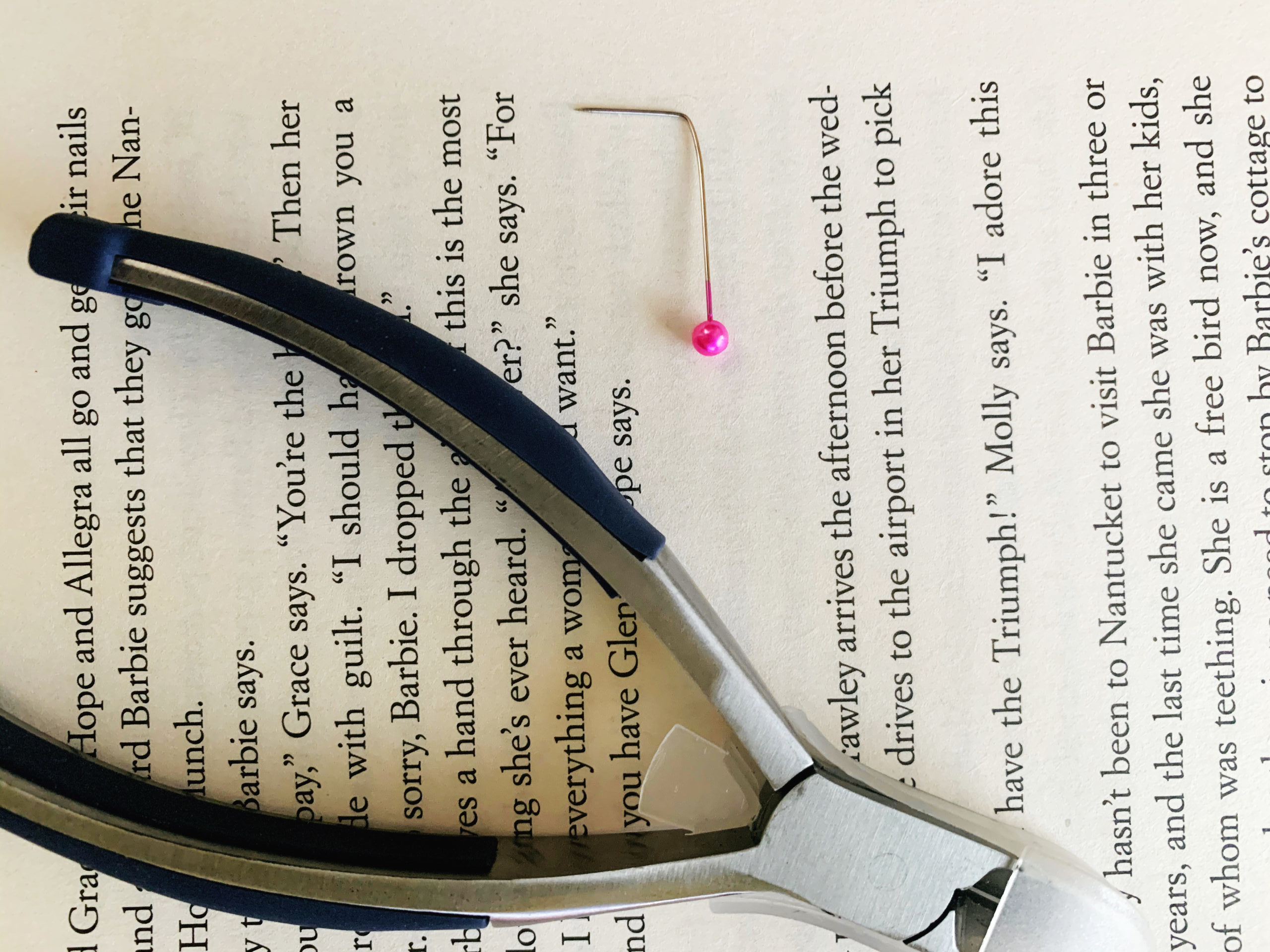
Step 2: Cut out a 4″x4″ square from a book page (you will just need one square per pinwheel).

Step 3: Make four diagonal cuts from the corners toward the paper’s center, stopping at least half an inch shy of the center. If you want to color or decorate your pinwheel, now’s the time. (Any rigid stickers will need to be added after the last step, though.) Be sure to let any paint or glue dry before the next step.
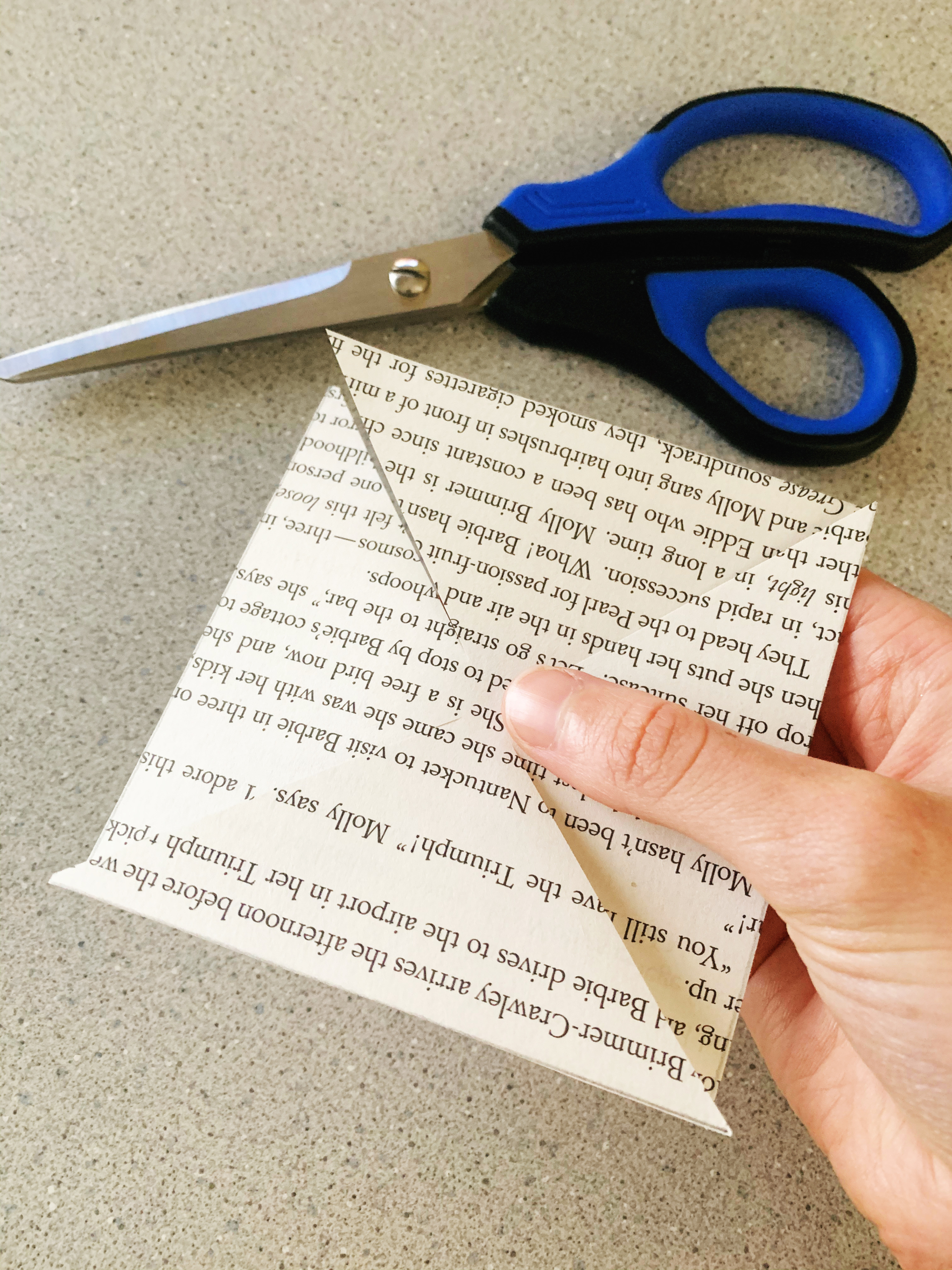
Step 4: Now, to assemble the pinwheel, fold the left point of each triangle lightly toward the center (no creasing).
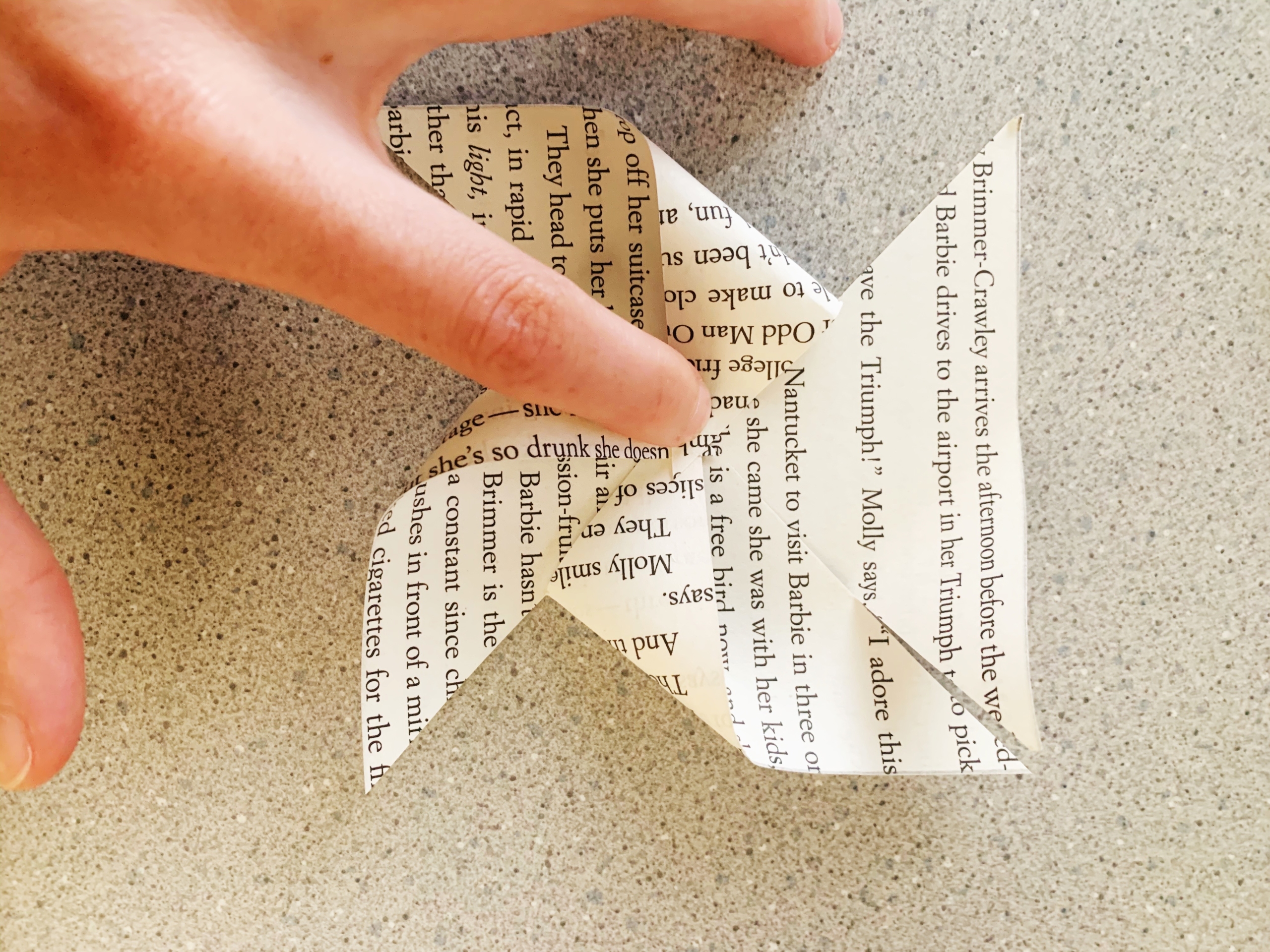

Step 5: Hold the four folded points in place while you push a pin through the center (from the front of the pinwheel towards the back), being careful to make sure that you catch all four folded corners. If you’re working with kids, you’ll probably want to do this step for them.

Step 6: Next, gently guide the paper around the bend in the pin, sliding the pinwheel out to the pin’s pearl end.
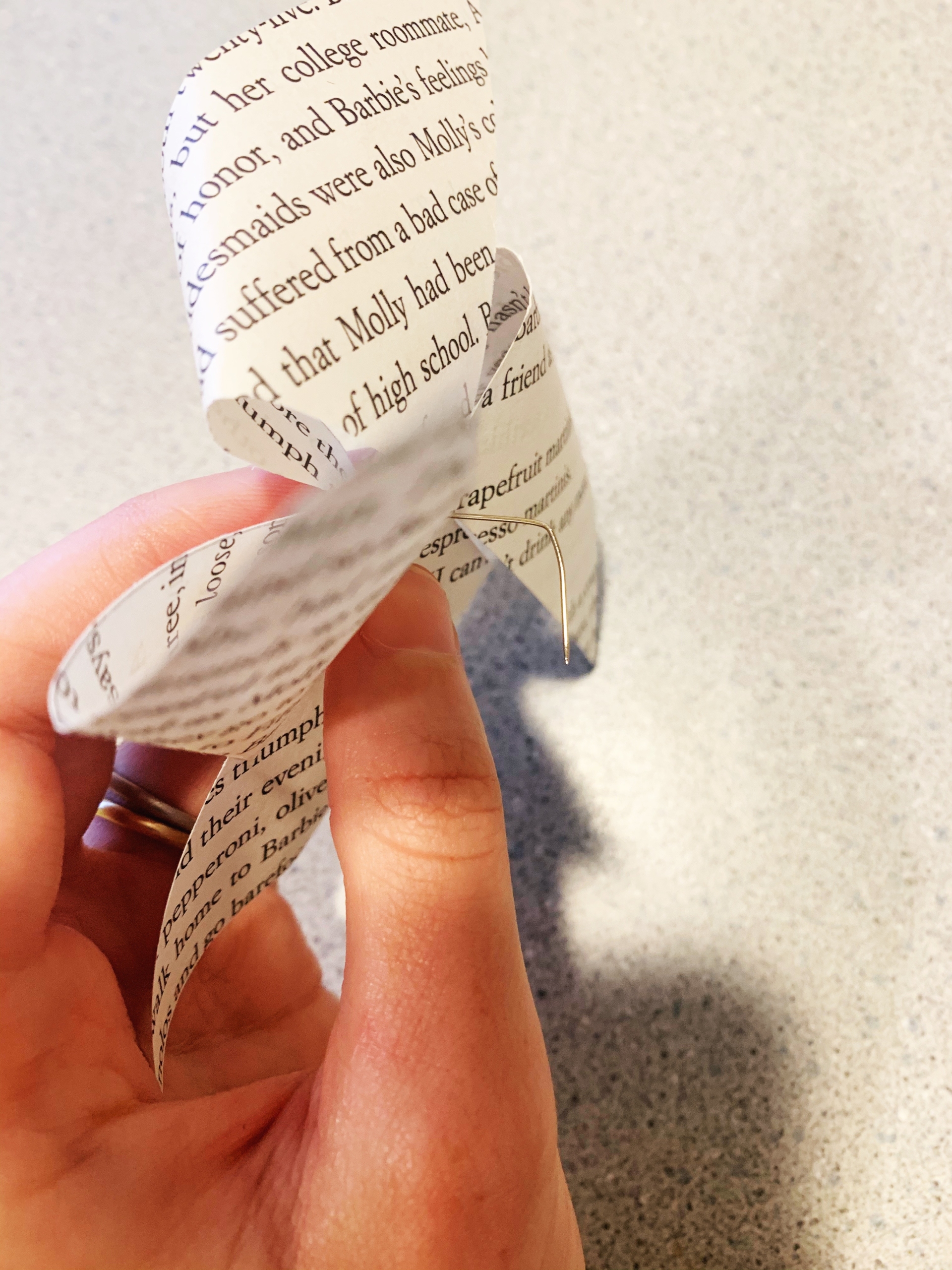
Step 7: Finally, firmly press the pin’s pointed end straight down into the pencil’s eraser.
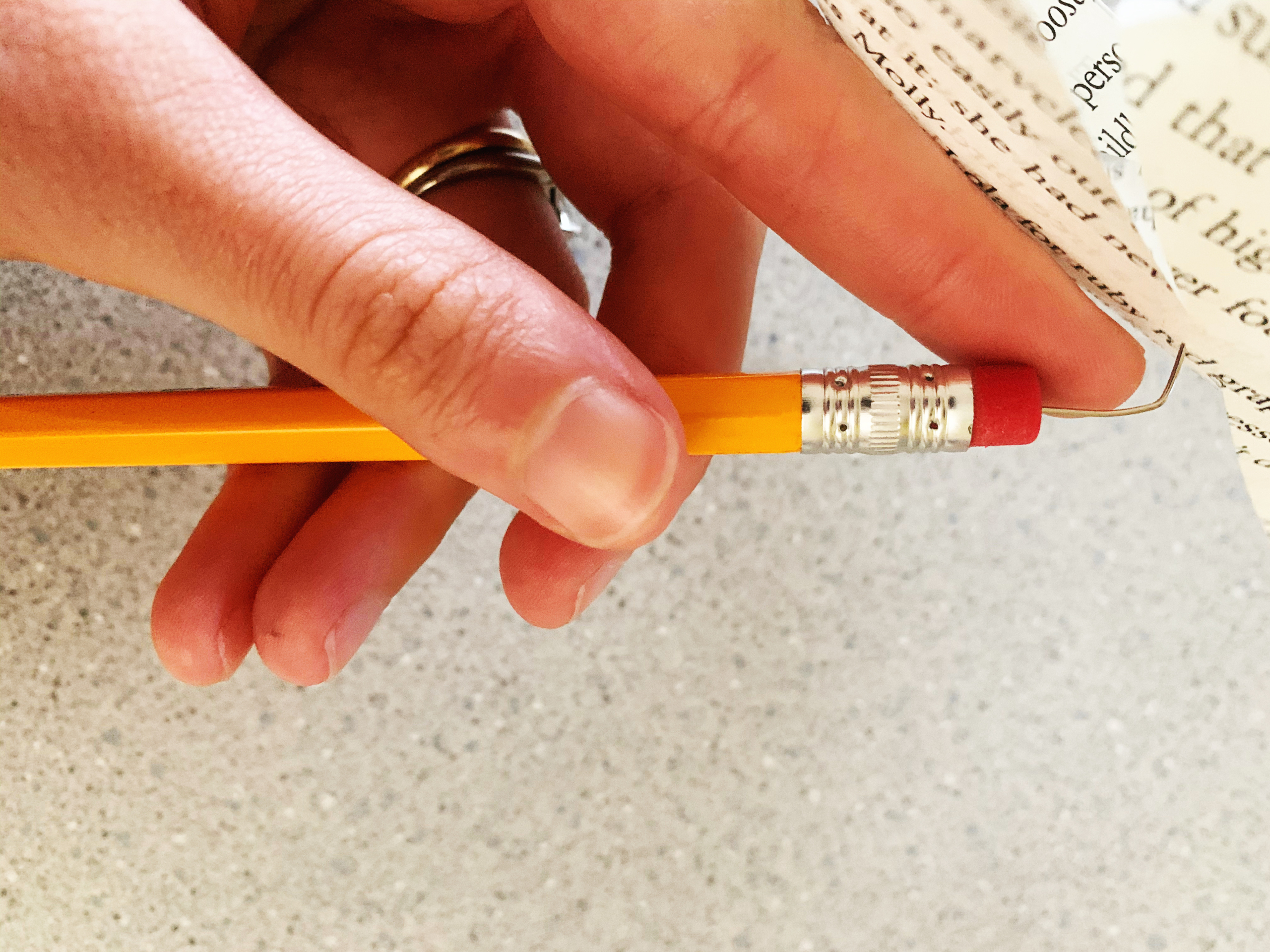
Hooray! Your pinwheel is complete—give it a spin! You can make a few of these and place them in a mason jar for a cute new table decoration, or add them to an outdoor flower pot, like I did. Kids could even make a bunch for a pinwheel parade. Have fun!

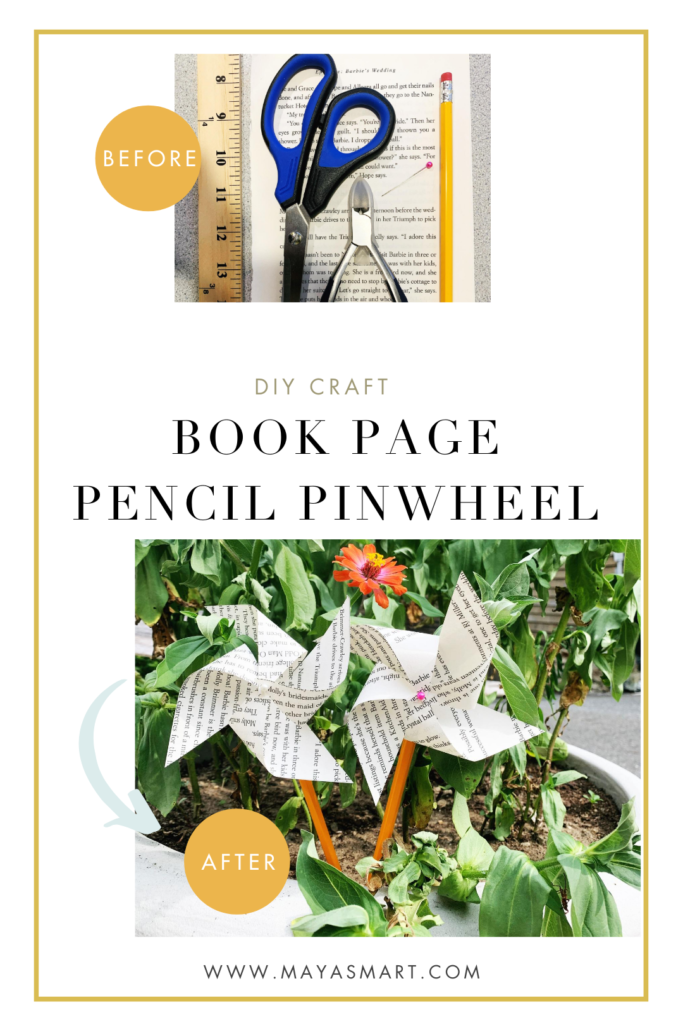
Looking for a creative way to decorate (or something to do with that falling-apart paperback)? From back-to-school to book club to birthday celebrations, you can customize this adorable DIY book page banner for any holiday or theme. It’s easy to make, yet creates a cute and polished end product.
Kids can dive right into this DIY book craft. Have them spell out their name on the banner and hang it above their bookshelf or bed. Or let them make one to celebrate a relative, friend, or favorite teacher. Whatever message you choose, this cute craft is done in no time, so it’s easy to make several for a special event or to give your daily spaces … say, that home learning “classroom” … a fun facelift.
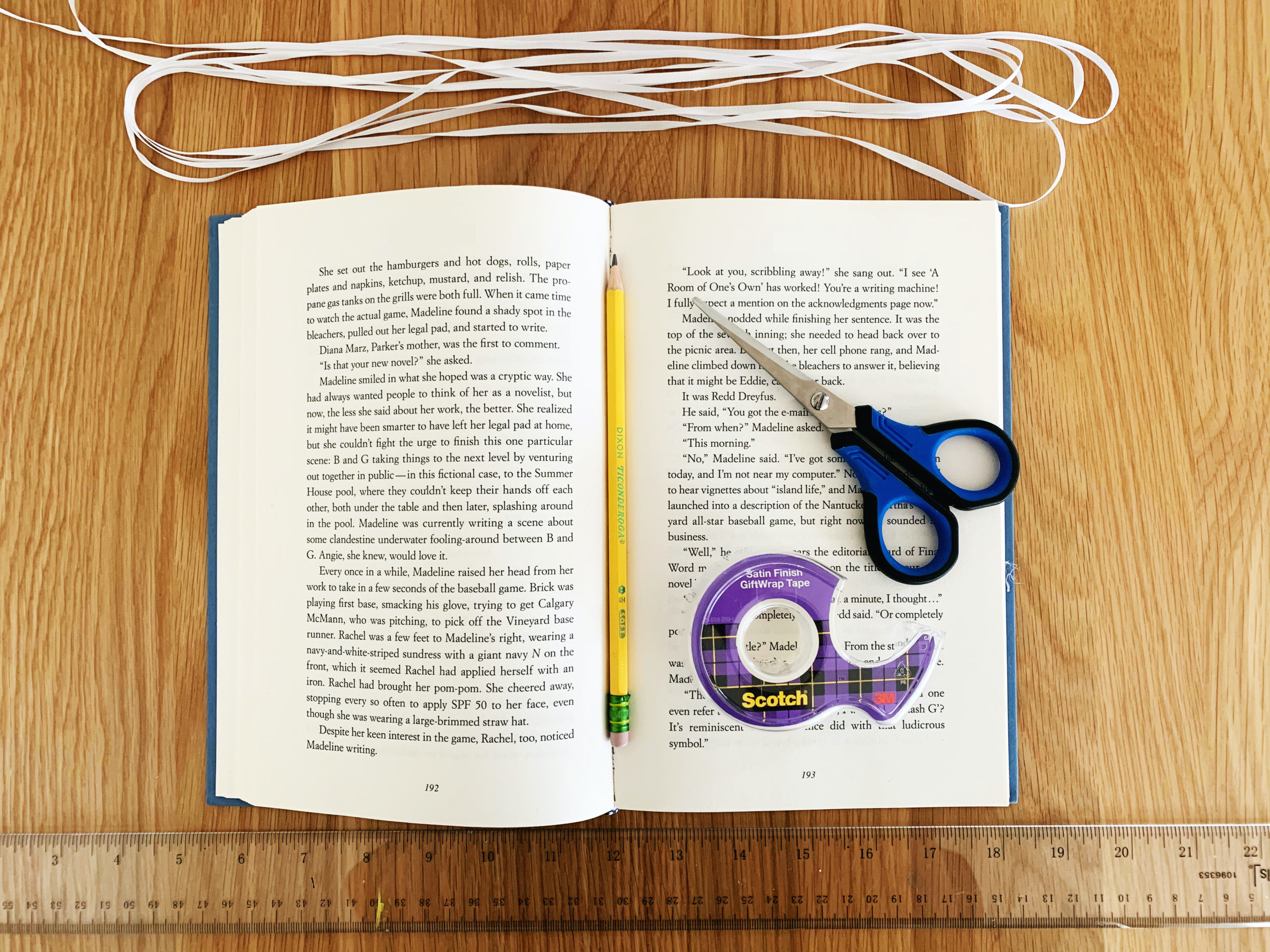
Materials:
- Old book pages
- Scrap paper (to make a template)
- Scissors
- Tape
- Pencil
- Colored pencils or markers
- Twine, yarn or ribbon
Cost: This craft should not cost you anything, provided you’ve got a few basic supplies on hand.
Step One: Step one is to make the template you will use to cut out your banner pieces from the book pages. Just draw the shape you want on some scrap paper, preferably stiffer paper or cardstock if you have it. I decided to do a cute flag shape for my banner, so I cut a 4 x 6-inch rectangle and then cut a notch in the bottom

Step Two: Decide how many flags you want and cut out the book pages. I decided I was going to spell out r-e-a-d-i-n-g, so I needed at least 7 pieces. Using your template, trace the flag on the book pages and then cut them out.
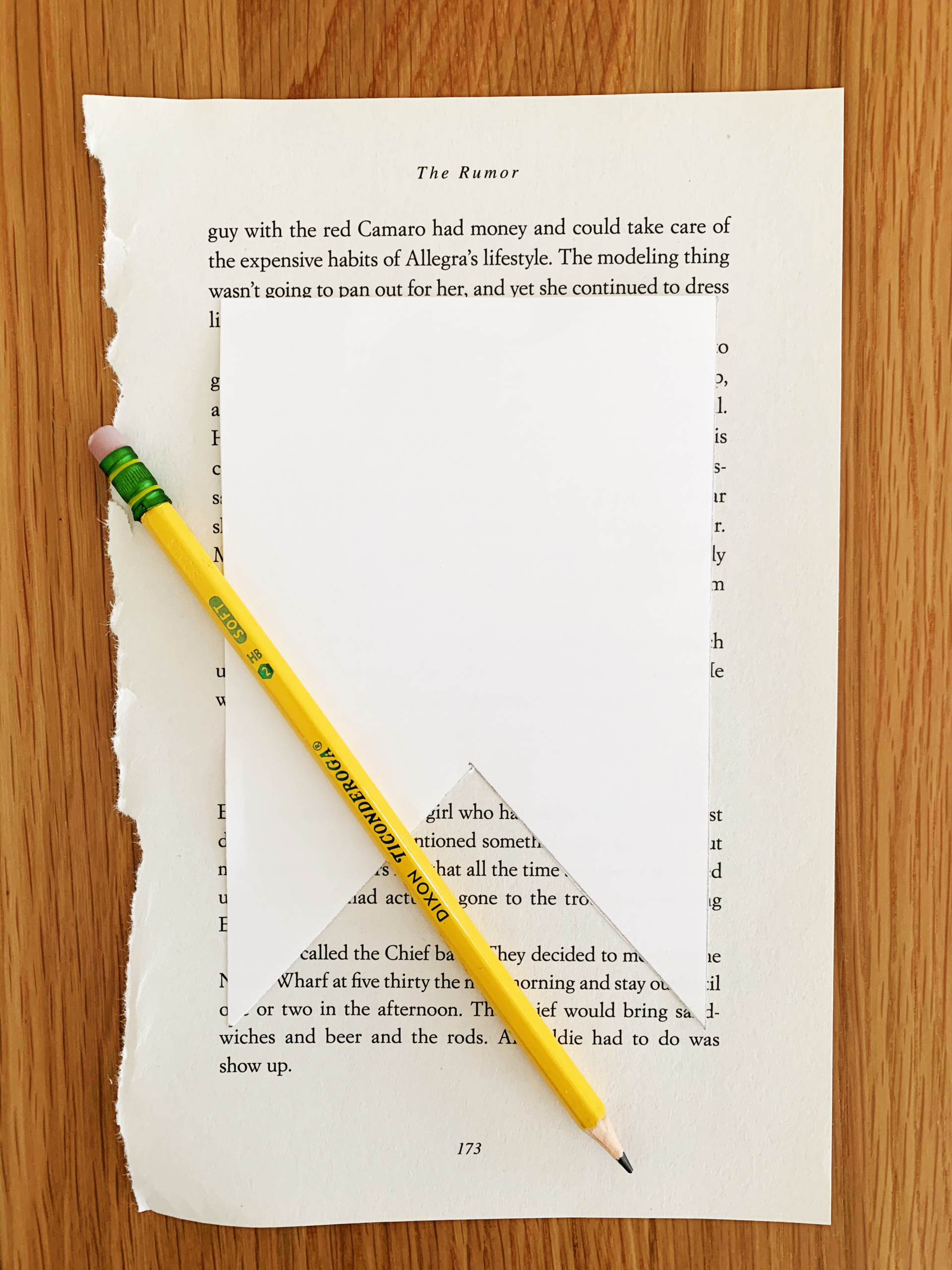

Step Three: Write the letters of your message on the banner pieces. Alternatively, you can decorate your banner pieces however you would like. (You can also just skip this step and leave the book pages as they are!)
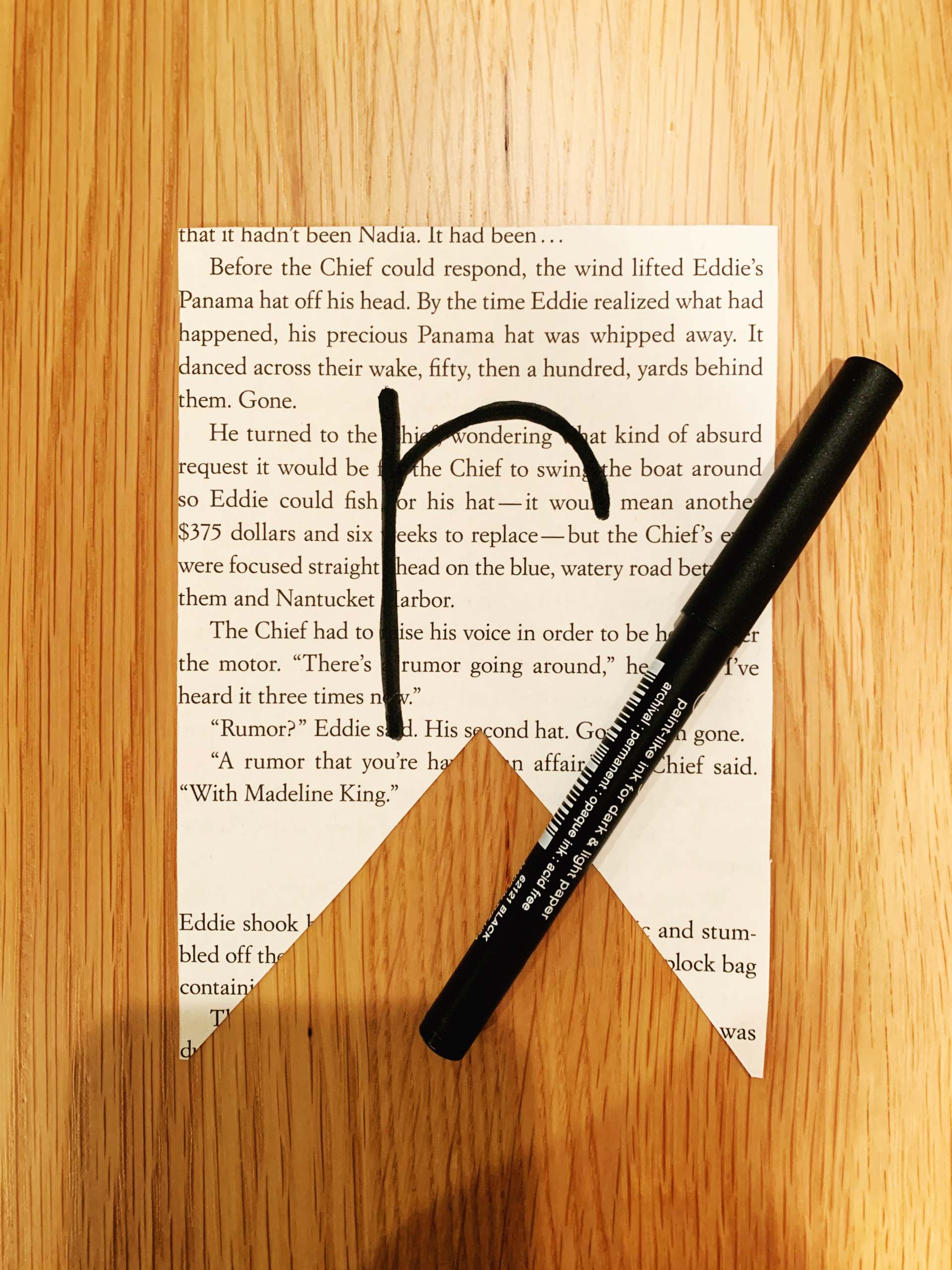
Step Four: Now you’re ready to attach the pieces to the string. Fold the top of each banner piece over (towards the back of the flag if you have decorated it), about ¼-½ inch. This is where your twine, yarn or ribbon will lay.
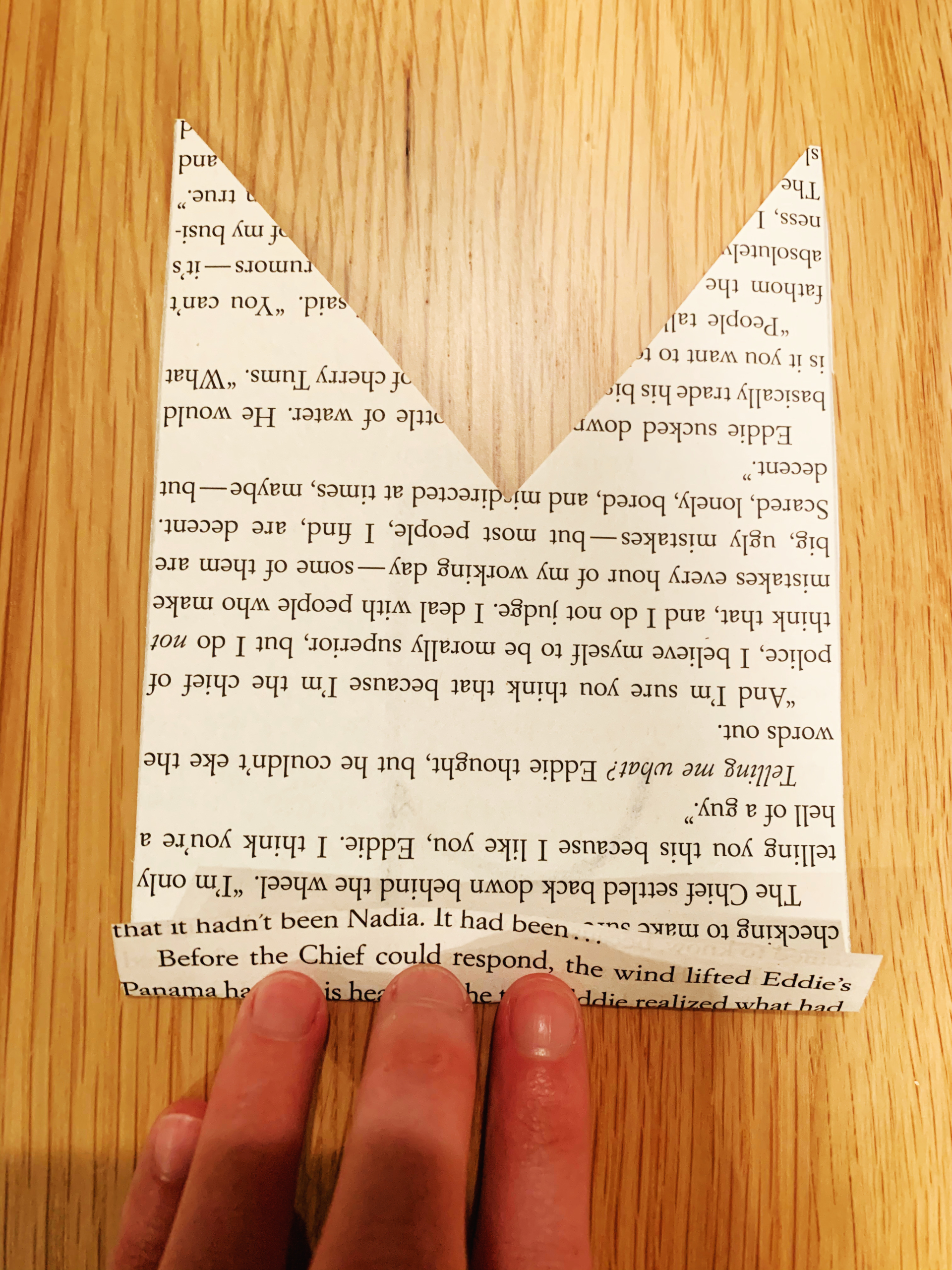
Step Five: Lastly, slip each banner piece over the string and secure the folded flap to the back of the banner piece with clear tape. That’s it. So simple! No glue and no mess. FYI, the flags will move along the string, so if you would rather they stay in place, just add a little piece of tape on top of the ribbon before you fold the flap over it.
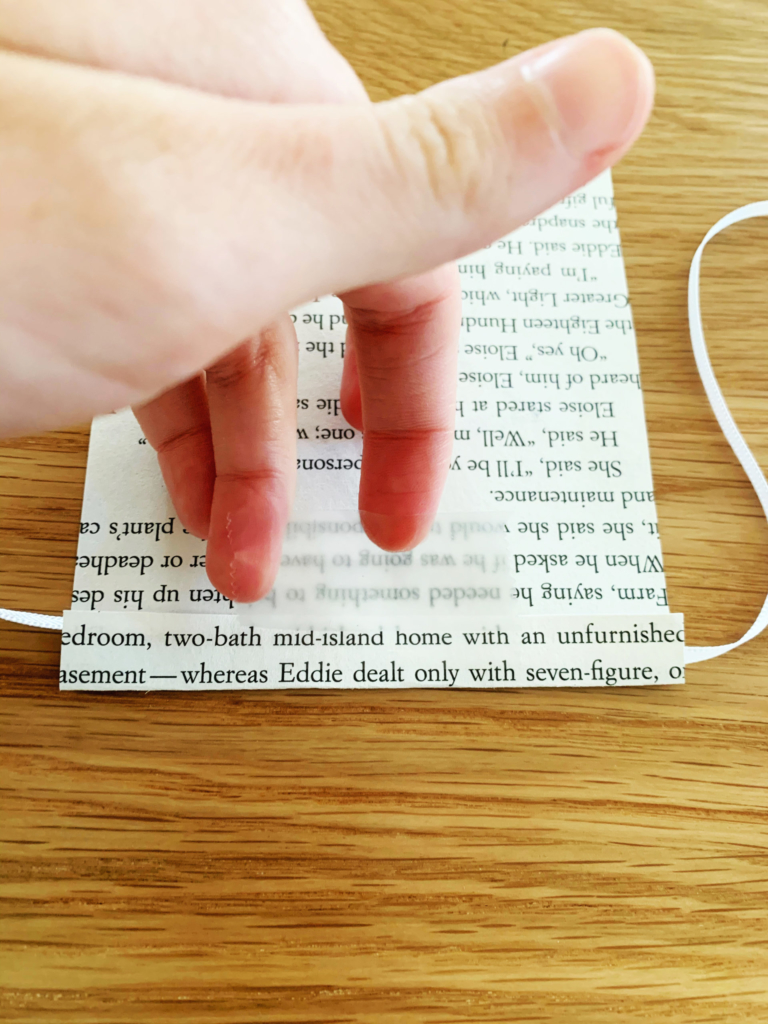
You can make your book page banner as long as you want! Just keep adding banner pieces until you’ve reached your desired length. If you are spelling a word across the banner but want it to be longer, you can add as many banner pieces to either end as you like, add a blank piece between each letter, or draw something cute like a star or heart on the in-between pieces!

Hang up your banner and enjoy this sweet and simple DIY book craft!
Cooling down on a hot summer day has never been cuter! Kids will love this fun summer book craft to create their own personal fans. Made out of upcycled book pages, these sweet paper fans are easy to make and fun to use. You can keep them simple or get as detailed as you want in coloring and decorating them. Get creative with stickers, glitter, or whatever else you have on hand. You could even glue feathers along the top of your fan!
Once your fans are finished, you can store them in a vase on a porch or patio, ready for those hot days and nights. In the meantime, they’ll make a crafty and summery centerpiece. Or take them along to keep kids (or yourself!) comfortable on outings—just compress the accordion folds and secure them lightly with a rubber band or string to keep them from getting crumpled. However you choose to use them, these book page fans are a literary way to keep your cool.
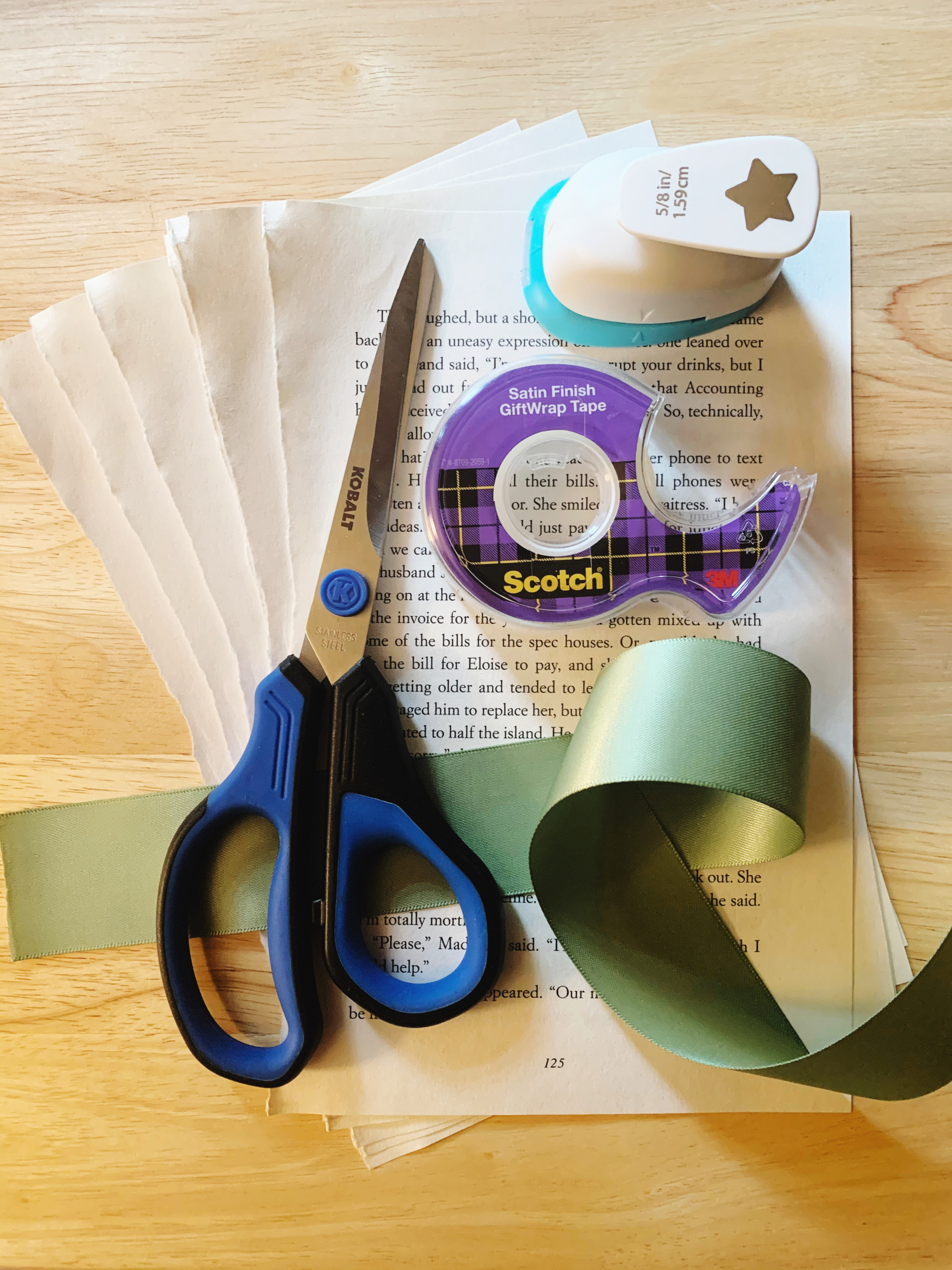
Materials:
- Old book pages (six pages per fan)
- Decorative paper punches
- Tape
- Ribbon
Optional:
- Colored pencils, markers, or even watercolors
- Other items for decorating: stickers, glitter, feathers, or anything you have on hand
- Glue
Cost: If you have these basic supplies already on hand, this craft could cost you nothing! If you need to get a decorative paper punch, you should be able to pick one up for a few dollars. It’s worth having a few on hand for future crafting. (On the other hand, you could skip the punch and just get fancy with some other crafty touches.) We can usually find a bit of ribbon around the house, but if you can’t, you can always get creative by twisting a bit of tissue wrapping paper or using several strands of colorful yarn twisted together.
Step 1: To start off, take six old book pages. Trim the side that you tore out of the book for a neater edge if need be. If you want to color the fan or decorate it with glitter or small stickers, go ahead and do that now, but leave any larger details like feathers to add after folding your fan. You only need to color or decorate one side of each page. Tip: Don’t put anything on that will make it too hard to fold the paper (e.g., no rigid stickers), and beware of tearing the thin paper of your book pages when coloring or painting them.
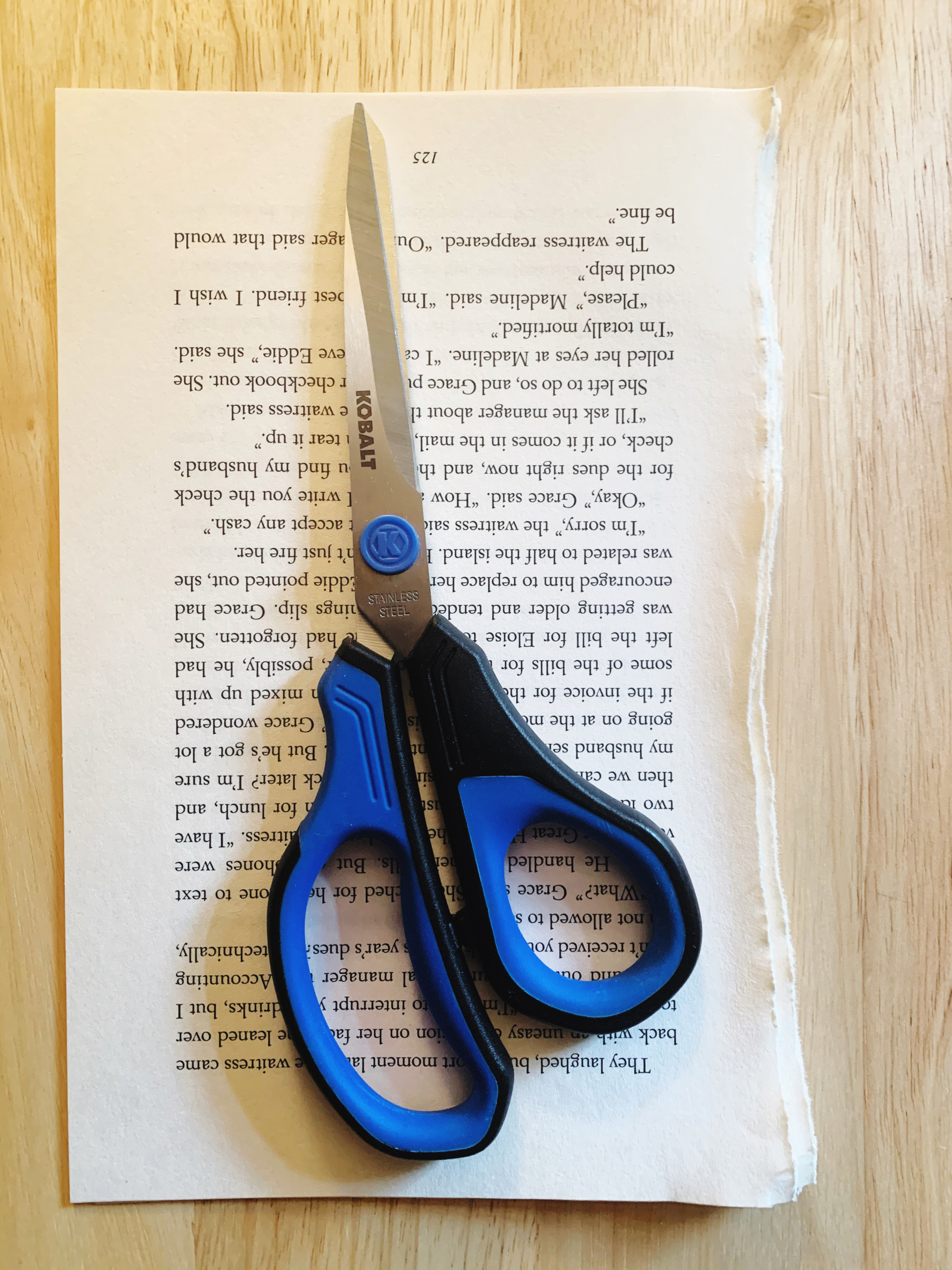
Step 2: Because book pages are usually made of pretty thin paper, we’ll make the fans a little sturdier by doubling up the paper. So, take two pages together (if you decorated the pages, have the decorated sides face out) and use your hold punch to cut a row of shapes along the top of the book pages. Repeat for the rest of the pages (three sets total of two pages each).
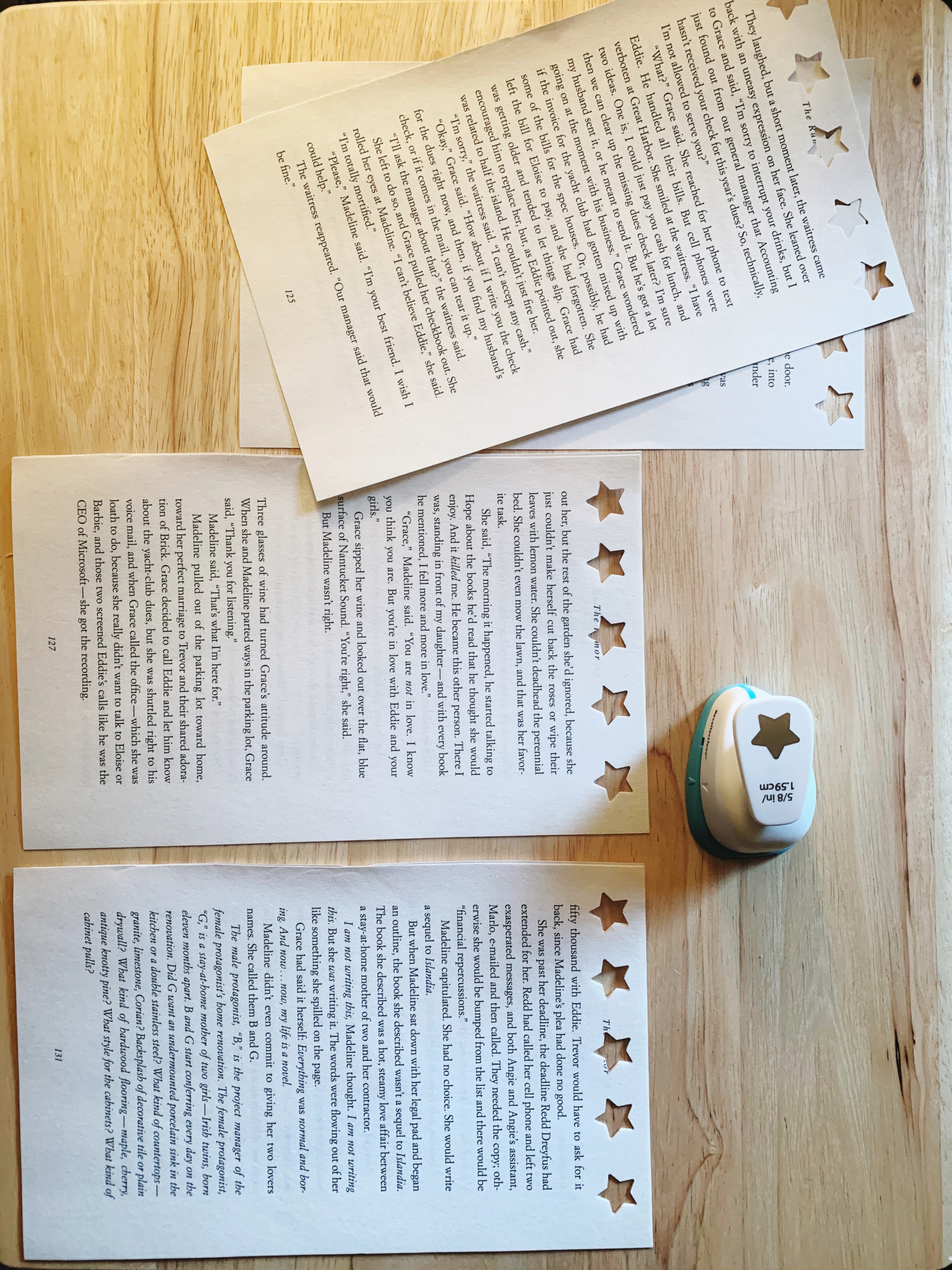
Step 3: Keeping the pair of pages together, you are now going to accordion-fold across the page horizontally. Once you’re done with this step, you will have three sets of accordion-folded double sheets.

Step 4: Now you are just going to attach these three sets together to make one larger fan. With a few small pieces of tape, attach the outermost folds together.

Step 5: Lastly, gather the fan together at the bottom edge (the one without the shapes) and tape around all the folds. Then tie a decorative ribbon to cover the tape. If you’re planning to add larger adornments such as feathers, go ahead and glue them on now.
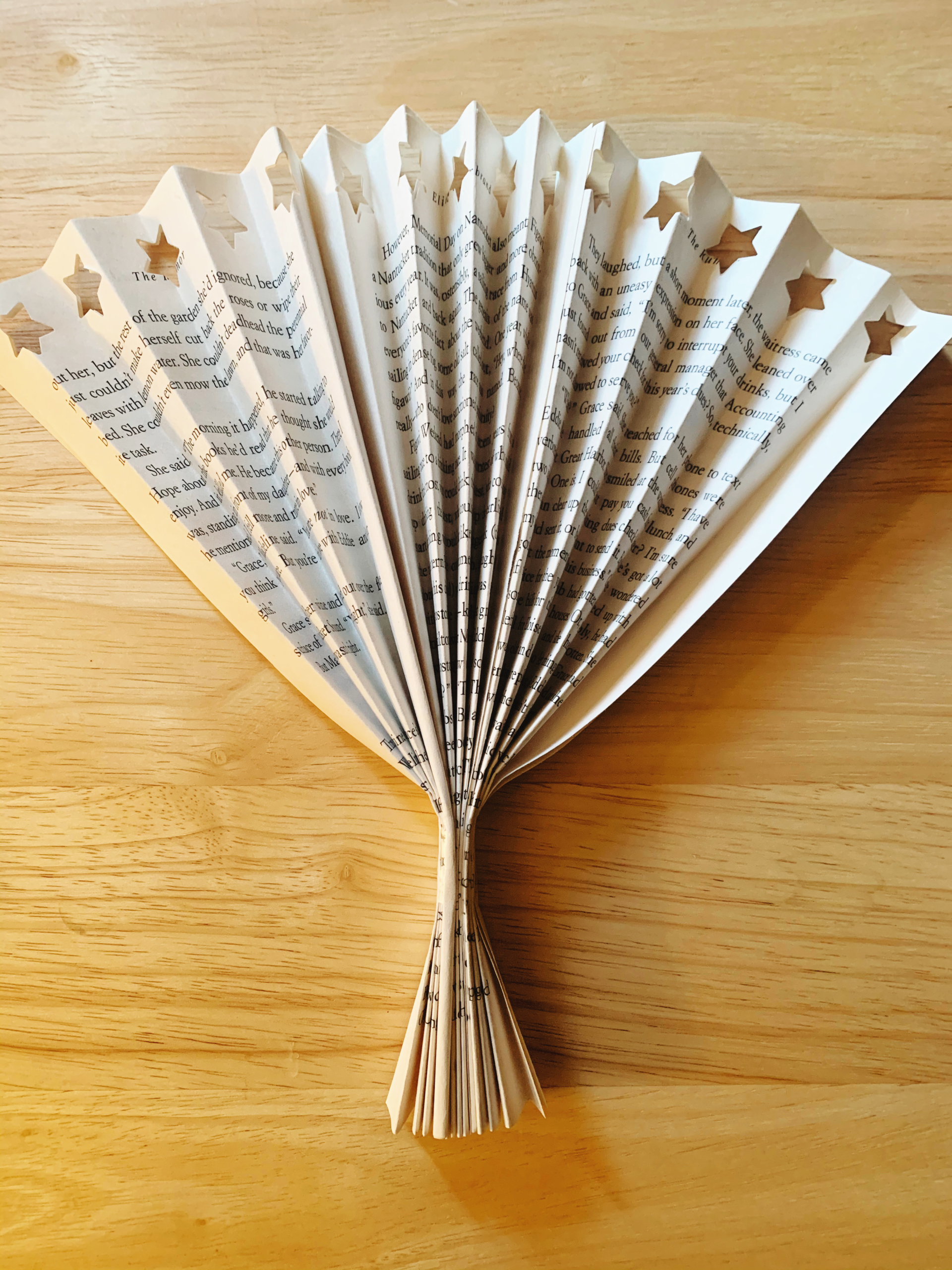
This fun and quick project is not only a crafty way to cool down on hot days, it’s also a great activity to keep kids busy (and cool!) during summer vacation. These adorable fans can even make cute favors for a summertime party. Let us know how you use yours!
Whether you’re hitting the beach with a vacation paperback or encouraging your kids through their summer reading lists, a bookmark is a must. Having a page-marker handy helps keep kids (or you!) from folding over the corners of those library and school books—or creasing up your home-library favorites. And these slide-on DIY corner bookmarks don’t get knocked out when you toss your book into a tote, the way traditional bookmarks can.
Make these cute pocket bookmarks with just some squares of paper and a little origami. Then decorate them however you like. This book craft is great for kids and all ages. Follow along the simple steps below and you’ll have a bookmark that fits right over the corner of your page in no time! Once you or your crafters get the folding down, you can churn out as many designs as you like. Fruit salad, anyone?
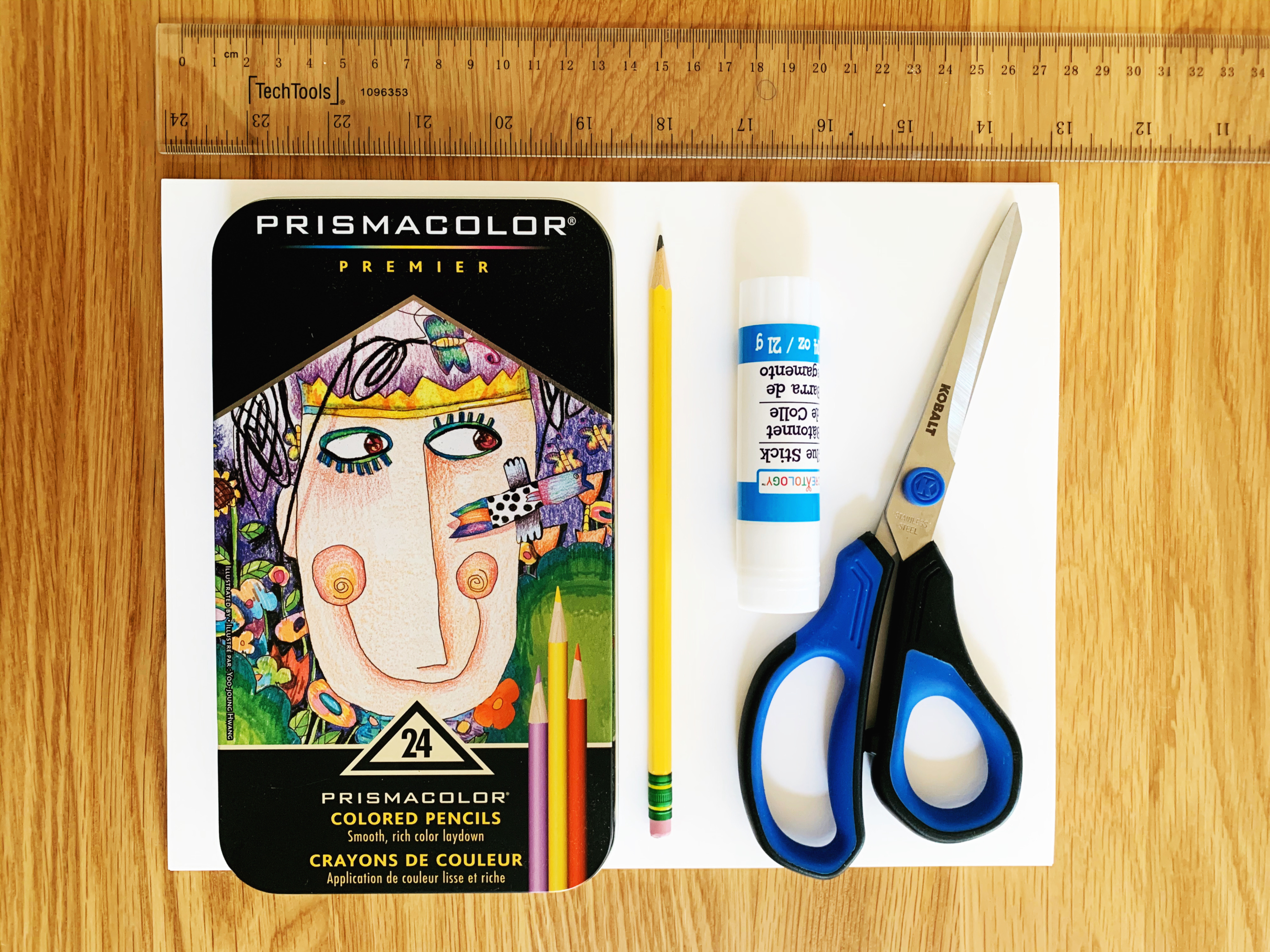
Materials:
- Craft paper
- Scissors
- Craft glue
- Pencil
- Colored pencils or markers
Cost: This craft should not cost you anything, provided you’ve got a few basic supplies on hand.
Step One: First you need to cut out squares to make your bookmarks. You will need one square for each bookmark. I made mine 5” x 5”. You could go bigger than this, but I wouldn’t go any smaller!

Step Two: Now we will start folding to make your first bookmark! These folds are pretty simple, so just follow along. First, fold in half, making a triangle.

Step Three: Take the top point of the triangle (just the top layer!) and fold it down towards the bottom.

Step Four: Fold the bottom left corner up to the top point of the triangle.

Step Five: Now do the same with the right corner of the triangle, once again matching it with the top of the triangle.

Step Six: You will now just take those points and fold them back down to the bottom, making a crease in the middle. Once you have the crease made, fold the paper back in the other direction, slipping it into the pocket created by the fold in Step Three.




Step Seven: Now for the fruit shapes: Take a spare piece of paper and trace the corner of the pocket you just created. You will just need to trace the bottom part. Once you have that drawn, just connect the two points with an arch to create your fruit slice!


Step Eight: And now it’s time for the fun part! Take your colored pencils or markers and color the shape you just cut out. You can follow along with my color patterns or create your own. I made a lime, a watermelon, and an orange.
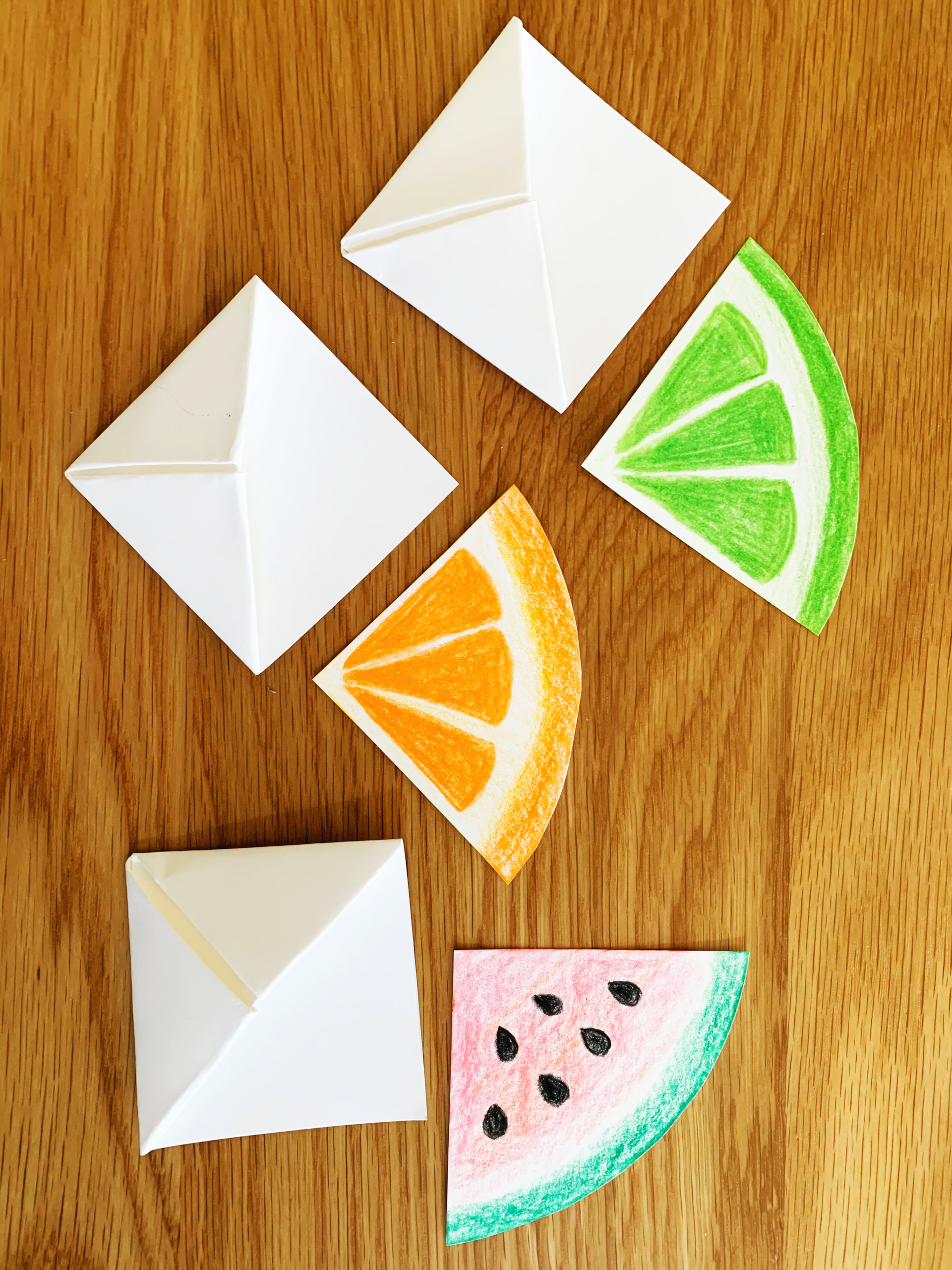
Step Nine: Once you are done coloring, it’s time to attach your fruit shapes to the folded square. Take your glue stick and apply glue to the outside of the pocket. Then line up the pointed corner of your fruit and attach it to the outside part of the pocket.
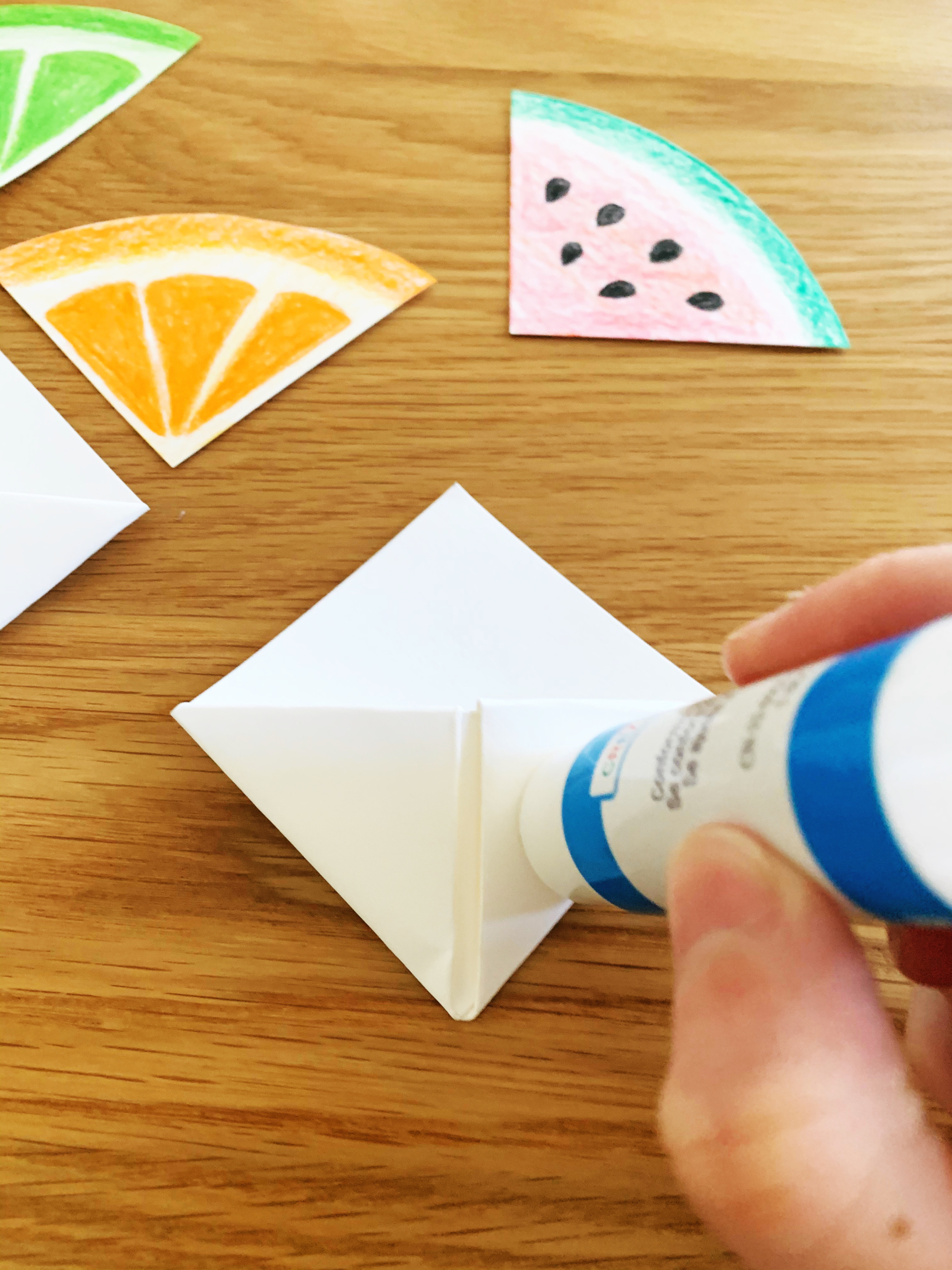
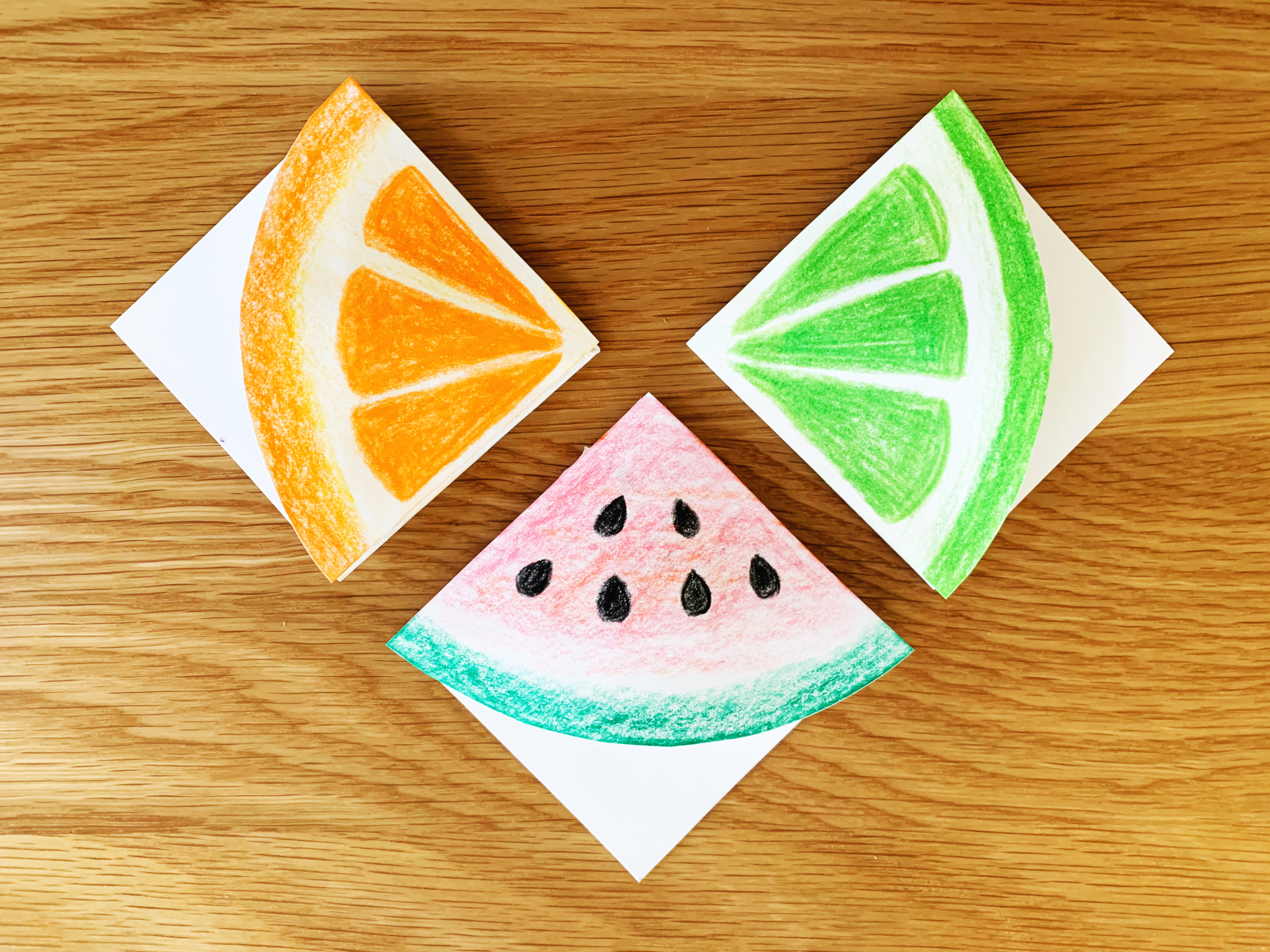
That’s it! Now you are ready to kick off your summer reading with these cute bookmarks. Let us know how you decided to decorate your bookmarks. I can think of a few other fruits we could add to our collection!
